

Table of SynGAP1 Isoform α2 (UniProt Q96PV0-1) Missense Variants.
| c.dna | Variant | SGM Consensus | Domain | ClinVar | gnomAD | ESM1b | AlphaMissense | REVEL | FoldX | Rosetta | Foldetta | PremPS | PROVEAN | PolyPhen-2 HumDiv | PolyPhen-2 HumVar | FATHMM | SIFT | PAM | Physical | SASA | Normalized B-factor backbone | Normalized B-factor sidechain | SynGAP Structural Annotation | DOI | |||||||||||||||||||||||||||||||||
|---|---|---|---|---|---|---|---|---|---|---|---|---|---|---|---|---|---|---|---|---|---|---|---|---|---|---|---|---|---|---|---|---|---|---|---|---|---|---|---|---|---|---|---|---|---|---|---|---|---|---|---|---|---|---|---|---|---|
| Clinical Status | Review | Subm. | ID | Allele count | Allele freq. | LLR score | Prediction | Pathogenicity | Class | Optimized | Score | Prediction | Average ΔΔG | Prediction | StdDev | ΔΔG | Prediction | ΔΔG | Prediction | ΔΔG | Prediction | Score | Prediction | pph2_prob | Prediction | pph2_prob | Prediction | Nervous System Score | Prediction | Prediction | Status | Conservation | Sequences | PAM250 | PAM120 | Hydropathy Δ | MW Δ | Average | Δ | Δ | StdDev | Δ | StdDev | Secondary | Tertiary bonds | Inside out | GAP-Ras interface | At membrane | No effect | MD Alert | Verdict | Description | |||||
| c.2294G>A | S765N 2D 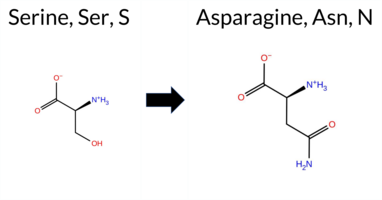 AIThe SynGAP1 missense variant S765N (ClinVar ID 2979632.0) is listed as “Uncertain” in ClinVar and is not reported in gnomAD. Functional prediction tools that agree on a benign effect include REVEL, PROVEAN, SIFT, ESM1b, FATHMM, AlphaMissense‑Optimized, and the SGM‑Consensus score (Likely Benign). In contrast, PolyPhen‑2 (HumDiv and HumVar) predict a pathogenic impact. High‑accuracy assessments further support a benign interpretation: AlphaMissense‑Optimized is benign, and the SGM‑Consensus (majority vote from AlphaMissense‑Default, ESM1b, FATHMM, PROVEAN) is also benign. No Foldetta stability prediction is available, so it does not influence the assessment. Overall, the majority of evidence points to a benign effect, which is consistent with the ClinVar “Uncertain” classification and does not contradict it. Disclaimer: This summary was generated using AI and should be interpreted alongside expert review. | Likely Benign | Uncertain | 1 | -5.098 | Likely Benign | 0.378 | Ambiguous | Likely Benign | 0.094 | Likely Benign | -0.94 | Neutral | 0.985 | Probably Damaging | 0.950 | Probably Damaging | 4.11 | Benign | 0.06 | Tolerated | 3.64 | 6 | 1 | 1 | -2.7 | 27.03 | ||||||||||||||||||||||||||||||
| c.2924C>T | T975I 2D 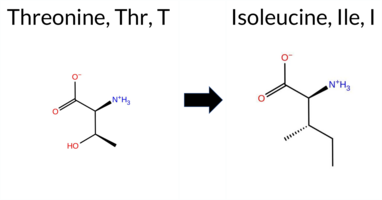 AIThe SynGAP1 missense variant T975I is listed in ClinVar with an “Uncertain” status and is present in the gnomAD database (ID 6‑33443476‑C‑T). Prediction tools that agree on benign impact include REVEL, PROVEAN, polyPhen‑2 (HumDiv and HumVar), SIFT, ESM1b, FATHMM, AlphaMissense‑Default, and AlphaMissense‑Optimized; no tool predicts pathogenicity. The SGM‑Consensus, derived from a majority vote of AlphaMissense‑Default, ESM1b, FATHMM, and PROVEAN, also reports a “Likely Benign” classification. High‑accuracy assessments show AlphaMissense‑Optimized as benign and the SGM‑Consensus as likely benign, while Foldetta (combining FoldX‑MD and Rosetta outputs) has no available result for this variant. Overall, the computational evidence overwhelmingly supports a benign effect, which does not contradict the ClinVar “Uncertain” designation. Disclaimer: This summary was generated using AI and should be interpreted alongside expert review. | Likely Benign | Uncertain | 1 | 6-33443476-C-T | 6 | 3.72e-6 | -3.912 | Likely Benign | 0.164 | Likely Benign | Likely Benign | 0.068 | Likely Benign | -1.66 | Neutral | 0.411 | Benign | 0.239 | Benign | 4.11 | Benign | 0.66 | Tolerated | 4.32 | 2 | 0 | -1 | 5.2 | 12.05 | |||||||||||||||||||||||||||
| c.2971G>A | G991R 2D 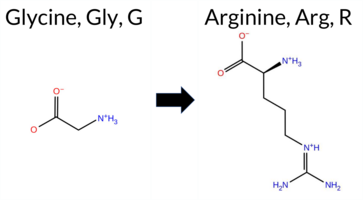 AIThe SynGAP1 missense variant G991R is listed in ClinVar (ID 1029090.0) with an “Uncertain” status and is present in gnomAD (variant ID 6‑33443523‑G‑A). Prediction tools that agree on a benign effect include REVEL, PROVEAN, ESM1b, FATHMM, AlphaMissense‑Optimized, and the SGM‑Consensus score (Likely Benign). Tools that predict a pathogenic effect are polyPhen‑2 HumDiv, polyPhen‑2 HumVar, and SIFT. AlphaMissense‑Default remains uncertain. High‑accuracy assessments show AlphaMissense‑Optimized as benign and the SGM‑Consensus (majority vote from AlphaMissense‑Default, ESM1b, FATHMM, PROVEAN) also benign; Foldetta results are unavailable. Overall, the majority of evidence points to a benign impact, and this conclusion does not contradict the ClinVar “Uncertain” classification. Disclaimer: This summary was generated using AI and should be interpreted alongside expert review. | Likely Benign | Conflicting | 3 | 6-33443523-G-A | 8 | 4.96e-6 | -3.934 | Likely Benign | 0.411 | Ambiguous | Likely Benign | 0.102 | Likely Benign | -1.20 | Neutral | 0.984 | Probably Damaging | 0.772 | Possibly Damaging | 4.11 | Benign | 0.01 | Affected | 4.32 | 2 | -3 | -2 | -4.1 | 99.14 | |||||||||||||||||||||||||||
| c.13C>G | R5G 2D 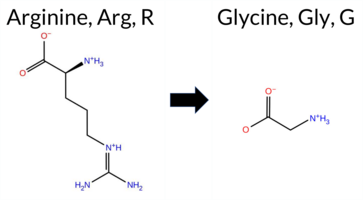 AIThe SynGAP1 missense variant R5G is listed in ClinVar with an “Uncertain” status and is not reported in gnomAD. Prediction tools that indicate a benign effect include REVEL, PROVEAN, polyPhen‑2 (HumDiv and HumVar), ESM1b, FATHMM, AlphaMissense‑Default, AlphaMissense‑Optimized, and the SGM‑Consensus (Likely Benign). Only SIFT predicts a pathogenic outcome. High‑accuracy assessments show AlphaMissense‑Optimized as benign and the SGM Consensus (majority vote of AlphaMissense‑Default, ESM1b, FATHMM, PROVEAN) also as benign; Foldetta results are unavailable. Overall, the majority of evidence points to a benign impact, and this conclusion does not contradict the ClinVar “Uncertain” classification. Disclaimer: This summary was generated using AI and should be interpreted alongside expert review. | Likely Benign | Uncertain | 1 | -3.639 | Likely Benign | 0.150 | Likely Benign | Likely Benign | 0.169 | Likely Benign | -0.16 | Neutral | 0.013 | Benign | 0.003 | Benign | 4.12 | Benign | 0.00 | Affected | 4.32 | 1 | -2 | -3 | 4.1 | -99.14 | ||||||||||||||||||||||||||||||
| c.140G>A | R47Q 2D  AIThe SynGAP1 missense variant R47Q is listed in ClinVar (ID 436920.0) as Benign and is present in gnomAD (6‑33423549‑G‑A). Prediction tools that agree on a benign effect include REVEL, PROVEAN, ESM1b, FATHMM, AlphaMissense‑Optimized, and the SGM‑Consensus (majority vote from AlphaMissense‑Default, ESM1b, FATHMM, PROVEAN). Tools that predict a pathogenic effect are polyPhen‑2 HumDiv, polyPhen‑2 HumVar, and SIFT. AlphaMissense‑Default is uncertain, and Foldetta results are unavailable. High‑accuracy assessments show AlphaMissense‑Optimized as Benign, the SGM‑Consensus as Benign, and no Foldetta data to influence the conclusion. Overall, the majority of evidence points to a benign impact, consistent with the ClinVar classification; there is no contradiction with the reported ClinVar status. Disclaimer: This summary was generated using AI and should be interpreted alongside expert review. | Likely Benign | Likely Benign | 1 | 6-33423549-G-A | 4 | 2.48e-6 | -4.989 | Likely Benign | 0.347 | Ambiguous | Likely Benign | 0.096 | Likely Benign | -0.57 | Neutral | 0.829 | Possibly Damaging | 0.614 | Possibly Damaging | 4.12 | Benign | 0.00 | Affected | 4.32 | 1 | 1 | 1 | 1.0 | -28.06 | 10.1016/j.ajhg.2020.11.011 | ||||||||||||||||||||||||||
| c.182A>C | E61A 2D 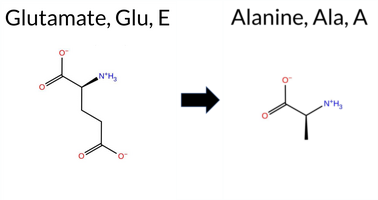 AIThe SynGAP1 missense variant E61A is listed in ClinVar (ID 3767543.0) with an *Uncertain* clinical significance and is not reported in gnomAD. Functional prediction tools that agree on a benign effect include REVEL, PROVEAN, ESM1b, FATHMM, AlphaMissense‑Optimized, and the SGM‑Consensus (majority vote from AlphaMissense‑Default, ESM1b, FATHMM, PROVEAN). Tools that predict a pathogenic effect are polyPhen‑2 HumDiv, polyPhen‑2 HumVar, and SIFT; AlphaMissense‑Default remains uncertain. High‑accuracy assessments show AlphaMissense‑Optimized as benign and the SGM‑Consensus as likely benign, while Foldetta (a protein‑folding stability method combining FoldX‑MD and Rosetta outputs) has no available result for this variant. Overall, the majority of evidence points to a benign impact, and this conclusion does not contradict the current ClinVar status of uncertainty. Disclaimer: This summary was generated using AI and should be interpreted alongside expert review. | Likely Benign | Uncertain | 1 | -5.235 | Likely Benign | 0.453 | Ambiguous | Likely Benign | 0.074 | Likely Benign | -1.52 | Neutral | 0.458 | Possibly Damaging | 0.678 | Possibly Damaging | 4.12 | Benign | 0.00 | Affected | 0 | -1 | 5.3 | -58.04 | ||||||||||||||||||||||||||||||||
| c.2300T>C | I767T 2D  AIThe SynGAP1 missense variant I767T is listed in ClinVar (ID 1044161.0) with an “Uncertain” status and is not reported in gnomAD. Functional prediction tools largely agree on a benign effect: REVEL, PROVEAN, polyPhen‑2 HumVar, SIFT, ESM1b, FATHMM, AlphaMissense‑Default, and AlphaMissense‑Optimized all predict benign. Only polyPhen‑2 HumDiv flags the variant as pathogenic, creating a single discordant prediction. The high‑accuracy consensus from SGM (majority vote of AlphaMissense‑Default, ESM1b, FATHMM, and PROVEAN) yields a “Likely Benign” classification, and AlphaMissense‑Optimized also reports benign. Foldetta, a protein‑folding stability method combining FoldX‑MD and Rosetta outputs, has no available result for this variant. Overall, the preponderance of evidence points to a benign impact, and this conclusion does not contradict the ClinVar “Uncertain” designation. Disclaimer: This summary was generated using AI and should be interpreted alongside expert review. | Likely Benign | Uncertain | 1 | -3.749 | Likely Benign | 0.252 | Likely Benign | Likely Benign | 0.138 | Likely Benign | -0.78 | Neutral | 0.625 | Possibly Damaging | 0.249 | Benign | 4.12 | Benign | 0.46 | Tolerated | 3.64 | 6 | 0 | -1 | -5.2 | -12.05 | ||||||||||||||||||||||||||||||
| c.291G>T | E97D 2D  AIThe SynGAP1 missense variant E97D is listed in ClinVar (ID 1313570.0) with an “Uncertain” clinical significance and is present in gnomAD (variant ID 6‑33425899‑G‑T). Functional prediction tools cluster into two groups: benign predictions include REVEL, PROVEAN, ESM1b, FATHMM, AlphaMissense‑Default, AlphaMissense‑Optimized, and the SGM‑Consensus (Likely Benign). Pathogenic predictions come from polyPhen‑2 HumDiv, polyPhen‑2 HumVar, and SIFT. High‑accuracy assessments show AlphaMissense‑Optimized as benign and the SGM‑Consensus as Likely Benign; Foldetta results are unavailable. Overall, the majority of evidence points to a benign effect. This consensus does not contradict the ClinVar “Uncertain” status, which remains unresolved. Disclaimer: This summary was generated using AI and should be interpreted alongside expert review. | Likely Benign | Uncertain | 3 | 6-33425899-G-T | -3.239 | Likely Benign | 0.077 | Likely Benign | Likely Benign | 0.081 | Likely Benign | -0.49 | Neutral | 0.880 | Possibly Damaging | 0.636 | Possibly Damaging | 4.12 | Benign | 0.00 | Affected | 4.32 | 1 | 3 | 2 | 0.0 | -14.03 | |||||||||||||||||||||||||||||
| c.3980C>T | P1327L 2D 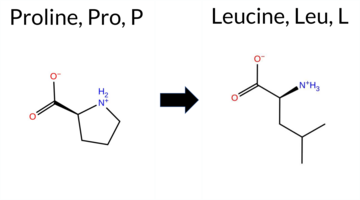 AIThe SynGAP1 missense variant P1327L is listed in ClinVar with an uncertain significance and is present in gnomAD (ID 6‑33451854‑C‑T). Prediction tools that agree on a benign effect include REVEL, PROVEAN, SIFT, ESM1b, FATHMM, AlphaMissense‑Default, and AlphaMissense‑Optimized. Tools that predict a pathogenic effect are polyPhen‑2 HumDiv and polyPhen‑2 HumVar. The high‑accuracy AlphaMissense‑Optimized score is benign, and the SGM Consensus—derived from the majority vote of AlphaMissense‑Default, ESM1b, FATHMM, and PROVEAN—also indicates a benign outcome. Foldetta results are not available for this variant. Overall, the majority of computational evidence supports a benign classification, which is consistent with the ClinVar uncertain status rather than contradicting it. Disclaimer: This summary was generated using AI and should be interpreted alongside expert review. | Likely Benign | Uncertain | 1 | 6-33451854-C-T | 2 | 1.28e-6 | -5.264 | Likely Benign | 0.242 | Likely Benign | Likely Benign | 0.142 | Likely Benign | -1.24 | Neutral | 0.994 | Probably Damaging | 0.908 | Possibly Damaging | 4.12 | Benign | 0.10 | Tolerated | 3.77 | 5 | -3 | -3 | 5.4 | 16.04 | |||||||||||||||||||||||||||
| c.3983G>A | R1328Q 2D  AIThe SynGAP1 missense variant R1328Q is listed in ClinVar (ID 1805359.0) with an “Uncertain” clinical significance and is present in gnomAD (variant ID 6‑33451857‑G‑A). Prediction tools that agree on a benign effect include REVEL, PROVEAN, polyPhen‑2 HumVar, ESM1b, FATHMM, AlphaMissense‑Default, AlphaMissense‑Optimized, and the SGM‑Consensus (Likely Benign). Tools that predict a pathogenic effect are polyPhen‑2 HumDiv and SIFT. High‑accuracy assessments show AlphaMissense‑Optimized as benign and the SGM‑Consensus as Likely Benign; a Foldetta stability analysis is unavailable. Overall, the majority of evidence points to a benign impact, and this is not in conflict with the ClinVar “Uncertain” status. Disclaimer: This summary was generated using AI and should be interpreted alongside expert review. | Likely Benign | Uncertain | 3 | 6-33451857-G-A | 35 | 1.49e-4 | -2.921 | Likely Benign | 0.273 | Likely Benign | Likely Benign | 0.043 | Likely Benign | -1.02 | Neutral | 0.799 | Possibly Damaging | 0.098 | Benign | 4.12 | Benign | 0.03 | Affected | 3.77 | 5 | 1 | 1 | 1.0 | -28.06 | |||||||||||||||||||||||||||
| c.121C>T | R41C 2D 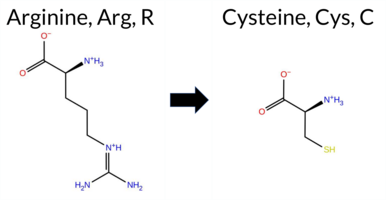 AIThe SynGAP1 missense variant R41C is listed in ClinVar with an “Uncertain” status and is present in gnomAD (ID 6‑33423530‑C‑T). Prediction tools that agree on a benign effect include REVEL, PROVEAN, ESM1b, FATHMM, AlphaMissense‑Default, AlphaMissense‑Optimized, and the SGM‑Consensus (majority vote from AlphaMissense‑Default, ESM1b, FATHMM, and PROVEAN). Tools that predict a pathogenic effect are polyPhen‑2 (HumDiv and HumVar) and SIFT. High‑accuracy assessments show AlphaMissense‑Optimized as benign, the SGM‑Consensus as benign, and no result is available from Foldetta (protein‑folding stability). Taken together, the majority of evidence points to a benign impact for R41C, and this conclusion does not contradict the ClinVar “Uncertain” classification. Disclaimer: This summary was generated using AI and should be interpreted alongside expert review. | Likely Benign | Conflicting | 3 | 6-33423530-C-T | 7 | 4.34e-6 | -4.745 | Likely Benign | 0.207 | Likely Benign | Likely Benign | 0.093 | Likely Benign | -1.10 | Neutral | 0.976 | Probably Damaging | 0.919 | Probably Damaging | 4.13 | Benign | 0.00 | Affected | 4.32 | 1 | -4 | -3 | 7.0 | -53.05 | |||||||||||||||||||||||||||
| c.2324G>C | R775P 2D 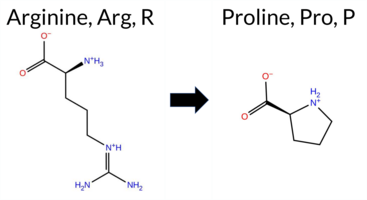 AIThe SynGAP1 missense variant R775P (ClinVar ID 2959355.0) is classified as Benign in ClinVar and is not reported in gnomAD. Prediction tools that agree on a benign effect include SGM‑Consensus (Likely Benign), REVEL, PROVEAN, SIFT, ESM1b, FATHMM, and AlphaMissense‑Optimized. Tools that predict a pathogenic effect are polyPhen‑2 HumDiv and polyPhen‑2 HumVar; AlphaMissense‑Default remains uncertain. High‑accuracy assessments show AlphaMissense‑Optimized as Benign and the SGM Consensus (majority vote of AlphaMissense‑Default, ESM1b, FATHMM, PROVEAN) as Likely Benign; Foldetta results are unavailable. Overall, the majority of evidence points to a benign impact, consistent with the ClinVar designation, and there is no contradiction with the reported ClinVar status. Disclaimer: This summary was generated using AI and should be interpreted alongside expert review. | Likely Benign | Benign | 1 | -5.072 | Likely Benign | 0.452 | Ambiguous | Likely Benign | 0.168 | Likely Benign | -0.79 | Neutral | 0.971 | Probably Damaging | 0.944 | Probably Damaging | 4.13 | Benign | 0.07 | Tolerated | 3.64 | 6 | -2 | 0 | 2.9 | -59.07 | ||||||||||||||||||||||||||||||
| c.2573G>A | S858N 2D  AIThe SynGAP1 missense variant S858N is listed in ClinVar with an “Uncertain” status and is present in gnomAD (variant ID 6‑33443125‑G‑A). Functional prediction tools largely agree on a benign effect: REVEL, PROVEAN, polyPhen‑2 HumDiv, ESM1b, FATHMM, AlphaMissense‑Default, AlphaMissense‑Optimized, and the SGM‑Consensus (majority vote from AlphaMissense‑Default, ESM1b, FATHMM, PROVEAN) all indicate benign. In contrast, polyPhen‑2 HumVar and SIFT predict pathogenicity, but these two tools are in the minority. High‑accuracy assessments show AlphaMissense‑Optimized as benign and the SGM‑Consensus as likely benign; Foldetta results are unavailable. Overall, the preponderance of evidence points to a benign impact, and this conclusion does not contradict the ClinVar “Uncertain” classification. Disclaimer: This summary was generated using AI and should be interpreted alongside expert review. | Likely Benign | Uncertain | 1 | 6-33443125-G-A | 2 | 1.24e-6 | -4.311 | Likely Benign | 0.121 | Likely Benign | Likely Benign | 0.107 | Likely Benign | -0.67 | Neutral | 0.448 | Benign | 0.846 | Possibly Damaging | 4.13 | Benign | 0.02 | Affected | 3.77 | 5 | 1 | 1 | -2.7 | 27.03 | |||||||||||||||||||||||||||
| c.280C>T | P94S 2D 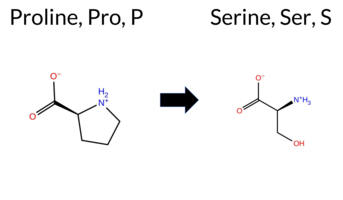 AIThe SynGAP1 missense variant P94S is listed in ClinVar as a benign variant (ClinVar ID 650740.0) and is present in the gnomAD database (gnomAD ID 6‑33425888‑C‑T). Prediction tools that agree on a benign effect include REVEL, PROVEAN, polyPhen‑2 HumDiv, polyPhen‑2 HumVar, ESM1b, FATHMM, AlphaMissense‑Default, AlphaMissense‑Optimized, and the SGM‑Consensus (majority vote from AlphaMissense‑Default, ESM1b, FATHMM, and PROVEAN). Only SIFT predicts a pathogenic outcome. High‑accuracy assessments show AlphaMissense‑Optimized as benign and the SGM‑Consensus (derived from the same four high‑accuracy tools) also as benign. Foldetta, a protein‑folding stability method combining FoldX‑MD and Rosetta outputs, has no available result for this variant. Overall, the majority of predictions, including the high‑accuracy tools, indicate a benign effect, which aligns with the ClinVar classification. Disclaimer: This summary was generated using AI and should be interpreted alongside expert review. | Likely Benign | Benign | 1 | 6-33425888-C-T | 5 | 3.10e-6 | -3.151 | Likely Benign | 0.084 | Likely Benign | Likely Benign | 0.093 | Likely Benign | -2.36 | Neutral | 0.092 | Benign | 0.008 | Benign | 4.13 | Benign | 0.00 | Affected | 4.32 | 1 | 1 | -1 | 0.8 | -10.04 | |||||||||||||||||||||||||||
| c.2924C>A | T975N 2D 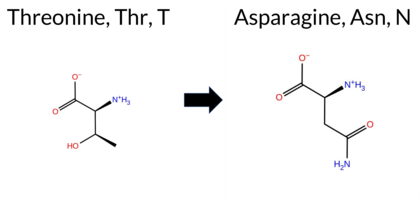 AIThe SynGAP1 missense variant T975N is listed in ClinVar (ID 942242.0) with an “Uncertain” clinical significance and is present in gnomAD (variant ID 6‑33443476‑C‑A). Functional prediction tools largely agree on a benign effect: REVEL, PROVEAN, polyPhen‑2 HumVar, SIFT, ESM1b, FATHMM, AlphaMissense‑Default, and AlphaMissense‑Optimized all report benign or tolerated outcomes. Only polyPhen‑2 HumDiv predicts a pathogenic effect. The SGM‑Consensus, derived from a majority vote of AlphaMissense‑Default, ESM1b, FATHMM, and PROVEAN, classifies the variant as “Likely Benign.” High‑accuracy assessments reinforce this view: AlphaMissense‑Optimized predicts benign, and the SGM‑Consensus (majority vote) also indicates benign. Foldetta, a protein‑folding stability method combining FoldX‑MD and Rosetta outputs, has no available result for this variant. Overall, the preponderance of evidence points to a benign impact, which is consistent with the ClinVar “Uncertain” status rather than contradicting it. Disclaimer: This summary was generated using AI and should be interpreted alongside expert review. | Likely Benign | Uncertain | 1 | 6-33443476-C-A | 1 | 6.20e-7 | -4.671 | Likely Benign | 0.089 | Likely Benign | Likely Benign | 0.100 | Likely Benign | -0.58 | Neutral | 0.586 | Possibly Damaging | 0.302 | Benign | 4.13 | Benign | 0.07 | Tolerated | 4.32 | 2 | 0 | 0 | -2.8 | 13.00 | |||||||||||||||||||||||||||
| c.29G>C | R10P 2D  AIThe SynGAP1 missense variant R10P is listed in ClinVar with an uncertain significance and is present in gnomAD (ID 6‑33420293‑G‑C). Prediction tools that agree on a benign effect include REVEL, PROVEAN, polyPhen‑2 HumDiv, polyPhen‑2 HumVar, ESM1b, FATHMM, AlphaMissense‑Default, and AlphaMissense‑Optimized. Only SIFT predicts a pathogenic outcome. The SGM‑Consensus, derived from a majority vote of AlphaMissense‑Default, ESM1b, FATHMM, and PROVEAN, reports a likely benign classification. High‑accuracy assessments further support a benign interpretation: AlphaMissense‑Optimized is benign, and the SGM‑Consensus (majority of the four high‑accuracy tools) is benign; Foldetta results are unavailable. Overall, the collective evidence points to a benign effect for R10P, which does not contradict the ClinVar uncertain status. Disclaimer: This summary was generated using AI and should be interpreted alongside expert review. | Likely Benign | Uncertain | 2 | 6-33420293-G-C | 2 | 1.30e-6 | -3.772 | Likely Benign | 0.162 | Likely Benign | Likely Benign | 0.220 | Likely Benign | -0.05 | Neutral | 0.233 | Benign | 0.026 | Benign | 4.13 | Benign | 0.00 | Affected | 4.32 | 1 | 0 | -2 | 2.9 | -59.07 | |||||||||||||||||||||||||||
| c.611C>G | S204C 2D 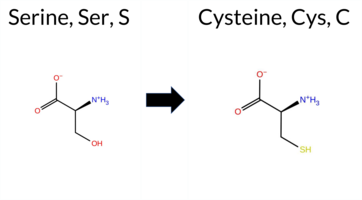 3DClick to see structure in 3D Viewer AISynGAP1 S204C is listed in ClinVar with an uncertain significance and is not reported in gnomAD. Prediction tools that classify the variant as benign include REVEL, Foldetta, premPS, PROVEAN, ESM1b, FATHMM, AlphaMissense‑Default, and AlphaMissense‑Optimized. Tools that predict pathogenicity are polyPhen‑2 HumDiv, polyPhen‑2 HumVar, and SIFT. High‑accuracy assessments show AlphaMissense‑Optimized as benign; the SGM Consensus, derived from the majority vote of AlphaMissense‑Default, ESM1b, FATHMM, and PROVEAN, also indicates benign; and Foldetta, which integrates FoldX‑MD and Rosetta outputs, predicts a benign effect. FoldX and Rosetta individually report uncertain stability changes. Overall, the majority of computational evidence supports a benign effect, which is consistent with the ClinVar uncertain status rather than contradicting it. Disclaimer: This summary was generated using AI and should be interpreted alongside expert review. | Likely Benign | PH | Uncertain | 1 | -6.613 | Likely Benign | 0.127 | Likely Benign | Likely Benign | 0.148 | Likely Benign | 0.65 | Ambiguous | 0.4 | -1.13 | Ambiguous | -0.24 | Likely Benign | 0.10 | Likely Benign | -0.64 | Neutral | 0.978 | Probably Damaging | 0.753 | Possibly Damaging | 4.13 | Benign | 0.05 | Affected | 3.44 | 10 | 0 | -1 | 3.3 | 16.06 | 223.6 | -13.8 | 0.6 | 0.3 | 0.0 | 0.2 | X | Uncertain | The hydroxyl-containing Ser204, located in the N-terminal loop before the first anti-parallel β sheet strand (res. Ile205-Pro208), is replaced by the thiol-containing cysteine. In the WT simulations, Ser204 simultaneously forms hydrogen bonds with the backbone carbonyl of Asp201 and the hydroxyl group of Thr224, helping to stabilize the two anti-parallel β strands (res. Ile205-Lys207 and Cys219-Thr223) at the end of the β sheet. Since the thiol group of cysteine forms weaker hydrogen bonds than the hydroxyl group of serine, Cys204 does not maintain the hydrogen bond network as stably as Ser204 in the variant simulations. However, because the model ends abruptly at the N-terminus, no definite conclusions can be drawn from the simulations. | |||||||||||
| c.218G>A | R73K 2D 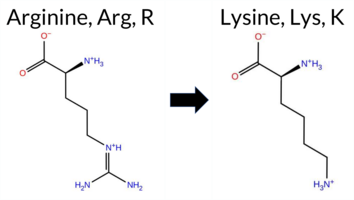 AIThe SynGAP1 missense variant R73K is listed in ClinVar with an “Uncertain” status and is present in gnomAD (ID 6‑33425826‑G‑A). Prediction tools that agree on a benign effect include REVEL, PROVEAN, polyPhen‑2 (HumDiv and HumVar), ESM1b, FATHMM, AlphaMissense‑Default, AlphaMissense‑Optimized, and the SGM‑Consensus score (Likely Benign). Only SIFT predicts a pathogenic outcome. High‑accuracy assessments further support a benign classification: AlphaMissense‑Optimized returns a benign prediction, and the SGM‑Consensus (derived from the majority vote of AlphaMissense‑Default, ESM1b, FATHMM, and PROVEAN) also indicates benign. Foldetta, a protein‑folding stability method combining FoldX‑MD and Rosetta outputs, has no available result for this variant. Overall, the preponderance of evidence points to a benign effect, which does not contradict the ClinVar “Uncertain” designation. Disclaimer: This summary was generated using AI and should be interpreted alongside expert review. | Likely Benign | Uncertain | 1 | 6-33425826-G-A | 2 | 1.24e-6 | -4.033 | Likely Benign | 0.151 | Likely Benign | Likely Benign | 0.077 | Likely Benign | -0.46 | Neutral | 0.053 | Benign | 0.007 | Benign | 4.14 | Benign | 0.00 | Affected | 4.32 | 1 | 2 | 3 | 0.6 | -28.01 | |||||||||||||||||||||||||||
| c.2873A>C | H958P 2D 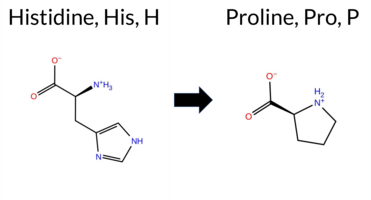 AIThe SynGAP1 missense variant H958P is listed in ClinVar as a benign alteration (ClinVar ID 1006798.0) and is present in the gnomAD database (gnomAD ID 6‑33443425‑A‑C). Prediction tools that agree on a benign effect include REVEL, PROVEAN, polyPhen‑2 HumVar, SIFT, FATHMM, AlphaMissense‑Default, and AlphaMissense‑Optimized. Tools that predict a pathogenic effect are polyPhen‑2 HumDiv and ESM1b. The SGM‑Consensus, which aggregates AlphaMissense‑Default, ESM1b, FATHMM, and PROVEAN, reports a likely benign classification. High‑accuracy assessments show AlphaMissense‑Optimized as benign and the SGM‑Consensus as likely benign; Foldetta results are unavailable. Overall, the majority of evidence points to a benign impact, and this conclusion aligns with the ClinVar benign status, showing no contradiction. Disclaimer: This summary was generated using AI and should be interpreted alongside expert review. | Likely Benign | Benign | 1 | 6-33443425-A-C | 2 | 1.24e-6 | -8.369 | Likely Pathogenic | 0.068 | Likely Benign | Likely Benign | 0.204 | Likely Benign | -0.36 | Neutral | 0.925 | Possibly Damaging | 0.316 | Benign | 4.14 | Benign | 0.10 | Tolerated | 3.77 | 5 | 0 | -2 | 1.6 | -40.02 | |||||||||||||||||||||||||||
| c.416G>A | S139N 2D  AIThe SynGAP1 missense variant S139N is listed in ClinVar with an “Uncertain” status and is present in gnomAD (ID 6‑33432713‑G‑A). Prediction tools that agree on a benign effect include REVEL, PROVEAN, polyPhen‑2 (HumDiv and HumVar), SIFT, ESM1b, FATHMM, AlphaMissense‑Optimized, and the SGM‑Consensus (majority vote from AlphaMissense‑Default, ESM1b, FATHMM, PROVEAN). Only AlphaMissense‑Default predicts a pathogenic outcome. High‑accuracy assessments show AlphaMissense‑Optimized as benign, the SGM‑Consensus as likely benign, and Foldetta results are unavailable. Overall, the majority of evidence points to a benign impact, and this conclusion does not contradict the ClinVar “Uncertain” classification. Disclaimer: This summary was generated using AI and should be interpreted alongside expert review. | Likely Benign | Uncertain | 1 | 6-33432713-G-A | 3 | 2.22e-6 | -4.584 | Likely Benign | 0.688 | Likely Pathogenic | Likely Benign | 0.109 | Likely Benign | -0.75 | Neutral | 0.149 | Benign | 0.047 | Benign | 4.14 | Benign | 0.24 | Tolerated | 3.61 | 5 | 1 | 1 | -2.7 | 27.03 | |||||||||||||||||||||||||||
| c.136C>T | P46S 2D  AIThe SynGAP1 missense variant P46S is listed in ClinVar with an “Uncertain” status and is not reported in gnomAD. Functional prediction tools that agree on a benign effect include REVEL, PROVEAN, ESM1b, FATHMM, AlphaMissense‑Default, and AlphaMissense‑Optimized. In contrast, polyPhen‑2 (HumDiv and HumVar) and SIFT all predict a pathogenic impact. The SGM‑Consensus, which aggregates the majority vote from AlphaMissense‑Default, ESM1b, FATHMM, and PROVEAN, reports the variant as “Likely Benign.” High‑accuracy assessments further support a benign classification: AlphaMissense‑Optimized predicts benign, and the SGM‑Consensus (majority vote) also indicates benign. The Foldetta protein‑folding stability analysis is unavailable for this variant. Overall, the majority of evidence—including high‑accuracy tools—points to a benign effect, and this conclusion does not contradict the ClinVar “Uncertain” designation. Disclaimer: This summary was generated using AI and should be interpreted alongside expert review. | Likely Benign | Uncertain | 1 | -3.338 | Likely Benign | 0.302 | Likely Benign | Likely Benign | 0.066 | Likely Benign | -0.60 | Neutral | 0.909 | Possibly Damaging | 0.901 | Possibly Damaging | 4.15 | Benign | 0.00 | Affected | 1 | -1 | 0.8 | -10.04 | ||||||||||||||||||||||||||||||||
| c.2116G>A | E706K 2D 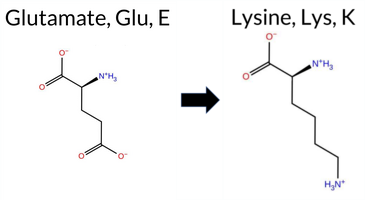 3DClick to see structure in 3D Viewer AISynGAP1 missense variant E706K is listed in ClinVar with an uncertain significance and is not reported in gnomAD. Functional prediction tools largely agree on a benign effect: REVEL, premPS, PROVEAN, polyPhen‑2 (HumDiv and HumVar), SIFT, and FATHMM all classify the change as benign. In contrast, ESM1b and AlphaMissense‑Default predict a pathogenic impact. Tools that return uncertain results—FoldX, Rosetta, Foldetta, and AlphaMissense‑Optimized—do not provide decisive evidence. The SGM Consensus, derived from a majority vote of AlphaMissense‑Default, ESM1b, FATHMM, and PROVEAN, is inconclusive (two pathogenic versus two benign calls). High‑accuracy assessments are likewise ambiguous: AlphaMissense‑Optimized is uncertain, Foldetta is uncertain, and the SGM Consensus remains inconclusive. Overall, the preponderance of evidence points to a benign effect, which does not contradict the ClinVar uncertain status. Disclaimer: This summary was generated using AI and should be interpreted alongside expert review. | GAP | Uncertain | 1 | -10.519 | Likely Pathogenic | 0.833 | Likely Pathogenic | Ambiguous | 0.080 | Likely Benign | 1.17 | Ambiguous | 0.1 | 0.51 | Ambiguous | 0.84 | Ambiguous | 0.08 | Likely Benign | -1.51 | Neutral | 0.345 | Benign | 0.028 | Benign | 4.15 | Benign | 0.52 | Tolerated | 3.47 | 10 | 0 | 1 | -0.4 | -0.94 | 187.1 | 49.2 | 0.0 | 0.0 | 0.4 | 0.1 | X | Uncertain | The carboxylate side chain of Glu706, located at the end and outer surface of an α-helix (res. Thr704-Gly712), forms a salt bridge with Lys710 and a hydrogen bond with its own backbone amino group at the helix end in the WT simulations. Although Lys706 is unable to make these transient interactions in the variant simulations, there is no apparent negative effect on the protein structure due to the residue swap. However, because the model ends abruptly at the C-terminus, no definite conclusions can be drawn based on the simulations. | ||||||||||||
| c.2888A>G | H963R 2D 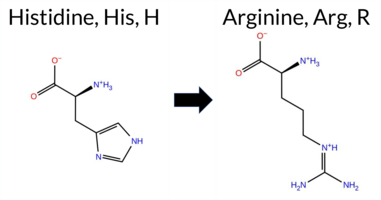 AIThe SynGAP1 missense variant H963R is listed in ClinVar with an “Uncertain” status and is present in gnomAD (ID 6‑33443440‑A‑G). Prediction tools that agree on a benign effect include REVEL, PROVEAN, polyPhen‑2 (HumDiv and HumVar), SIFT, FATHMM, AlphaMissense‑Default, AlphaMissense‑Optimized, and the SGM‑Consensus score (Likely Benign). Only ESM1b predicts a pathogenic outcome. High‑accuracy assessments further support a benign classification: AlphaMissense‑Optimized reports benign, and the SGM‑Consensus (majority vote from AlphaMissense‑Default, ESM1b, FATHMM, PROVEAN) yields a benign consensus. Foldetta, a protein‑folding stability method combining FoldX‑MD and Rosetta outputs, has no reported result for this variant, so its status is unavailable. Overall, the preponderance of evidence indicates the variant is most likely benign, which does not contradict the ClinVar “Uncertain” designation. Disclaimer: This summary was generated using AI and should be interpreted alongside expert review. | Likely Benign | Uncertain | 1 | 6-33443440-A-G | 8 | 4.96e-6 | -8.952 | Likely Pathogenic | 0.169 | Likely Benign | Likely Benign | 0.081 | Likely Benign | -1.28 | Neutral | 0.001 | Benign | 0.003 | Benign | 4.15 | Benign | 0.24 | Tolerated | 3.77 | 5 | 2 | 0 | -1.3 | 19.05 | |||||||||||||||||||||||||||
| c.2900G>T | R967L 2D 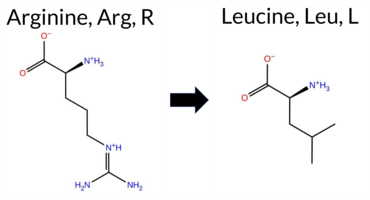 AIThe SynGAP1 missense variant R967L is listed in ClinVar with an “Uncertain” status and is present in gnomAD (ID 6‑33443452‑G‑T). Functional prediction tools that agree on a benign effect include REVEL, PROVEAN, SIFT, ESM1b, FATHMM, AlphaMissense‑Default, AlphaMissense‑Optimized, and the SGM‑Consensus (majority vote from AlphaMissense‑Default, ESM1b, FATHMM, PROVEAN). In contrast, polyPhen‑2 (both HumDiv and HumVar models) predict a pathogenic outcome. High‑accuracy assessments show AlphaMissense‑Optimized as benign and the SGM‑Consensus as likely benign; Foldetta results are unavailable. Overall, the preponderance of evidence points to a benign impact for R967L, which does not contradict the ClinVar “Uncertain” classification. Disclaimer: This summary was generated using AI and should be interpreted alongside expert review. | Likely Benign | Uncertain | 1 | 6-33443452-G-T | 1 | 6.20e-7 | -3.496 | Likely Benign | 0.164 | Likely Benign | Likely Benign | 0.123 | Likely Benign | -0.99 | Neutral | 0.959 | Probably Damaging | 0.586 | Possibly Damaging | 4.15 | Benign | 0.75 | Tolerated | 4.32 | 2 | -2 | -3 | 8.3 | -43.03 | |||||||||||||||||||||||||||
| c.3192G>C | Q1064H 2D 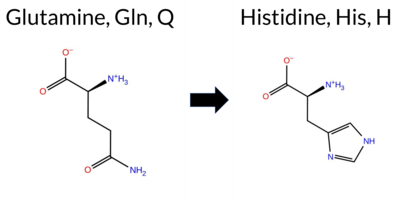 AIThe SynGAP1 missense variant Q1064H is listed in ClinVar with an “Uncertain” status and is not reported in gnomAD. Functional prediction tools that agree on a benign effect include REVEL, PROVEAN, ESM1b, FATHMM, AlphaMissense‑Default, and AlphaMissense‑Optimized. In contrast, polyPhen‑2 (HumDiv and HumVar) and SIFT all predict a pathogenic impact. The SGM‑Consensus, which aggregates the majority vote from AlphaMissense‑Default, ESM1b, FATHMM, and PROVEAN, reports the variant as “Likely Benign.” High‑accuracy assessments further support a benign classification: AlphaMissense‑Optimized predicts benign, and the SGM‑Consensus (majority vote) also indicates benign. The Foldetta protein‑folding stability analysis is unavailable for this variant. Overall, the majority of evidence—including high‑accuracy tools—points to a benign effect, and this conclusion does not contradict the current ClinVar “Uncertain” status. Disclaimer: This summary was generated using AI and should be interpreted alongside expert review. | Likely Benign | Uncertain | 1 | -4.576 | Likely Benign | 0.162 | Likely Benign | Likely Benign | 0.063 | Likely Benign | -0.66 | Neutral | 0.938 | Possibly Damaging | 0.596 | Possibly Damaging | 4.15 | Benign | 0.05 | Affected | 3 | 0 | 0.3 | 9.01 | ||||||||||||||||||||||||||||||||
| c.3964G>C | A1322P 2D 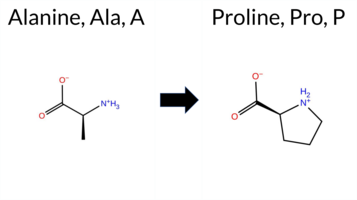 AIThe SynGAP1 missense variant A1322P is reported in ClinVar (ID 1169945.0) as benign and is present in gnomAD (variant ID 6‑33451838‑G‑C). Across the available in‑silico predictors, all tools uniformly classify the substitution as benign: REVEL, PROVEAN, polyPhen‑2 (HumDiv and HumVar), SIFT, ESM1b, FATHMM, AlphaMissense‑Default, and AlphaMissense‑Optimized all return benign predictions. No tool in the dataset indicates a pathogenic effect. High‑accuracy assessments corroborate this consensus: AlphaMissense‑Optimized predicts benign, and the SGM Consensus (majority vote of AlphaMissense‑Default, ESM1b, FATHMM, and PROVEAN) yields a “Likely Benign” verdict. The Foldetta protein‑folding stability analysis is not available for this variant. Overall, the computational evidence strongly supports a benign classification, which is consistent with the ClinVar status and does not contradict it. Disclaimer: This summary was generated using AI and should be interpreted alongside expert review. | Likely Benign | Benign | 1 | 6-33451838-G-C | -1.153 | Likely Benign | 0.063 | Likely Benign | Likely Benign | 0.090 | Likely Benign | 0.03 | Neutral | 0.000 | Benign | 0.000 | Benign | 4.15 | Benign | 0.23 | Tolerated | 3.77 | 5 | 1 | -1 | -3.4 | 26.04 | |||||||||||||||||||||||||||||
| c.901G>A | A301T 2D 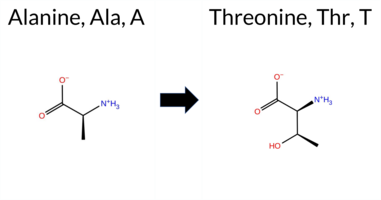 3DClick to see structure in 3D Viewer AIThe SynGAP1 missense variant A301T is listed in ClinVar with an “Uncertain” status and is present in gnomAD (ID 6‑33437806‑G‑A). Prediction tools that uniformly indicate a benign effect include REVEL, FoldX, Rosetta, Foldetta, premPS, PROVEAN, SIFT, ESM1b, FATHMM, AlphaMissense‑Default, and AlphaMissense‑Optimized. Only the two polyPhen‑2 implementations (HumDiv and HumVar) predict a pathogenic outcome. High‑accuracy assessments further support a benign interpretation: AlphaMissense‑Optimized is benign; the SGM Consensus (majority vote of AlphaMissense‑Default, ESM1b, FATHMM, PROVEAN) is “Likely Benign”; and Foldetta, which integrates FoldX‑MD and Rosetta stability calculations, is benign. Overall, the majority of evidence points to a benign effect, and this is not in conflict with the ClinVar “Uncertain” classification. Disclaimer: This summary was generated using AI and should be interpreted alongside expert review. | Likely Benign | C2 | Uncertain | 5 | 6-33437806-G-A | 2 | 1.24e-6 | -3.448 | Likely Benign | 0.070 | Likely Benign | Likely Benign | 0.150 | Likely Benign | 0.36 | Likely Benign | 0.2 | -0.33 | Likely Benign | 0.02 | Likely Benign | 0.03 | Likely Benign | -0.25 | Neutral | 0.997 | Probably Damaging | 0.989 | Probably Damaging | 4.15 | Benign | 0.22 | Tolerated | 4.32 | 14 | 1 | 0 | -2.5 | 30.03 | 219.8 | -42.8 | -0.1 | 0.0 | -0.5 | 0.2 | Uncertain | The methyl group of Ala301, located in a β hairpin loop linking two anti-parallel β sheet strands (res. Met289-Pro298, res. Thr305-Asn315), points outward from the β hairpin loop, and its backbone atoms do not participate in the loop formation in the WT simulations. In the variant simulations, the hydroxyl group of the Thr301 side chain also mostly points outward; however, the guanidinium group of Arg299 is moved away from its central hairpin loop position.β hairpins are potential nucleation sites during the initial stages of protein folding, so even minor changes in them could be significant. Due to its location near the membrane surface, the residue swap could also affect the C2 loop dynamics and SynGAP-membrane association. However, this is beyond the scope of the solvent-only simulations to unravel. | |||||||||
| c.103G>A | V35I 2D 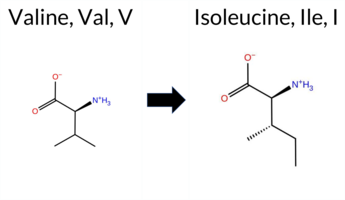 AIThe SynGAP1 missense variant V35I is listed in ClinVar with an “Uncertain” status and is present in gnomAD (ID 6‑33423512‑G‑A). Prediction tools that agree on a benign effect include REVEL, PROVEAN, polyPhen‑2 HumVar, ESM1b, FATHMM, AlphaMissense‑Default, and AlphaMissense‑Optimized. Tools that predict a pathogenic effect are polyPhen‑2 HumDiv and SIFT. High‑accuracy assessments show AlphaMissense‑Optimized as benign, and the SGM Consensus (majority vote from AlphaMissense‑Default, ESM1b, FATHMM, and PROVEAN) also indicates a benign outcome. No Foldetta stability data are available. Overall, the majority of evidence points to a benign impact, and this is consistent with the ClinVar “Uncertain” classification rather than contradicting it. Disclaimer: This summary was generated using AI and should be interpreted alongside expert review. | Likely Benign | Uncertain | 1 | 6-33423512-G-A | 5 | 3.10e-6 | -3.764 | Likely Benign | 0.081 | Likely Benign | Likely Benign | 0.017 | Likely Benign | -0.32 | Neutral | 0.672 | Possibly Damaging | 0.369 | Benign | 4.16 | Benign | 0.00 | Affected | 4.32 | 1 | 3 | 4 | 0.3 | 14.03 | |||||||||||||||||||||||||||
| c.106C>T | H36Y 2D 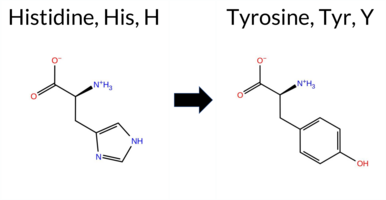 AIThe SynGAP1 missense variant H36Y is listed in ClinVar with an uncertain significance (ClinVar ID 2089635.0) and is present in the gnomAD database (gnomAD ID 6‑33423515‑C‑T). Functional prediction tools largely agree that the substitution is benign: REVEL, PROVEAN, polyPhen‑2 (HumDiv and HumVar), ESM1b, FATHMM, AlphaMissense‑Default, and AlphaMissense‑Optimized all report a benign effect. Only SIFT predicts a pathogenic outcome. High‑accuracy assessments reinforce the benign consensus: AlphaMissense‑Optimized is benign, and the SGM Consensus (majority vote of AlphaMissense‑Default, ESM1b, FATHMM, and PROVEAN) is labeled Likely Benign. No Foldetta stability prediction is available. Overall, the computational evidence overwhelmingly supports a benign classification, which is consistent with the ClinVar designation of uncertain significance rather than a pathogenic claim. Disclaimer: This summary was generated using AI and should be interpreted alongside expert review. | Likely Benign | Uncertain | 1 | 6-33423515-C-T | 2 | 1.24e-6 | -3.461 | Likely Benign | 0.139 | Likely Benign | Likely Benign | 0.023 | Likely Benign | -1.03 | Neutral | 0.219 | Benign | 0.066 | Benign | 4.16 | Benign | 0.00 | Affected | 4.32 | 1 | 0 | 2 | 1.9 | 26.03 | |||||||||||||||||||||||||||
| c.1222A>G | T408A 2D 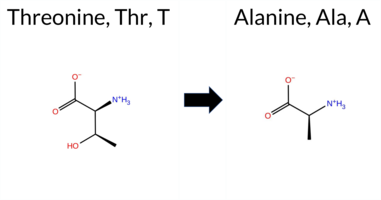 AISynGAP1 missense variant T408A is listed in ClinVar with an uncertain significance and is not reported in gnomAD. Functional prediction tools largely agree on a benign effect: REVEL, FoldX, Rosetta, Foldetta, polyPhen‑2 (HumVar), SIFT, FATHMM, AlphaMissense‑Default, and AlphaMissense‑Optimized all predict benign. Pathogenic predictions come from PROVEAN, polyPhen‑2 (HumDiv), and ESM1b. The high‑accuracy AlphaMissense‑Optimized score is benign, while the SGM consensus (majority vote of AlphaMissense‑Default, ESM1b, FATHMM, PROVEAN) is inconclusive due to a 2‑to‑2 split. Foldetta, a protein‑folding stability method, also predicts benign. Overall, the balance of evidence favors a benign impact, which does not contradict the ClinVar uncertain status. Disclaimer: This summary was generated using AI and should be interpreted alongside expert review. | C2 | Uncertain | 1 | -8.304 | Likely Pathogenic | 0.114 | Likely Benign | Likely Benign | 0.118 | Likely Benign | 0.37 | Likely Benign | 0.6 | -0.06 | Likely Benign | 0.16 | Likely Benign | 0.72 | Ambiguous | -3.07 | Deleterious | 0.540 | Possibly Damaging | 0.131 | Benign | 4.16 | Benign | 0.14 | Tolerated | 1 | 0 | 2.5 | -30.03 | |||||||||||||||||||||||
| c.2567A>G | N856S 2D 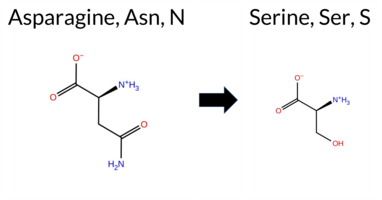 AIThe SynGAP1 missense variant N856S is listed in ClinVar with an “Uncertain” status and is present in gnomAD (ID 6‑33443119‑A‑G). Prediction tools that agree on a benign effect include REVEL, PROVEAN, SIFT, ESM1b, FATHMM, AlphaMissense‑Default, and AlphaMissense‑Optimized. Those that predict a pathogenic outcome are polyPhen‑2 HumDiv and polyPhen‑2 HumVar. The SGM‑Consensus, derived from a majority vote of AlphaMissense‑Default, ESM1b, FATHMM, and PROVEAN, reports a likely benign classification. High‑accuracy assessments show AlphaMissense‑Optimized as benign and the SGM‑Consensus (majority vote) also benign; Foldetta results are unavailable. Overall, the preponderance of evidence points to a benign effect, which does not contradict the ClinVar “Uncertain” designation. Disclaimer: This summary was generated using AI and should be interpreted alongside expert review. | Likely Benign | Uncertain | 1 | 6-33443119-A-G | 2 | 1.24e-6 | -2.104 | Likely Benign | 0.064 | Likely Benign | Likely Benign | 0.040 | Likely Benign | -1.54 | Neutral | 0.901 | Possibly Damaging | 0.535 | Possibly Damaging | 4.16 | Benign | 0.30 | Tolerated | 3.88 | 3 | 1 | 1 | 2.7 | -27.03 | |||||||||||||||||||||||||||
| c.2924C>G | T975S 2D 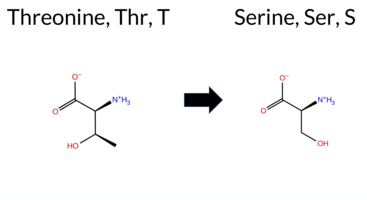 AIThe SynGAP1 missense variant T975S is listed in ClinVar with an “Uncertain” status and is not reported in gnomAD. Functional prediction tools that agree on a benign effect include REVEL, PROVEAN, polyPhen‑2 (HumDiv and HumVar), SIFT, ESM1b, FATHMM, AlphaMissense‑Default, and AlphaMissense‑Optimized. No tool in the dataset predicts a pathogenic outcome. High‑accuracy assessments further support a benign interpretation: AlphaMissense‑Optimized scores the variant as benign, and the SGM Consensus (majority vote from AlphaMissense‑Default, ESM1b, FATHMM, and PROVEAN) indicates “Likely Benign.” Foldetta, a protein‑folding stability method combining FoldX‑MD and Rosetta outputs, did not provide a result for this variant. Overall, the available predictions strongly suggest that T975S is most likely benign, and this conclusion does not contradict the ClinVar “Uncertain” classification. Disclaimer: This summary was generated using AI and should be interpreted alongside expert review. | Likely Benign | Uncertain | 1 | -2.743 | Likely Benign | 0.068 | Likely Benign | Likely Benign | 0.109 | Likely Benign | -0.57 | Neutral | 0.059 | Benign | 0.061 | Benign | 4.16 | Benign | 0.20 | Tolerated | 1 | 1 | -0.1 | -14.03 | ||||||||||||||||||||||||||||||||
| c.3238G>T | A1080S 2D 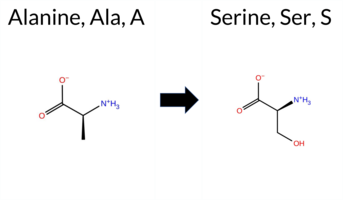 AIThe SynGAP1 missense variant A1080S is listed in ClinVar (ID 2703014.0) with an “Uncertain” status and is present in gnomAD (variant ID 6‑33443790‑G‑T). Prediction tools that agree on a benign effect include REVEL, PROVEAN, polyPhen‑2 HumVar, SIFT, ESM1b, FATHMM, AlphaMissense‑Default, and AlphaMissense‑Optimized. Only polyPhen‑2 HumDiv predicts a pathogenic outcome. The SGM‑Consensus, derived from a majority vote of AlphaMissense‑Default, ESM1b, FATHMM, and PROVEAN, reports the variant as “Likely Benign.” High‑accuracy assessments show AlphaMissense‑Optimized as benign and the SGM‑Consensus as likely benign; Foldetta results are not available. Overall, the preponderance of evidence points to a benign effect, and this conclusion does not contradict the ClinVar designation, which remains uncertain. Disclaimer: This summary was generated using AI and should be interpreted alongside expert review. | Likely Benign | Uncertain | 1 | 6-33443790-G-T | 1 | 6.26e-7 | -3.277 | Likely Benign | 0.108 | Likely Benign | Likely Benign | 0.103 | Likely Benign | 0.01 | Neutral | 0.702 | Possibly Damaging | 0.346 | Benign | 4.16 | Benign | 0.08 | Tolerated | 3.77 | 5 | 1 | 1 | -2.6 | 16.00 | |||||||||||||||||||||||||||
| c.43G>A | A15T 2D  AIThe SynGAP1 missense variant A15T is listed in ClinVar (ID 1925632.0) with an “Uncertain” clinical significance and is present in gnomAD (6‑33420307‑G‑A). Prediction tools that agree on a benign effect include REVEL, PROVEAN, polyPhen‑2 HumVar, ESM1b, FATHMM, AlphaMissense‑Default, and AlphaMissense‑Optimized. Tools that predict a pathogenic effect are polyPhen‑2 HumDiv and SIFT. High‑accuracy assessments show AlphaMissense‑Optimized as benign and the SGM Consensus (majority vote from AlphaMissense‑Default, ESM1b, FATHMM, and PROVEAN) as “Likely Benign”; Foldetta results are unavailable. Overall, the majority of evidence points to a benign impact, and this conclusion does not contradict the ClinVar status, which remains uncertain. Disclaimer: This summary was generated using AI and should be interpreted alongside expert review. | Likely Benign | Uncertain | 1 | 6-33420307-G-A | 4 | 2.60e-6 | -3.720 | Likely Benign | 0.125 | Likely Benign | Likely Benign | 0.086 | Likely Benign | -0.08 | Neutral | 0.602 | Possibly Damaging | 0.017 | Benign | 4.16 | Benign | 0.00 | Affected | 4.32 | 1 | 1 | 0 | -2.5 | 30.03 | |||||||||||||||||||||||||||
| c.526A>C | S176R 2D 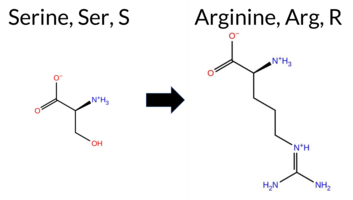 AIThe SynGAP1 missense variant S176R is listed in ClinVar with an uncertain significance and is not reported in gnomAD. Functional prediction tools that agree on a benign effect include REVEL, PROVEAN, polyPhen‑2 HumVar, SIFT, ESM1b, and FATHMM, whereas polyPhen‑2 HumDiv, AlphaMissense‑Default, and AlphaMissense‑Optimized predict a pathogenic outcome. The SGM‑Consensus, derived from a majority vote of AlphaMissense‑Default, ESM1b, FATHMM, and PROVEAN, reports a likely benign classification. High‑accuracy assessments show AlphaMissense‑Optimized as pathogenic, while the SGM‑Consensus remains likely benign; Foldetta results are unavailable. Overall, the balance of evidence favors a benign interpretation, and this assessment does not conflict with the ClinVar uncertain status. Disclaimer: This summary was generated using AI and should be interpreted alongside expert review. | Likely Benign | Uncertain | 1 | -6.492 | Likely Benign | 0.987 | Likely Pathogenic | Likely Pathogenic | 0.247 | Likely Benign | 0.94 | Neutral | 0.718 | Possibly Damaging | 0.168 | Benign | 4.16 | Benign | 0.87 | Tolerated | 0 | -1 | -3.7 | 69.11 | ||||||||||||||||||||||||||||||||
| c.2324G>A | R775Q 2D  AIThe SynGAP1 missense variant R775Q is listed in ClinVar with an “Uncertain” status and is present in gnomAD (variant ID 6‑33442482‑G‑A). Functional prediction tools that agree on a benign effect include REVEL, PROVEAN, SIFT, ESM1b, FATHMM, AlphaMissense‑Default, AlphaMissense‑Optimized, and the SGM‑Consensus (majority vote from AlphaMissense‑Default, ESM1b, FATHMM, and PROVEAN). In contrast, polyPhen‑2 (both HumDiv and HumVar models) predict a pathogenic outcome. High‑accuracy assessments further support a benign interpretation: AlphaMissense‑Optimized scores benign, and the SGM‑Consensus (derived from the same set of high‑confidence predictors) is “Likely Benign.” No Foldetta stability prediction is available, so it does not influence the assessment. Overall, the majority of evidence points to a benign effect, and this conclusion does not contradict the ClinVar “Uncertain” classification. Disclaimer: This summary was generated using AI and should be interpreted alongside expert review. | Likely Benign | Conflicting | 3 | 6-33442482-G-A | 11 | 1.41e-5 | -4.476 | Likely Benign | 0.229 | Likely Benign | Likely Benign | 0.085 | Likely Benign | -0.63 | Neutral | 0.969 | Probably Damaging | 0.863 | Possibly Damaging | 4.17 | Benign | 0.16 | Tolerated | 3.64 | 6 | 1 | 1 | 1.0 | -28.06 | 10.1016/j.ajhg.2020.11.011 | ||||||||||||||||||||||||||
| c.2989G>A | A997T 2D  AIThe SynGAP1 missense variant A997T is listed in ClinVar with an uncertain significance and is not reported in gnomAD. Prediction tools that agree on a benign effect include REVEL, PROVEAN, polyPhen‑2 HumDiv, polyPhen‑2 HumVar, ESM1b, FATHMM, AlphaMissense‑Default, AlphaMissense‑Optimized, and the SGM‑Consensus (majority vote of AlphaMissense‑Default, ESM1b, FATHMM, PROVEAN). Only SIFT predicts a pathogenic outcome. High‑accuracy assessments further support a benign interpretation: AlphaMissense‑Optimized is benign, and the SGM‑Consensus (derived from the four high‑accuracy predictors) is benign; Foldetta results are unavailable. Taken together, the majority of computational evidence indicates a benign effect, which is consistent with the ClinVar uncertain status rather than contradicting it. Disclaimer: This summary was generated using AI and should be interpreted alongside expert review. | Likely Benign | Uncertain | 1 | -4.102 | Likely Benign | 0.071 | Likely Benign | Likely Benign | 0.085 | Likely Benign | -0.62 | Neutral | 0.224 | Benign | 0.120 | Benign | 4.17 | Benign | 0.00 | Affected | 4.32 | 4 | 1 | 0 | -2.5 | 30.03 | ||||||||||||||||||||||||||||||
| c.29G>A | R10Q 2D  AIThe SynGAP1 missense variant R10Q is listed in ClinVar with an “Uncertain” status and is present in gnomAD (ID 6‑33420293‑G‑A). Prediction tools that agree on a benign effect include REVEL, PROVEAN, polyPhen‑2 (HumDiv and HumVar), ESM1b, FATHMM, AlphaMissense‑Default, AlphaMissense‑Optimized, and the SGM‑Consensus (majority vote from AlphaMissense‑Default, ESM1b, FATHMM, and PROVEAN). Only SIFT predicts a pathogenic outcome. High‑accuracy assessments further support a benign classification: AlphaMissense‑Optimized is benign, and the SGM‑Consensus is “Likely Benign.” Foldetta, a protein‑folding stability method combining FoldX‑MD and Rosetta outputs, has no available result for this variant. Overall, the preponderance of evidence indicates that R10Q is most likely benign, which does not contradict the current ClinVar “Uncertain” designation. Disclaimer: This summary was generated using AI and should be interpreted alongside expert review. | Likely Benign | Uncertain | 2 | 6-33420293-G-A | 20 | 1.30e-5 | -4.438 | Likely Benign | 0.185 | Likely Benign | Likely Benign | 0.084 | Likely Benign | 0.03 | Neutral | 0.121 | Benign | 0.004 | Benign | 4.17 | Benign | 0.00 | Affected | 4.32 | 1 | 1 | 1 | 1.0 | -28.06 | |||||||||||||||||||||||||||
| c.1312G>A | A438T 2D  3DClick to see structure in 3D Viewer AIThe SynGAP1 missense variant A438T is listed in ClinVar with an “Uncertain” status and is present in the gnomAD database (gnomAD ID 6‑33438217‑G‑A). Prediction tools that agree on a benign effect include REVEL, FoldX, Rosetta, Foldetta, premPS, PROVEAN, polyPhen‑2 (HumDiv and HumVar), SIFT, ESM1b, FATHMM, AlphaMissense‑Default, and AlphaMissense‑Optimized. No tool in the dataset predicts a pathogenic outcome. High‑accuracy assessments further support a benign classification: AlphaMissense‑Optimized is benign; the SGM Consensus (majority vote of AlphaMissense‑Default, ESM1b, FATHMM, and PROVEAN) is “Likely Benign”; and Foldetta, which integrates FoldX‑MD and Rosetta stability outputs, is benign. Based on the collective predictions, the variant is most likely benign, and this conclusion does not contradict the current ClinVar status of “Uncertain.” Disclaimer: This summary was generated using AI and should be interpreted alongside expert review. | Likely Benign | GAP | Conflicting | 3 | 6-33438217-G-A | 16 | 9.91e-6 | -5.339 | Likely Benign | 0.085 | Likely Benign | Likely Benign | 0.021 | Likely Benign | 0.21 | Likely Benign | 0.0 | -0.07 | Likely Benign | 0.07 | Likely Benign | 0.36 | Likely Benign | -0.81 | Neutral | 0.300 | Benign | 0.011 | Benign | 4.18 | Benign | 0.14 | Tolerated | 3.38 | 26 | 1 | 0 | -2.5 | 30.03 | 214.2 | -42.7 | -0.3 | 0.1 | -0.4 | 0.1 | X | Potentially Benign | The methyl group of Ala438, located in a four-residue loop connecting two α helices (res. Asn440-Thr458 and Pro413-Glu436), packs against hydrophobic residues from a nearby α helix or loop residues (e.g., Leu703, Val699). In the variant simulations, the methyl group of Thr438 is able to establish similar hydrophobic packing. Moreover, the hydroxyl group also H-bonds with nearby residues, such as the carbonyl group of the neighboring loop residue Pro437. Accordingly, the residue swap does not generate an apparent negative effect on the protein structure based on the simulations. | ||||||||
| c.2557G>C | G853R 2D  AIThe SynGAP1 missense variant G853R is listed in ClinVar with an “Uncertain” status and is not reported in gnomAD. Functional prediction tools that agree on a benign effect include REVEL, PROVEAN, ESM1b, FATHMM, AlphaMissense‑Optimized, and the SGM‑Consensus (majority vote from AlphaMissense‑Default, ESM1b, FATHMM, PROVEAN). Tools that predict a pathogenic effect are polyPhen‑2 HumDiv, polyPhen‑2 HumVar, and SIFT. AlphaMissense‑Default is uncertain, and Foldetta (a protein‑folding stability method combining FoldX‑MD and Rosetta outputs) has no available result for this variant. High‑accuracy predictions therefore point to a benign outcome: AlphaMissense‑Optimized is benign, SGM‑Consensus is likely benign, and no Foldetta data is available. Overall, the majority of evidence supports a benign classification, which does not contradict the current ClinVar “Uncertain” status. Disclaimer: This summary was generated using AI and should be interpreted alongside expert review. | Likely Benign | Uncertain | 1 | -4.749 | Likely Benign | 0.366 | Ambiguous | Likely Benign | 0.091 | Likely Benign | -1.27 | Neutral | 0.846 | Possibly Damaging | 0.624 | Possibly Damaging | 4.18 | Benign | 0.00 | Affected | -3 | -2 | -4.1 | 99.14 | ||||||||||||||||||||||||||||||||
| c.502C>T | H168Y 2D  AIThe SynGAP1 missense variant H168Y is listed in ClinVar (ID 956914.0) as benign and is not reported in gnomAD. Prediction tools that agree on a benign effect include REVEL, PROVEAN, polyPhen‑2 (HumDiv and HumVar), FATHMM, AlphaMissense‑Default, AlphaMissense‑Optimized, and the SGM‑Consensus (majority vote from AlphaMissense‑Default, ESM1b, FATHMM, and PROVEAN). Tools that predict a pathogenic effect are SIFT and ESM1b. High‑accuracy assessments show AlphaMissense‑Optimized as benign and the SGM‑Consensus as likely benign; the Foldetta protein‑folding stability analysis is unavailable. Overall, the majority of evidence points to a benign impact, and this conclusion is consistent with the ClinVar benign classification. Disclaimer: This summary was generated using AI and should be interpreted alongside expert review. | Likely Benign | Benign | 1 | -8.914 | Likely Pathogenic | 0.264 | Likely Benign | Likely Benign | 0.065 | Likely Benign | -1.53 | Neutral | 0.192 | Benign | 0.062 | Benign | 4.18 | Benign | 0.01 | Affected | 4.32 | 3 | 0 | 2 | 1.9 | 26.03 | ||||||||||||||||||||||||||||||
| c.172A>G | M58V 2D 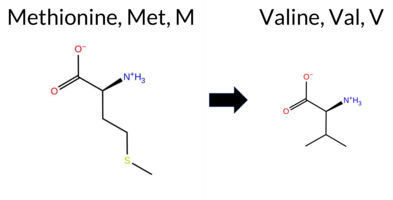 AIThe SynGAP1 missense variant M58V is listed in ClinVar (ID 2962156.0) with an uncertain significance status and is not reported in gnomAD. Functional prediction tools that agree on a benign effect include REVEL, PROVEAN, polyPhen‑2 HumDiv, polyPhen‑2 HumVar, ESM1b, FATHMM, and AlphaMissense‑Optimized. Tools that predict a pathogenic effect are SIFT and AlphaMissense‑Default. The high‑accuracy consensus from AlphaMissense‑Optimized, SGM Consensus (derived from AlphaMissense‑Default, ESM1b, FATHMM, and PROVEAN), and Foldetta (protein‑folding stability) is available only for the first two; Foldetta data are missing. The SGM Consensus, based on a majority of benign predictions, indicates a likely benign outcome. Overall, the majority of evidence points to a benign impact, which does not contradict the ClinVar uncertain status. Disclaimer: This summary was generated using AI and should be interpreted alongside expert review. | Likely Benign | Uncertain | 1 | -2.211 | Likely Benign | 0.688 | Likely Pathogenic | Likely Benign | 0.160 | Likely Benign | -0.71 | Neutral | 0.006 | Benign | 0.091 | Benign | 4.19 | Benign | 0.00 | Affected | 4.32 | 1 | 1 | 2 | 2.3 | -32.06 | ||||||||||||||||||||||||||||||
| c.194A>G | H65R 2D  AIThe SynGAP1 missense variant H65R is listed in ClinVar with an “Uncertain” status and is present in gnomAD (ID 6‑33425802‑A‑G). Prediction tools that agree on a benign effect include REVEL, PROVEAN, polyPhen‑2 HumVar, ESM1b, and FATHMM, while those that predict a pathogenic effect are polyPhen‑2 HumDiv, SIFT, AlphaMissense‑Default, and AlphaMissense‑Optimized. The SGM‑Consensus, which aggregates AlphaMissense‑Default, ESM1b, FATHMM, and PROVEAN, reports a “Likely Benign” classification. High‑accuracy assessments show AlphaMissense‑Optimized as pathogenic, whereas the SGM‑Consensus remains benign; Foldetta results are unavailable. Overall, the majority of evidence points to a benign impact, and this conclusion does not contradict the ClinVar “Uncertain” designation. Disclaimer: This summary was generated using AI and should be interpreted alongside expert review. | Likely Benign | Uncertain | 1 | 6-33425802-A-G | 1 | 6.20e-7 | -1.980 | Likely Benign | 0.967 | Likely Pathogenic | Likely Pathogenic | 0.073 | Likely Benign | -1.60 | Neutral | 0.462 | Possibly Damaging | 0.227 | Benign | 4.19 | Benign | 0.00 | Affected | 4.32 | 1 | 2 | 0 | -1.3 | 19.05 | |||||||||||||||||||||||||||
| c.382C>A | P128T 2D 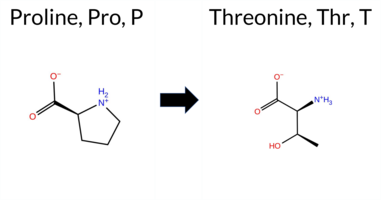 AIThe SynGAP1 missense variant P128T is listed in ClinVar with an “Uncertain” status (ClinVar ID 2801315.0) and is present in gnomAD (ID 6‑33432247‑C‑A). Prediction tools that agree on a benign effect include REVEL, PROVEAN, SIFT, ESM1b, FATHMM, AlphaMissense‑Default, AlphaMissense‑Optimized, and the SGM‑Consensus (majority vote from AlphaMissense‑Default, ESM1b, FATHMM, PROVEAN). Tools that predict a pathogenic effect are polyPhen‑2 HumDiv and polyPhen‑2 HumVar. High‑accuracy assessments show AlphaMissense‑Optimized as benign and the SGM‑Consensus (majority vote) as likely benign; Foldetta results are unavailable. Overall, the majority of evidence points to a benign impact, and this conclusion does not contradict the ClinVar “Uncertain” classification. Disclaimer: This summary was generated using AI and should be interpreted alongside expert review. | Likely Benign | Uncertain | 1 | 6-33432247-C-A | 1 | 6.20e-7 | -4.217 | Likely Benign | 0.267 | Likely Benign | Likely Benign | 0.075 | Likely Benign | -0.96 | Neutral | 0.952 | Possibly Damaging | 0.500 | Possibly Damaging | 4.19 | Benign | 0.35 | Tolerated | 3.74 | 4 | -1 | 0 | 0.9 | 3.99 | |||||||||||||||||||||||||||
| c.3941C>T | P1314L 2D  AIThe SynGAP1 missense variant P1314L is listed in ClinVar as a benign alteration (ClinVar ID 646689.0) and is present in the gnomAD database (gnomAD ID 6‑33451815‑C‑T). Functional prediction tools that agree on a benign effect include REVEL, PROVEAN, polyPhen‑2 (HumDiv and HumVar), ESM1b, FATHMM, AlphaMissense‑Default, AlphaMissense‑Optimized, and the SGM‑Consensus (majority vote from AlphaMissense‑Default, ESM1b, FATHMM, and PROVEAN). Only SIFT predicts a pathogenic outcome. High‑accuracy assessments show AlphaMissense‑Optimized as benign and the SGM‑Consensus as likely benign; Foldetta results are unavailable. Overall, the majority of evidence points to a benign impact, which is consistent with the ClinVar classification. Thus, the variant is most likely benign and does not contradict the ClinVar status. Disclaimer: This summary was generated using AI and should be interpreted alongside expert review. | Likely Benign | Likely Benign | 1 | 6-33451815-C-T | 2 | 1.24e-6 | -4.040 | Likely Benign | 0.118 | Likely Benign | Likely Benign | 0.049 | Likely Benign | -0.20 | Neutral | 0.421 | Benign | 0.066 | Benign | 4.19 | Benign | 0.05 | Affected | 3.77 | 5 | -3 | -3 | 5.4 | 16.04 | |||||||||||||||||||||||||||
| c.44C>T | A15V 2D 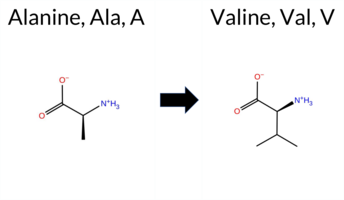 AIThe SynGAP1 missense variant A15V is listed in ClinVar (ID 1801174.0) with an “Uncertain” status and is present in gnomAD (6‑33420308‑C‑T). Prediction tools that agree on a benign effect include REVEL, PROVEAN, polyPhen‑2 HumVar, ESM1b, FATHMM, AlphaMissense‑Default, and AlphaMissense‑Optimized, while polyPhen‑2 HumDiv and SIFT predict a pathogenic outcome. The SGM‑Consensus, derived from a majority vote of AlphaMissense‑Default, ESM1b, FATHMM, and PROVEAN, reports a “Likely Benign” classification. High‑accuracy assessments show AlphaMissense‑Optimized as benign and the SGM‑Consensus as likely benign; Foldetta results are unavailable. Overall, the majority of evidence points to a benign effect, and this does not contradict the ClinVar designation, which remains uncertain. Disclaimer: This summary was generated using AI and should be interpreted alongside expert review. | Likely Benign | Uncertain | 1 | 6-33420308-C-T | 1 | 6.49e-7 | -3.560 | Likely Benign | 0.161 | Likely Benign | Likely Benign | 0.105 | Likely Benign | 0.20 | Neutral | 0.602 | Possibly Damaging | 0.015 | Benign | 4.19 | Benign | 0.00 | Affected | 4.32 | 1 | 0 | 0 | 2.4 | 28.05 | |||||||||||||||||||||||||||
| c.2928T>G | F976L 2D 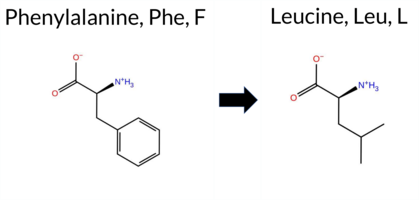 AIThe SynGAP1 missense variant F976L is listed in ClinVar (ID 624245.0) with an “Uncertain” status and is not reported in gnomAD. Functional prediction tools that agree on a benign effect include REVEL, PROVEAN, polyPhen‑2 (HumDiv and HumVar), SIFT, ESM1b, and FATHMM. Only AlphaMissense‑Default predicts a pathogenic outcome. The high‑accuracy consensus predictor SGM‑Consensus, which aggregates AlphaMissense‑Default, ESM1b, FATHMM, and PROVEAN, reports a “Likely Benign” classification. AlphaMissense‑Optimized is inconclusive, and no Foldetta (FoldX‑MD/Rosetta stability) result is available. Overall, the majority of evidence points to a benign impact, and this is consistent with the ClinVar designation of uncertainty rather than a definitive pathogenic claim. Thus, the variant is most likely benign, and its predictions do not contradict the current ClinVar status. Disclaimer: This summary was generated using AI and should be interpreted alongside expert review. | Likely Benign | Uncertain | 1 | -2.432 | Likely Benign | 0.825 | Likely Pathogenic | Ambiguous | 0.212 | Likely Benign | -0.87 | Neutral | 0.264 | Benign | 0.102 | Benign | 4.20 | Benign | 0.53 | Tolerated | 4.32 | 2 | 2 | 0 | 1.0 | -34.02 | ||||||||||||||||||||||||||||||
| c.2299A>G | I767V 2D 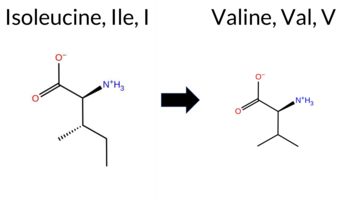 AIThe SynGAP1 missense variant I767V is listed in ClinVar (ID 1402700.0) with an “Uncertain” clinical significance and is not reported in gnomAD. All evaluated in‑silico predictors classify the substitution as benign: REVEL, PROVEAN, PolyPhen‑2 (HumDiv and HumVar), SIFT, ESM1b, FATHMM, AlphaMissense‑Default, and AlphaMissense‑Optimized all return benign scores. The SGM‑Consensus, which aggregates the majority vote of AlphaMissense‑Default, ESM1b, FATHMM, and PROVEAN, also reports a “Likely Benign” outcome. No tool predicts pathogenicity. High‑accuracy assessments confirm this: AlphaMissense‑Optimized is benign, SGM‑Consensus is likely benign, while Foldetta (combining FoldX‑MD and Rosetta stability predictions) has no available result for this variant. Overall, the computational evidence strongly supports a benign effect, and this conclusion does not contradict the current ClinVar status of uncertainty. Disclaimer: This summary was generated using AI and should be interpreted alongside expert review. | Likely Benign | Uncertain | 1 | -2.791 | Likely Benign | 0.064 | Likely Benign | Likely Benign | 0.096 | Likely Benign | 0.10 | Neutral | 0.072 | Benign | 0.029 | Benign | 4.21 | Benign | 1.00 | Tolerated | 3.64 | 6 | 4 | 3 | -0.3 | -14.03 | ||||||||||||||||||||||||||||||
| c.2393C>T | P798L 2D  AIThe SynGAP1 missense variant P798L is listed in ClinVar with an “Uncertain” status and is present in gnomAD (ID 6‑33442945‑C‑T). Functional prediction tools that agree on a benign effect include REVEL, PROVEAN, ESM1b, FATHMM, AlphaMissense‑Default, AlphaMissense‑Optimized, and the SGM‑Consensus score (Likely Benign). In contrast, polyPhen‑2 (HumDiv and HumVar) and SIFT all predict a pathogenic impact. High‑accuracy assessments show AlphaMissense‑Optimized as Benign and the SGM‑Consensus (majority vote from AlphaMissense‑Default, ESM1b, FATHMM, PROVEAN) as Likely Benign; a Foldetta stability prediction is not available. Overall, the majority of evidence points to a benign effect, which does not contradict the ClinVar “Uncertain” classification. Disclaimer: This summary was generated using AI and should be interpreted alongside expert review. | Likely Benign | SH3-binding motif | Uncertain | 2 | 6-33442945-C-T | 6 | 3.72e-6 | -5.640 | Likely Benign | 0.074 | Likely Benign | Likely Benign | 0.042 | Likely Benign | -0.86 | Neutral | 0.981 | Probably Damaging | 0.631 | Possibly Damaging | 4.21 | Benign | 0.00 | Affected | 4.32 | 1 | -3 | -3 | 5.4 | 16.04 | ||||||||||||||||||||||||||
| c.2900G>A | R967Q 2D  AIThe SynGAP1 missense variant R967Q is listed in ClinVar as Benign (ClinVar ID 536992.0) and is present in gnomAD (6‑33443452‑G‑A). Prediction tools that agree on a benign effect include REVEL, PROVEAN, SIFT, ESM1b, FATHMM, AlphaMissense‑Default, AlphaMissense‑Optimized, and the SGM‑Consensus score (Likely Benign). Tools that predict a pathogenic effect are PolyPhen‑2 HumDiv and PolyPhen‑2 HumVar. High‑accuracy assessments show AlphaMissense‑Optimized as benign and the SGM‑Consensus (majority vote from AlphaMissense‑Default, ESM1b, FATHMM, PROVEAN) as Likely Benign; Foldetta results are unavailable. Overall, the majority of evidence points to a benign impact, aligning with the ClinVar classification and not contradicting it. Disclaimer: This summary was generated using AI and should be interpreted alongside expert review. | Likely Benign | Benign/Likely benign | 2 | 6-33443452-G-A | 31 | 1.92e-5 | -3.057 | Likely Benign | 0.080 | Likely Benign | Likely Benign | 0.104 | Likely Benign | -0.01 | Neutral | 0.994 | Probably Damaging | 0.626 | Possibly Damaging | 4.21 | Benign | 0.36 | Tolerated | 4.32 | 2 | 1 | 1 | 1.0 | -28.06 | |||||||||||||||||||||||||||
| c.304T>G | L102V 2D 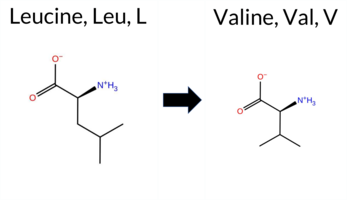 AIThe SynGAP1 missense variant L102V is listed in ClinVar (ID 1925749.0) with an “Uncertain” status and is present in gnomAD (6‑33432169‑T‑G). Prediction tools that agree on a benign effect include REVEL, PROVEAN, ESM1b, FATHMM, AlphaMissense‑Default, AlphaMissense‑Optimized, and the SGM‑Consensus (Likely Benign). Tools that predict a pathogenic effect are polyPhen‑2 HumDiv, polyPhen‑2 HumVar, and SIFT. High‑accuracy assessments show AlphaMissense‑Optimized as benign and the SGM‑Consensus as Likely Benign; Foldetta results are unavailable. Overall, the majority of evidence points to a benign impact. This consensus does not contradict the ClinVar “Uncertain” classification, which remains inconclusive. Disclaimer: This summary was generated using AI and should be interpreted alongside expert review. | Likely Benign | Uncertain | 1 | 6-33432169-T-G | 1 | 6.20e-7 | -4.316 | Likely Benign | 0.068 | Likely Benign | Likely Benign | 0.102 | Likely Benign | 0.32 | Neutral | 0.880 | Possibly Damaging | 0.899 | Possibly Damaging | 4.21 | Benign | 0.00 | Affected | 4.32 | 1 | 2 | 1 | 0.4 | -14.03 | |||||||||||||||||||||||||||
| c.1260T>G | F420L 2D  3DClick to see structure in 3D Viewer AIThe SynGAP1 missense variant F420L is listed in ClinVar (ID 1397885.0) with an “Uncertain” clinical significance and is not reported in gnomAD. Functional prediction tools that agree on a benign effect include REVEL, polyPhen‑2 (HumDiv and HumVar), SIFT, and FATHMM. Those that predict a pathogenic effect comprise premPS, PROVEAN, ESM1b, AlphaMissense‑Default, AlphaMissense‑Optimized, and the SGM Consensus (majority vote from AlphaMissense‑Default, ESM1b, FATHMM, PROVEAN). Stability‑based methods (FoldX, Rosetta, Foldetta) yield inconclusive results. High‑accuracy assessments show AlphaMissense‑Optimized as pathogenic, the SGM Consensus also as pathogenic, while Foldetta remains uncertain. Overall, the majority of evidence points toward a pathogenic impact, which does not contradict the ClinVar “Uncertain” status but suggests the variant is more likely pathogenic rather than benign. Disclaimer: This summary was generated using AI and should be interpreted alongside expert review. | Likely Pathogenic | GAP | Uncertain | 1 | -8.432 | Likely Pathogenic | 0.998 | Likely Pathogenic | Likely Pathogenic | 0.146 | Likely Benign | 1.76 | Ambiguous | 0.0 | 1.41 | Ambiguous | 1.59 | Ambiguous | 1.04 | Destabilizing | -5.39 | Deleterious | 0.009 | Benign | 0.005 | Benign | 4.22 | Benign | 0.39 | Tolerated | 3.37 | 29 | 2 | 0 | 1.0 | -34.02 | 231.1 | 13.2 | 0.0 | 0.0 | -0.1 | 0.0 | X | Potentially Benign | In the WT, the phenyl ring of the Phe420 side chain, located on an α helix (res. Met414-Glu436), packs against hydrophobic residues in the interhelix area of the GAP domain (e.g., Leu689, Leu714, Leu717, Leu718). In the variant simulations, the iso-butyl side chain of Leu420 also packs into the hydrophobic inter-helix niche, but due to its smaller size, the resulting steric interactions are not as favorable as with phenylalanine. In short, the residue swap does not cause severe effects on the protein structure based on the variant simulations. | |||||||||||
| c.2932C>T | P978S 2D  AIThe SynGAP1 missense variant P978S is listed in ClinVar (ID 3379672.0) with an “Uncertain” clinical significance and is not reported in gnomAD. Functional prediction tools largely agree on a benign effect: REVEL, PROVEAN, polyPhen‑2 HumVar, SIFT, ESM1b, FATHMM, AlphaMissense‑Default, and AlphaMissense‑Optimized all predict benign. Only polyPhen‑2 HumDiv indicates a pathogenic outcome. The SGM‑Consensus, derived from a majority vote of AlphaMissense‑Default, ESM1b, FATHMM, and PROVEAN, classifies the variant as “Likely Benign.” High‑accuracy assessments further support a benign interpretation: AlphaMissense‑Optimized is benign, and the SGM‑Consensus is likely benign. Foldetta, a protein‑folding stability method combining FoldX‑MD and Rosetta outputs, has no available result for this variant. Overall, the preponderance of predictions points to a benign effect, which is consistent with the ClinVar “Uncertain” status rather than contradicting it. Disclaimer: This summary was generated using AI and should be interpreted alongside expert review. | Likely Benign | Uncertain | 1 | -3.913 | Likely Benign | 0.151 | Likely Benign | Likely Benign | 0.085 | Likely Benign | -1.07 | Neutral | 0.481 | Possibly Damaging | 0.220 | Benign | 4.22 | Benign | 0.48 | Tolerated | 1 | -1 | 0.8 | -10.04 | ||||||||||||||||||||||||||||||||
| c.2935T>C | F979L 2D  AIThe SynGAP1 missense variant F979L (ClinVar ID 1000410.0, status Uncertain, not found in gnomAD) has been evaluated by multiple in silico predictors. Benign predictions come from REVEL, PROVEAN, polyPhen‑2 HumVar, SIFT, ESM1b, and FATHMM, while pathogenic predictions are reported by polyPhen‑2 HumDiv and AlphaMissense‑Default. The SGM‑Consensus, which aggregates AlphaMissense‑Default, ESM1b, FATHMM, and PROVEAN, is classified as Likely Benign. High‑accuracy assessments show AlphaMissense‑Optimized as Uncertain, whereas the SGM‑Consensus (majority vote) supports a benign outcome. Foldetta, a protein‑folding stability method combining FoldX‑MD and Rosetta, has no available result for this variant. Overall, the majority of evidence points to a benign effect, and this conclusion does not contradict the ClinVar status of Uncertain. Disclaimer: This summary was generated using AI and should be interpreted alongside expert review. | Likely Benign | Uncertain | 1 | -2.341 | Likely Benign | 0.870 | Likely Pathogenic | Ambiguous | 0.228 | Likely Benign | -1.00 | Neutral | 0.625 | Possibly Damaging | 0.430 | Benign | 4.22 | Benign | 0.73 | Tolerated | 4.32 | 2 | 2 | 0 | 1.0 | -34.02 | ||||||||||||||||||||||||||||||
| c.323A>G | K108R 2D 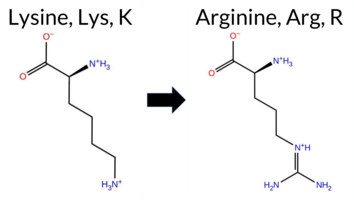 AIThe SynGAP1 missense variant K108R is listed in ClinVar with an “Uncertain” status and is present in gnomAD (ID 6‑33432188‑A‑G). Functional prediction tools that agree on a benign effect include REVEL, PROVEAN, SIFT, ESM1b, FATHMM, AlphaMissense‑Default, and AlphaMissense‑Optimized. In contrast, polyPhen‑2 (HumDiv and HumVar) predict a pathogenic impact. The SGM‑Consensus, derived from a majority vote of AlphaMissense‑Default, ESM1b, FATHMM, and PROVEAN, reports a “Likely Benign” classification. High‑accuracy assessments further support benignity: AlphaMissense‑Optimized is benign, and the SGM‑Consensus itself is benign; Foldetta results are unavailable. Overall, the majority of evidence points to a benign effect, and this conclusion does not contradict the ClinVar “Uncertain” designation. Disclaimer: This summary was generated using AI and should be interpreted alongside expert review. | Likely Benign | Uncertain | 1 | 6-33432188-A-G | 6 | 3.72e-6 | -2.892 | Likely Benign | 0.148 | Likely Benign | Likely Benign | 0.184 | Likely Benign | 0.37 | Neutral | 0.993 | Probably Damaging | 0.956 | Probably Damaging | 4.22 | Benign | 1.00 | Tolerated | 3.61 | 5 | 3 | 2 | -0.6 | 28.01 | |||||||||||||||||||||||||||
| c.458C>A | T153N 2D  AIThe SynGAP1 missense variant T153N is listed in ClinVar (ID 984906.0) with an “Uncertain” status and is not reported in gnomAD. Functional prediction tools largely agree on a benign effect: REVEL, PROVEAN, SIFT, ESM1b, FATHMM, AlphaMissense‑Default, and AlphaMissense‑Optimized all predict benign, while the SGM‑Consensus (majority vote from AlphaMissense‑Default, ESM1b, FATHMM, and PROVEAN) also indicates a likely benign outcome. In contrast, polyPhen‑2 (HumDiv and HumVar) predict pathogenic. High‑accuracy assessments show AlphaMissense‑Optimized as benign and the SGM‑Consensus as likely benign; Foldetta results are unavailable. Overall, the majority of evidence supports a benign classification, and this is consistent with the ClinVar “Uncertain” designation rather than contradicting it. Disclaimer: This summary was generated using AI and should be interpreted alongside expert review. | Likely Benign | Conflicting | 3 | -0.739 | Likely Benign | 0.226 | Likely Benign | Likely Benign | 0.161 | Likely Benign | 0.88 | Neutral | 0.888 | Possibly Damaging | 0.537 | Possibly Damaging | 4.23 | Benign | 0.81 | Tolerated | 3.61 | 5 | 0 | 0 | -2.8 | 13.00 | ||||||||||||||||||||||||||||||
| c.2381C>T | P794L 2D  AIThe SynGAP1 missense variant P794L is listed in ClinVar as Benign (ClinVar ID 859213.0) and is present in the gnomAD database (gnomAD ID 6‑33442933‑C‑T). Prediction tools that agree on a benign effect include REVEL, PROVEAN, polyPhen‑2 HumVar, ESM1b, FATHMM, AlphaMissense‑Default, and AlphaMissense‑Optimized. Tools that predict a pathogenic effect are polyPhen‑2 HumDiv and SIFT. The SGM‑Consensus, which is a majority vote of AlphaMissense‑Default, ESM1b, FATHMM, and PROVEAN, also reports a likely benign outcome. High‑accuracy assessments show AlphaMissense‑Optimized as benign, SGM‑Consensus as benign, while Foldetta (a protein‑folding stability method combining FoldX‑MD and Rosetta outputs) has no available result for this variant. Overall, the consensus of available predictions indicates that P794L is most likely benign, and this conclusion is consistent with its ClinVar status. Disclaimer: This summary was generated using AI and should be interpreted alongside expert review. | Likely Benign | SH3-binding motif | Benign/Likely benign | 2 | 6-33442933-C-T | 73 | 4.52e-5 | -3.808 | Likely Benign | 0.079 | Likely Benign | Likely Benign | 0.075 | Likely Benign | -0.80 | Neutral | 0.761 | Possibly Damaging | 0.321 | Benign | 4.24 | Benign | 0.03 | Affected | 4.07 | 3 | -3 | -3 | 5.4 | 16.04 | ||||||||||||||||||||||||||
| c.2578G>A | V860I 2D  AIThe SynGAP1 missense variant V860I is catalogued in ClinVar as a benign alteration (ClinVar ID 411591.0) and is present in the gnomAD database (gnomAD ID 6‑33443130‑G‑A). Prediction tools that agree on a benign effect include REVEL, PROVEAN, polyPhen‑2 (HumDiv and HumVar), ESM1b, FATHMM, AlphaMissense‑Default, and AlphaMissense‑Optimized. Only SIFT predicts a pathogenic outcome. High‑accuracy assessments further support a benign classification: AlphaMissense‑Optimized returns benign, and the SGM Consensus (majority vote from AlphaMissense‑Default, ESM1b, FATHMM, and PROVEAN) indicates “Likely Benign.” No Foldetta stability prediction is available for this variant. Overall, the consensus of computational evidence strongly favors a benign impact, aligning with the ClinVar designation and showing no contradiction. Disclaimer: This summary was generated using AI and should be interpreted alongside expert review. | Likely Benign | Benign | 1 | 6-33443130-G-A | 21 | 1.30e-5 | -4.516 | Likely Benign | 0.095 | Likely Benign | Likely Benign | 0.039 | Likely Benign | -0.42 | Neutral | 0.009 | Benign | 0.006 | Benign | 4.24 | Benign | 0.00 | Affected | 3.77 | 5 | 4 | 3 | 0.3 | 14.03 | |||||||||||||||||||||||||||
| c.2983C>T | P995S 2D  AIThe SynGAP1 missense variant P995S is listed in ClinVar (ID 436929.0) with an “Uncertain” status and is not reported in gnomAD. Prediction tools that agree on a benign effect include REVEL, PROVEAN, polyPhen‑2 (HumDiv and HumVar), ESM1b, FATHMM, AlphaMissense‑Default, AlphaMissense‑Optimized, and the SGM‑Consensus (majority vote of AlphaMissense‑Default, ESM1b, FATHMM, and PROVEAN). The only tool that predicts a pathogenic outcome is SIFT. High‑accuracy assessments further support a benign classification: AlphaMissense‑Optimized predicts benign, and the SGM‑Consensus also indicates “Likely Benign.” No Foldetta (FoldX‑MD/Rosetta) stability result is available, so it does not influence the assessment. Overall, the majority of predictions, including the high‑accuracy tools, point to a benign effect, which does not contradict the ClinVar “Uncertain” designation. Disclaimer: This summary was generated using AI and should be interpreted alongside expert review. | Likely Benign | Uncertain | 1 | -4.457 | Likely Benign | 0.071 | Likely Benign | Likely Benign | 0.042 | Likely Benign | -1.03 | Neutral | 0.011 | Benign | 0.015 | Benign | 4.24 | Benign | 0.00 | Affected | 4.32 | 1 | 1 | -1 | 0.8 | -10.04 | ||||||||||||||||||||||||||||||
| c.303C>A | H101Q 2D 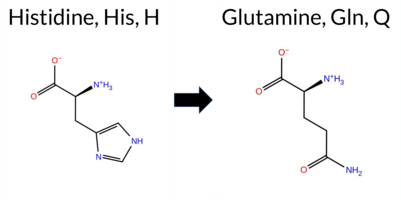 AIThe SynGAP1 missense variant H101Q is listed in ClinVar with an uncertain significance (ClinVar ID 1307533.0) and is present in gnomAD (ID 6‑33432168‑C‑A). Prediction tools that agree on a benign effect include REVEL, PROVEAN, ESM1b, FATHMM, AlphaMissense‑Default, and AlphaMissense‑Optimized. Tools that predict a pathogenic effect are polyPhen‑2 HumDiv, polyPhen‑2 HumVar, and SIFT. The SGM‑Consensus, derived from a majority vote of AlphaMissense‑Default, ESM1b, FATHMM, and PROVEAN, reports a likely benign classification. High‑accuracy assessments show AlphaMissense‑Optimized as benign and the SGM‑Consensus (majority vote) also benign; Foldetta stability analysis is unavailable. Overall, the majority of evidence points to a benign impact, and this is consistent with the ClinVar uncertain status rather than contradicting it. Disclaimer: This summary was generated using AI and should be interpreted alongside expert review. | Likely Benign | Uncertain | 1 | 6-33432168-C-A | 1 | 6.20e-7 | -2.827 | Likely Benign | 0.124 | Likely Benign | Likely Benign | 0.147 | Likely Benign | -0.37 | Neutral | 0.824 | Possibly Damaging | 0.880 | Possibly Damaging | 4.24 | Benign | 0.00 | Affected | 4.32 | 1 | 3 | 0 | -0.3 | -9.01 | |||||||||||||||||||||||||||
| c.3962C>A | P1321Q 2D 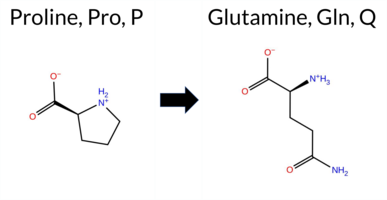 AIThe SynGAP1 missense variant P1321Q is listed in ClinVar (ID 833687.0) as benign and is present in gnomAD (variant ID 6‑33451836‑C‑A). Prediction tools that agree on a benign effect include REVEL, PROVEAN, polyPhen‑2 HumVar, SIFT, ESM1b, FATHMM, AlphaMissense‑Default, and AlphaMissense‑Optimized. Only polyPhen‑2 HumDiv predicts a pathogenic outcome. The high‑accuracy consensus from SGM (majority vote of AlphaMissense‑Default, ESM1b, FATHMM, and PROVEAN) yields a “Likely Benign” classification, and AlphaMissense‑Optimized also reports benign. Foldetta, a protein‑folding stability method combining FoldX‑MD and Rosetta outputs, has no available result for this variant. Overall, the majority of evidence—including the high‑confidence SGM consensus and AlphaMissense‑Optimized—supports a benign impact. This conclusion aligns with the ClinVar benign status, with no contradiction. Disclaimer: This summary was generated using AI and should be interpreted alongside expert review. | Likely Benign | Benign | 1 | 6-33451836-C-A | 1 | 6.58e-7 | -5.594 | Likely Benign | 0.079 | Likely Benign | Likely Benign | 0.055 | Likely Benign | -0.74 | Neutral | 0.659 | Possibly Damaging | 0.034 | Benign | 4.24 | Benign | 0.09 | Tolerated | 3.77 | 5 | 0 | -1 | -1.9 | 31.01 | |||||||||||||||||||||||||||
| c.286G>A | G96S 2D  AIThe SynGAP1 missense variant G96S is listed in ClinVar with an “Uncertain” status and is present in gnomAD (variant ID 6‑33425894‑G‑A). Prediction tools that agree on a benign effect include REVEL, PROVEAN, polyPhen‑2 (HumDiv and HumVar), ESM1b, FATHMM, AlphaMissense‑Default, AlphaMissense‑Optimized, and the SGM‑Consensus (majority vote from AlphaMissense‑Default, ESM1b, FATHMM, and PROVEAN). Only SIFT predicts a pathogenic outcome. High‑accuracy assessments show AlphaMissense‑Optimized as benign and the SGM‑Consensus as likely benign; Foldetta results are not available. Overall, the majority of evidence points to a benign impact, and this does not contradict the ClinVar “Uncertain” classification. Disclaimer: This summary was generated using AI and should be interpreted alongside expert review. | Likely Benign | Uncertain | 1 | 6-33425894-G-A | 5 | 3.10e-6 | -3.049 | Likely Benign | 0.065 | Likely Benign | Likely Benign | 0.071 | Likely Benign | -0.76 | Neutral | 0.364 | Benign | 0.008 | Benign | 4.25 | Benign | 0.00 | Affected | 4.32 | 1 | 1 | 0 | -0.4 | 30.03 | |||||||||||||||||||||||||||
| c.37A>G | I13V 2D  AIThe SynGAP1 I13V missense variant is listed in ClinVar (ID 3364831.0) with an “Uncertain” status and is not reported in gnomAD. Prediction tools that agree on a benign effect include REVEL, PROVEAN, polyPhen‑2 (HumDiv and HumVar), ESM1b, FATHMM, AlphaMissense‑Default, and AlphaMissense‑Optimized. Only SIFT predicts a pathogenic outcome. The SGM‑Consensus, derived from a majority vote of AlphaMissense‑Default, ESM1b, FATHMM, and PROVEAN, also indicates a likely benign effect. High‑accuracy assessments show AlphaMissense‑Optimized as benign and the SGM‑Consensus as benign; Foldetta results are unavailable. Overall, the preponderance of evidence points to a benign impact for I13V, and this conclusion does not conflict with the ClinVar “Uncertain” classification. Disclaimer: This summary was generated using AI and should be interpreted alongside expert review. | Likely Benign | Uncertain | 1 | -2.497 | Likely Benign | 0.105 | Likely Benign | Likely Benign | 0.110 | Likely Benign | 0.01 | Neutral | 0.000 | Benign | 0.000 | Benign | 4.25 | Benign | 0.00 | Affected | 4 | 3 | -0.3 | -14.03 | ||||||||||||||||||||||||||||||||
| c.3958C>T | P1320S 2D  AIThe SynGAP1 missense variant P1320S is listed in ClinVar (ID 469160.0) with an “Uncertain” clinical significance and is present in gnomAD (variant ID 6‑33451832‑C‑T). Functional prediction tools that agree on a benign effect include REVEL, PROVEAN, ESM1b, FATHMM, AlphaMissense‑Default, AlphaMissense‑Optimized, and the SGM‑Consensus (majority vote from AlphaMissense‑Default, ESM1b, FATHMM, PROVEAN). In contrast, polyPhen‑2 (HumDiv and HumVar) and SIFT predict a pathogenic impact. High‑accuracy assessments show AlphaMissense‑Optimized as benign and the SGM‑Consensus as likely benign; Foldetta results are unavailable. Overall, the majority of evidence points to a benign effect, and this is not in conflict with the ClinVar “Uncertain” status. Thus, the variant is most likely benign based on current predictions. Disclaimer: This summary was generated using AI and should be interpreted alongside expert review. | Likely Benign | Uncertain | 1 | 6-33451832-C-T | 2 | 1.28e-6 | -4.928 | Likely Benign | 0.073 | Likely Benign | Likely Benign | 0.097 | Likely Benign | -0.69 | Neutral | 0.980 | Probably Damaging | 0.968 | Probably Damaging | 4.25 | Benign | 0.00 | Affected | 3.77 | 5 | 1 | -1 | 0.8 | -10.04 | |||||||||||||||||||||||||||
| c.3979C>T | P1327S 2D  AIThe SynGAP1 missense variant P1327S is listed in ClinVar with an “Uncertain” status and is present in gnomAD (ID 6‑33451853‑C‑T). Functional prediction tools that agree on a benign effect include REVEL, PROVEAN, SIFT, ESM1b, FATHMM, AlphaMissense‑Default, AlphaMissense‑Optimized, and the SGM‑Consensus (majority vote from AlphaMissense‑Default, ESM1b, FATHMM, PROVEAN). In contrast, polyPhen‑2 (both HumDiv and HumVar models) predict a pathogenic outcome. High‑accuracy assessments show AlphaMissense‑Optimized as benign and the SGM‑Consensus as likely benign; the Foldetta protein‑folding stability analysis is unavailable for this variant. Overall, the majority of evidence points to a benign effect, and this conclusion does not contradict the ClinVar “Uncertain” classification. Disclaimer: This summary was generated using AI and should be interpreted alongside expert review. | Likely Benign | Uncertain | 1 | 6-33451853-C-T | -4.744 | Likely Benign | 0.131 | Likely Benign | Likely Benign | 0.092 | Likely Benign | 0.28 | Neutral | 0.980 | Probably Damaging | 0.857 | Possibly Damaging | 4.25 | Benign | 0.71 | Tolerated | 3.77 | 5 | 1 | -1 | 0.8 | -10.04 | |||||||||||||||||||||||||||||
| c.3G>A | M1I 2D 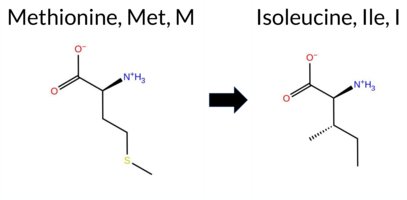 AIThe SynGAP1 missense variant M1I is listed in ClinVar (ID 833646.0) with an uncertain significance annotation and is not reported in gnomAD. Functional prediction tools largely agree on a benign effect: REVEL, PROVEAN, polyPhen‑2 HumDiv, polyPhen‑2 HumVar, ESM1b, and FATHMM all classify the substitution as benign, while SIFT uniquely predicts it to be pathogenic. The consensus score from the SGM framework, which aggregates AlphaMissense‑Default, ESM1b, FATHMM, and PROVEAN, reports a likely benign outcome. High‑accuracy predictors are incomplete: AlphaMissense‑Optimized and the Foldetta stability assessment are unavailable for this variant. Taking the collective evidence into account, the variant is most likely benign, and this assessment does not conflict with the ClinVar uncertain status. Disclaimer: This summary was generated using AI and should be interpreted alongside expert review. | Likely Benign | Conflicting | 3 | -5.397 | Likely Benign | 0.227 | Likely Benign | -0.17 | Neutral | 0.001 | Benign | 0.000 | Benign | 4.25 | Benign | 0.00 | Affected | 4.32 | 1 | 2 | 1 | 2.6 | -18.03 | |||||||||||||||||||||||||||||||||
| c.2987C>G | P996R 2D 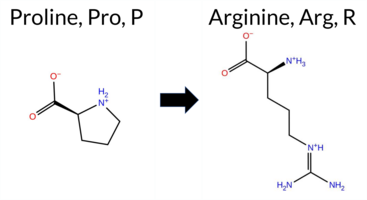 AIThe SynGAP1 missense variant P996R is listed in ClinVar (ID 2808854.0) as benign and is not reported in gnomAD. Prediction tools that agree on a benign effect include REVEL, PROVEAN, polyPhen‑2 (HumDiv and HumVar), ESM1b, FATHMM, AlphaMissense‑Default, AlphaMissense‑Optimized, and the SGM‑Consensus (majority vote from AlphaMissense‑Default, ESM1b, FATHMM, and PROVEAN). Only SIFT predicts a pathogenic outcome. High‑accuracy assessments show AlphaMissense‑Optimized as benign and the SGM‑Consensus as likely benign; Foldetta results are unavailable. Overall, the consensus of the majority of tools, including the high‑accuracy methods, indicates a benign impact. This prediction aligns with the ClinVar benign classification and does not contradict the existing clinical annotation. Disclaimer: This summary was generated using AI and should be interpreted alongside expert review. | Likely Benign | Benign | 1 | -4.457 | Likely Benign | 0.141 | Likely Benign | Likely Benign | 0.040 | Likely Benign | -1.04 | Neutral | 0.144 | Benign | 0.085 | Benign | 4.26 | Benign | 0.01 | Affected | 4.32 | 4 | -2 | 0 | -2.9 | 59.07 | ||||||||||||||||||||||||||||||
| c.3961C>T | P1321S 2D  AIThe SynGAP1 missense variant P1321S is listed in ClinVar (ID 1806027.0) with an “Uncertain” clinical significance and is present in the gnomAD database (gnomAD ID 6‑33451835‑C‑T). All evaluated in‑silico predictors classify the substitution as benign: REVEL, PROVEAN, PolyPhen‑2 (HumDiv and HumVar), SIFT, ESM1b, FATHMM, AlphaMissense‑Default, and AlphaMissense‑Optimized. No tool reports a pathogenic prediction. High‑accuracy assessments corroborate this benign trend: AlphaMissense‑Optimized predicts benign, and the SGM Consensus (majority vote of AlphaMissense‑Default, ESM1b, FATHMM, and PROVEAN) indicates “Likely Benign.” Foldetta, a protein‑folding stability method combining FoldX‑MD and Rosetta outputs, did not provide a result for this variant, so its status is unavailable. Overall, the computational evidence strongly supports a benign effect, which is consistent with the ClinVar “Uncertain” designation rather than contradicting it. Disclaimer: This summary was generated using AI and should be interpreted alongside expert review. | Likely Benign | Uncertain | 2 | 6-33451835-C-T | 10 | 6.46e-6 | -4.897 | Likely Benign | 0.077 | Likely Benign | Likely Benign | 0.049 | Likely Benign | 0.68 | Neutral | 0.028 | Benign | 0.004 | Benign | 4.27 | Benign | 0.71 | Tolerated | 3.77 | 5 | 1 | -1 | 0.8 | -10.04 | 10.1016/j.ajhg.2020.11.011 | ||||||||||||||||||||||||||
| c.597C>A | N199K 2D 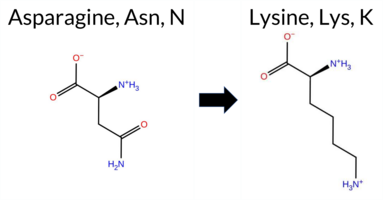 3DClick to see structure in 3D Viewer AISynGAP1 missense variant N199K is listed in ClinVar with an uncertain significance and is not reported in gnomAD. Functional prediction tools largely agree on a benign effect: REVEL, FoldX, Rosetta, Foldetta, premPS, PROVEAN, polyPhen‑2 (HumDiv and HumVar), SIFT, FATHMM, and AlphaMissense‑Optimized all classify the substitution as benign. Only ESM1b and AlphaMissense‑Default predict pathogenicity. High‑accuracy assessments show AlphaMissense‑Optimized as benign, Foldetta as benign, while the SGM Consensus (majority vote of AlphaMissense‑Default, ESM1b, FATHMM, PROVEAN) is inconclusive due to a 2‑to‑2 split. Overall, the preponderance of evidence supports a benign impact, which does not contradict the ClinVar uncertain status. Disclaimer: This summary was generated using AI and should be interpreted alongside expert review. | PH | Uncertain | 1 | -8.198 | Likely Pathogenic | 0.686 | Likely Pathogenic | Likely Benign | 0.024 | Likely Benign | -0.19 | Likely Benign | 0.1 | 0.03 | Likely Benign | -0.08 | Likely Benign | 0.33 | Likely Benign | -1.48 | Neutral | 0.276 | Benign | 0.083 | Benign | 4.27 | Benign | 0.13 | Tolerated | 3.47 | 9 | 1 | 0 | -0.4 | 14.07 | 207.8 | 21.5 | -0.1 | 1.5 | 0.1 | 0.0 | X | Uncertain | Asn199, located in the N-terminal loop before the first anti-parallel β sheet strand (res. Ile205-Pro208), is replaced by a positively charged lysine. On the protein surface, both the carboxamide group of Asn199 and the amino group of Lys199 side chains can form hydrogen bonds with the backbone carbonyl groups of residues (e.g., Ala249) at the end of an α helix (res. Ala236-Lys251). However, since the model ends abruptly at the N-terminus, no definite conclusions can be drawn from the simulations. | ||||||||||||
| c.59C>T | P20L 2D  AIThe SynGAP1 missense variant P20L (ClinVar ID 1185912.0) is listed as “Uncertain” in ClinVar and is not reported in gnomAD. Prediction tools that agree on a benign effect include REVEL, PROVEAN, ESM1b, FATHMM, AlphaMissense‑Optimized, and the SGM‑Consensus (majority vote from AlphaMissense‑Default, ESM1b, FATHMM, PROVEAN). Tools that predict a pathogenic effect are polyPhen‑2 HumDiv, polyPhen‑2 HumVar, and SIFT; AlphaMissense‑Default remains uncertain. High‑accuracy assessments show AlphaMissense‑Optimized as benign, the SGM‑Consensus as likely benign, and Foldetta results are unavailable. Overall, the majority of evidence points to a benign impact, and this conclusion does not contradict the ClinVar status, which remains uncertain. Disclaimer: This summary was generated using AI and should be interpreted alongside expert review. | Likely Benign | Uncertain | 3 | -3.289 | Likely Benign | 0.464 | Ambiguous | Likely Benign | 0.100 | Likely Benign | -0.44 | Neutral | 0.909 | Possibly Damaging | 0.713 | Possibly Damaging | 4.27 | Benign | 0.00 | Affected | 4.32 | 1 | -3 | -3 | 5.4 | 16.04 | ||||||||||||||||||||||||||||||
| c.2914C>T | P972S 2D  AIThe SynGAP1 missense variant P972S (ClinVar ID 3361353.0) is listed as Uncertain in ClinVar and is present in gnomAD (ID 6‑33443466‑C‑T). Consensus among most in silico predictors indicates a benign effect: REVEL, PROVEAN, polyPhen‑2 (HumDiv and HumVar), ESM1b, FATHMM, AlphaMissense‑Default, and AlphaMissense‑Optimized all score the substitution as benign. Only SIFT classifies it as pathogenic, representing the sole discordant prediction. High‑accuracy assessments further support a benign interpretation: AlphaMissense‑Optimized predicts benign, and the SGM Consensus (majority vote of AlphaMissense‑Default, ESM1b, FATHMM, and PROVEAN) reports “Likely Benign.” No Foldetta stability analysis is available for this residue. Overall, the preponderance of computational evidence points to a benign effect, which is consistent with the ClinVar designation of uncertainty rather than pathogenicity. Disclaimer: This summary was generated using AI and should be interpreted alongside expert review. | Likely Benign | Uncertain | 1 | 6-33443466-C-T | 4 | 2.48e-6 | -4.008 | Likely Benign | 0.058 | Likely Benign | Likely Benign | 0.074 | Likely Benign | -0.38 | Neutral | 0.001 | Benign | 0.002 | Benign | 4.28 | Benign | 0.05 | Affected | 4.32 | 2 | -1 | 1 | 0.8 | -10.04 | |||||||||||||||||||||||||||
| c.48G>A | M16I 2D  AIThe SynGAP1 missense variant M16I is listed in ClinVar with an “Uncertain” status (ClinVar ID 1424213.0) and is present in gnomAD (6‑33420312‑G‑A). Prediction tools that agree on a benign effect include REVEL, PROVEAN, polyPhen‑2 HumDiv, polyPhen‑2 HumVar, ESM1b, FATHMM, and AlphaMissense‑Optimized. Tools that predict a pathogenic effect are SIFT and AlphaMissense‑Default. The SGM‑Consensus, which aggregates the majority vote from AlphaMissense‑Default, ESM1b, FATHMM, and PROVEAN, reports a “Likely Benign” classification. High‑accuracy assessments show AlphaMissense‑Optimized as benign and the SGM‑Consensus as likely benign; Foldetta results are not available. Overall, the majority of evidence points to a benign impact, and this is consistent with the ClinVar “Uncertain” designation rather than contradicting it. Disclaimer: This summary was generated using AI and should be interpreted alongside expert review. | Likely Benign | Uncertain | 1 | 6-33420312-G-A | 1 | 6.49e-7 | -2.198 | Likely Benign | 0.722 | Likely Pathogenic | Likely Benign | 0.057 | Likely Benign | -0.15 | Neutral | 0.000 | Benign | 0.000 | Benign | 4.28 | Benign | 0.00 | Affected | 4.32 | 1 | 2 | 1 | 2.6 | -18.03 | |||||||||||||||||||||||||||
| c.127G>A | G43S 2D  AIThe SynGAP1 missense variant G43S is listed in ClinVar with an “Uncertain” status and is present in gnomAD (6‑33423536‑G‑A). Prediction tools that agree on a benign effect include REVEL, PROVEAN, polyPhen‑2 (HumDiv and HumVar), ESM1b, FATHMM, AlphaMissense‑Default, AlphaMissense‑Optimized, and the SGM‑Consensus (majority vote from AlphaMissense‑Default, ESM1b, FATHMM, and PROVEAN). Only SIFT predicts a pathogenic outcome. High‑accuracy assessments show AlphaMissense‑Optimized as benign and the SGM‑Consensus (derived from the same four high‑accuracy tools) also as benign; Foldetta results are unavailable. Based on the collective evidence, the variant is most likely benign, and this conclusion does not contradict the ClinVar “Uncertain” classification. Disclaimer: This summary was generated using AI and should be interpreted alongside expert review. | Likely Benign | Uncertain | 2 | 6-33423536-G-A | 1 | 6.20e-7 | -3.301 | Likely Benign | 0.078 | Likely Benign | Likely Benign | 0.057 | Likely Benign | -0.30 | Neutral | 0.162 | Benign | 0.096 | Benign | 4.29 | Benign | 0.00 | Affected | 4.32 | 1 | 1 | 0 | -0.4 | 30.03 | |||||||||||||||||||||||||||
| c.2914C>G | P972A 2D 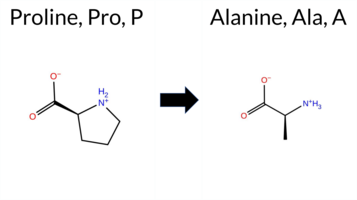 AIThe SynGAP1 missense variant P972A is listed in ClinVar with an uncertain significance (ClinVar ID 3172763.0) and is present in the gnomAD database (gnomAD ID 6‑33443466‑C‑G). All evaluated in‑silico predictors classify the substitution as benign: REVEL, PROVEAN, polyPhen‑2 HumDiv, polyPhen‑2 HumVar, SIFT, ESM1b, FATHMM, AlphaMissense‑Default, and AlphaMissense‑Optimized. No tool predicts pathogenicity. High‑accuracy assessments further support a benign outcome: AlphaMissense‑Optimized reports benign, and the SGM Consensus (majority vote of AlphaMissense‑Default, ESM1b, FATHMM, and PROVEAN) indicates “Likely Benign.” The Foldetta protein‑folding stability analysis is unavailable for this variant. Overall, the computational evidence strongly suggests the variant is most likely benign, and this conclusion does not contradict the current ClinVar status of uncertain significance. Disclaimer: This summary was generated using AI and should be interpreted alongside expert review. | Likely Benign | Uncertain | 1 | 6-33443466-C-G | 1 | 6.20e-7 | -0.167 | Likely Benign | 0.045 | Likely Benign | Likely Benign | 0.046 | Likely Benign | -0.89 | Neutral | 0.016 | Benign | 0.011 | Benign | 4.29 | Benign | 0.07 | Tolerated | 4.32 | 2 | -1 | 1 | 3.4 | -26.04 | |||||||||||||||||||||||||||
| c.2548G>A | G850R 2D  AIThe SynGAP1 missense variant G850R is listed in ClinVar with an uncertain significance (ClinVar ID 2042462.0) and is not reported in gnomAD. Prediction tools that classify the variant as benign include REVEL, PROVEAN, polyPhen‑2 HumDiv, polyPhen‑2 HumVar, ESM1b, FATHMM, AlphaMissense‑Optimized, and the SGM‑Consensus (majority vote). Only SIFT predicts a pathogenic effect, while AlphaMissense‑Default remains uncertain. High‑accuracy assessments show AlphaMissense‑Optimized labeling the variant as benign and the SGM‑Consensus indicating a likely benign outcome; Foldetta, a protein‑folding stability method, did not provide a result for this substitution. Overall, the preponderance of evidence points to a benign impact, which aligns with the ClinVar designation of uncertain significance rather than contradicting it. Disclaimer: This summary was generated using AI and should be interpreted alongside expert review. | Likely Benign | Uncertain | 1 | -5.082 | Likely Benign | 0.398 | Ambiguous | Likely Benign | 0.194 | Likely Benign | -0.07 | Neutral | 0.010 | Benign | 0.010 | Benign | 4.30 | Benign | 0.01 | Affected | 3.77 | 5 | -3 | -2 | -4.1 | 99.14 | ||||||||||||||||||||||||||||||
| c.603T>A | D201E 2D 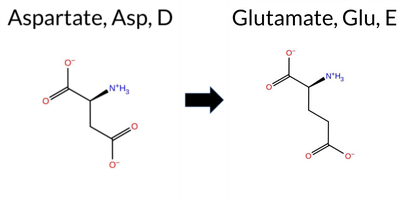 3DClick to see structure in 3D Viewer AIThe SynGAP1 D201E missense variant (ClinVar ID 3004688.0) is classified as **Benign** in ClinVar and is not reported in gnomAD. Prediction tools that agree on a benign effect include REVEL, FoldX, premPS, PROVEAN, polyPhen‑2 HumVar, SIFT, ESM1b, FATHMM, AlphaMissense‑Optimized, and the SGM‑Consensus (majority vote). Only polyPhen‑2 HumDiv predicts a pathogenic outcome, while Rosetta, Foldetta, and AlphaMissense‑Default are uncertain. High‑accuracy assessments show AlphaMissense‑Optimized as **Benign**, the SGM‑Consensus as **Likely Benign**, and Foldetta as **Uncertain**. Taken together, the overwhelming majority of evidence points to a benign impact, and this conclusion aligns with the ClinVar designation. Thus, the variant is most likely benign, with no contradiction to its ClinVar status. Disclaimer: This summary was generated using AI and should be interpreted alongside expert review. | Likely Benign | PH | Benign | 1 | -2.640 | Likely Benign | 0.406 | Ambiguous | Likely Benign | 0.165 | Likely Benign | 0.42 | Likely Benign | 0.2 | 1.99 | Ambiguous | 1.21 | Ambiguous | 0.23 | Likely Benign | -0.69 | Neutral | 0.633 | Possibly Damaging | 0.108 | Benign | 4.30 | Benign | 1.00 | Tolerated | 3.46 | 9 | 3 | 2 | 0.0 | 14.03 | 258.7 | -24.8 | 0.9 | 0.1 | -0.3 | 0.2 | X | Uncertain | Asp201, an acidic residue located in the N-terminal loop before the first anti-parallel β sheet strand (res. Ile205-Pro208), is replaced by another acidic residue, glutamate. The carboxylate groups of both Asp201 and Glu201 side chains form hydrogen bonds with the hydroxyl group of Ser221 in the simulations. Due to its shorter side chain, Asp201 can also hydrogen bond with the backbone amide groups of neighboring loop residues Ser204 and Asp203. However, since the model ends abruptly at the N-terminus, no definite conclusions can be drawn from the simulations. | |||||||||||
| c.603T>G | D201E 2D  3DClick to see structure in 3D Viewer AIThe SynGAP1 D201E missense variant (gnomAD ID 6‑33435245‑T‑G) is listed in ClinVar with an uncertain significance. Across a broad panel of in silico predictors, the majority indicate a benign effect: REVEL, FoldX, premPS, PROVEAN, polyPhen‑2 HumVar, SIFT, ESM1b, FATHMM, and AlphaMissense‑Optimized all score benign. Only polyPhen‑2 HumDiv predicts pathogenicity, while Rosetta, Foldetta, and AlphaMissense‑Default remain inconclusive. The SGM‑Consensus, derived from a majority vote of AlphaMissense‑Default, ESM1b, FATHMM, and PROVEAN, resolves to “likely benign.” High‑accuracy assessments further support a benign outcome: AlphaMissense‑Optimized is benign, SGM‑Consensus is likely benign, and Foldetta is inconclusive. Taken together, the preponderance of evidence points to a benign impact, which does not conflict with the ClinVar uncertain status. Disclaimer: This summary was generated using AI and should be interpreted alongside expert review. | Likely Benign | PH | Conflicting | 2 | 6-33435245-T-G | 20 | 1.24e-5 | -2.640 | Likely Benign | 0.406 | Ambiguous | Likely Benign | 0.165 | Likely Benign | 0.42 | Likely Benign | 0.2 | 1.99 | Ambiguous | 1.21 | Ambiguous | 0.23 | Likely Benign | -0.69 | Neutral | 0.633 | Possibly Damaging | 0.108 | Benign | 4.30 | Benign | 1.00 | Tolerated | 3.46 | 9 | 3 | 2 | 0.0 | 14.03 | 258.7 | -24.8 | 0.9 | 0.1 | -0.3 | 0.2 | X | Uncertain | Asp201, an acidic residue located in the N-terminal loop before the first anti-parallel β sheet strand (res. Ile205-Pro208), is replaced by another acidic residue, glutamate. The carboxylate groups of both Asp201 and Glu201 side chains form hydrogen bonds with the hydroxyl group of Ser221 in the simulations. Due to its shorter side chain, Asp201 can also hydrogen bond with the backbone amide groups of neighboring loop residues Ser204 and Asp203. However, since the model ends abruptly at the N-terminus, no definite conclusions can be drawn from the simulations. | ||||||||
| c.3970C>T | P1324S 2D  AIThe SynGAP1 missense variant P1324S is listed in ClinVar as Benign (ClinVar ID 1137951.0) and is present in gnomAD (ID 6‑33451844‑C‑T). Prediction tools that agree on a benign effect include REVEL, PROVEAN, polyPhen‑2 HumDiv, polyPhen‑2 HumVar, ESM1b, FATHMM, AlphaMissense‑Default, AlphaMissense‑Optimized, and the SGM‑Consensus (majority vote from AlphaMissense‑Default, ESM1b, FATHMM, and PROVEAN). Only SIFT predicts a pathogenic outcome. High‑accuracy assessments show AlphaMissense‑Optimized as benign and the SGM‑Consensus (majority vote) also benign; Foldetta results are unavailable. Based on the collective predictions, the variant is most likely benign, which is consistent with its ClinVar classification. Disclaimer: This summary was generated using AI and should be interpreted alongside expert review. | Likely Benign | Likely Benign | 1 | 6-33451844-C-T | 5 | 3.26e-6 | -5.451 | Likely Benign | 0.068 | Likely Benign | Likely Benign | 0.049 | Likely Benign | 0.35 | Neutral | 0.225 | Benign | 0.092 | Benign | 4.33 | Benign | 0.00 | Affected | 4.32 | 1 | 1 | -1 | 0.8 | -10.04 | |||||||||||||||||||||||||||
| c.59C>G | P20R 2D  AIThe SynGAP1 missense variant P20R is listed in ClinVar (ID 566521.0) with an “Uncertain” status and is not reported in gnomAD. Functional prediction tools that agree on a benign effect include REVEL, PROVEAN, ESM1b, FATHMM, AlphaMissense‑Optimized, and the SGM‑Consensus (majority vote from AlphaMissense‑Default, ESM1b, FATHMM, PROVEAN). Tools that predict a pathogenic outcome are polyPhen‑2 (HumDiv and HumVar) and SIFT. AlphaMissense‑Default remains uncertain. High‑accuracy assessments show AlphaMissense‑Optimized as benign and the SGM‑Consensus as likely benign; Foldetta results are unavailable. Overall, the majority of evidence points to a benign impact, and this conclusion does not contradict the current ClinVar “Uncertain” classification. Disclaimer: This summary was generated using AI and should be interpreted alongside expert review. | Likely Benign | Uncertain | 1 | -3.548 | Likely Benign | 0.434 | Ambiguous | Likely Benign | 0.146 | Likely Benign | -0.15 | Neutral | 0.972 | Probably Damaging | 0.804 | Possibly Damaging | 4.33 | Benign | 0.00 | Affected | 4.32 | 1 | 0 | -2 | -2.9 | 59.07 | ||||||||||||||||||||||||||||||
| c.86T>C | M29T 2D  AIThe SynGAP1 missense variant M29T is listed in ClinVar with an “Uncertain” status and is not reported in gnomAD. Prediction tools that agree on a benign effect include REVEL, PROVEAN, polyPhen‑2 (HumDiv and HumVar), ESM1b, FATHMM, AlphaMissense‑Default, and AlphaMissense‑Optimized. Only SIFT predicts a pathogenic outcome. The SGM‑Consensus, derived from a majority vote of AlphaMissense‑Default, ESM1b, FATHMM, and PROVEAN, reports the variant as “Likely Benign.” High‑accuracy assessments further support a benign classification: AlphaMissense‑Optimized is benign, and the SGM‑Consensus is also benign; Foldetta results are unavailable. Overall, the preponderance of evidence indicates that M29T is most likely benign, and this conclusion does not contradict the current ClinVar “Uncertain” designation. Disclaimer: This summary was generated using AI and should be interpreted alongside expert review. | Likely Benign | Uncertain | 1 | -2.167 | Likely Benign | 0.122 | Likely Benign | Likely Benign | 0.199 | Likely Benign | -0.37 | Neutral | 0.018 | Benign | 0.184 | Benign | 4.33 | Benign | 0.00 | Affected | 4.32 | 1 | -1 | -1 | -2.6 | -30.09 | ||||||||||||||||||||||||||||||
| c.3368G>A | G1123D 2D  AISynGAP1 missense variant G1123D is listed in ClinVar with an uncertain significance and is present in gnomAD (ID 6‑33443920‑G‑A). Functional prediction tools that agree on a benign effect include REVEL, PROVEAN, polyPhen‑2 HumVar, SIFT, FATHMM, AlphaMissense‑Optimized, and the SGM Consensus (derived from AlphaMissense‑Default, ESM1b, FATHMM, and PROVEAN). Tools that predict a pathogenic outcome are polyPhen‑2 HumDiv and ESM1b. AlphaMissense‑Default remains uncertain, and Foldetta results are unavailable. High‑accuracy assessments show AlphaMissense‑Optimized as benign, the SGM Consensus also benign, while Foldetta provides no data. Overall, the majority of evidence points to a benign effect, which does not contradict the ClinVar uncertain status. Disclaimer: This summary was generated using AI and should be interpreted alongside expert review. | Uncertain | 1 | 6-33443920-G-A | 2 | 1.33e-6 | -10.321 | Likely Pathogenic | 0.405 | Ambiguous | Likely Benign | 0.360 | Likely Benign | -0.78 | Neutral | 0.500 | Possibly Damaging | 0.157 | Benign | 4.34 | Benign | 0.19 | Tolerated | 3.77 | 5 | 1 | -1 | -3.1 | 58.04 | ||||||||||||||||||||||||||||
| c.3943T>C | W1315R 2D 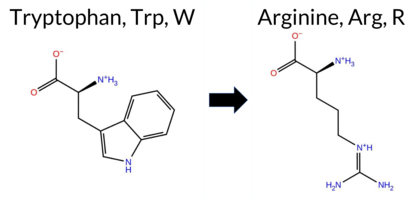 AIThe SynGAP1 missense variant W1315R is listed in ClinVar (ID 1029092.0) with an “Uncertain” clinical significance and is not reported in gnomAD. Functional prediction tools that agree on a benign effect include REVEL, PROVEAN, polyPhen‑2 (HumDiv and HumVar), SIFT, ESM1b, FATHMM, AlphaMissense‑Optimized, and the SGM‑Consensus score (which is a majority vote of AlphaMissense‑Default, ESM1b, FATHMM, and PROVEAN). Only AlphaMissense‑Default predicts a pathogenic outcome. High‑accuracy assessments show AlphaMissense‑Optimized as benign and the SGM‑Consensus as benign; Foldetta results are not available for this variant. Overall, the majority of evidence points to a benign impact, and this conclusion does not contradict the ClinVar “Uncertain” status. Disclaimer: This summary was generated using AI and should be interpreted alongside expert review. | Likely Benign | Uncertain | 1 | 0.205 | Likely Benign | 0.660 | Likely Pathogenic | Likely Benign | 0.114 | Likely Benign | 1.31 | Neutral | 0.000 | Benign | 0.001 | Benign | 4.37 | Benign | 0.91 | Tolerated | 3.77 | 5 | 2 | -3 | -3.6 | -30.03 | ||||||||||||||||||||||||||||||
| c.4021G>T | A1341S 2D  AIThe SynGAP1 missense variant A1341S is listed in ClinVar with an “Uncertain” status and is present in gnomAD (variant ID 6-33451895-G-T). All available in silico predictors agree on a benign effect: REVEL, PROVEAN, polyPhen‑2 (HumDiv and HumVar), SIFT, ESM1b, FATHMM, AlphaMissense‑Default, and AlphaMissense‑Optimized all return benign scores, and the SGM‑Consensus (majority vote of AlphaMissense‑Default, ESM1b, FATHMM, and PROVEAN) is “Likely Benign.” No tool predicts pathogenicity. High‑accuracy assessments corroborate this: AlphaMissense‑Optimized is benign, and the SGM‑Consensus is benign; Foldetta results are not available. Based on the collective predictions, the variant is most likely benign, and this conclusion does not contradict the ClinVar “Uncertain” classification. Disclaimer: This summary was generated using AI and should be interpreted alongside expert review. | Likely Benign | Uncertain | 1 | 6-33451895-G-T | -2.867 | Likely Benign | 0.078 | Likely Benign | Likely Benign | 0.099 | Likely Benign | 0.80 | Neutral | 0.000 | Benign | 0.001 | Benign | 4.40 | Benign | 1.00 | Tolerated | 3.77 | 5 | 1 | 1 | -2.6 | 16.00 | |||||||||||||||||||||||||||||
| c.82T>C | S28P 2D  AIThe SynGAP1 missense variant S28P is listed in ClinVar (ID 1500161.0) with an uncertain significance designation and is not reported in gnomAD. Functional prediction tools largely agree on a benign effect: REVEL, PROVEAN, polyPhen‑2 (HumDiv and HumVar), ESM1b, FATHMM, AlphaMissense‑Default, and AlphaMissense‑Optimized all predict benign, while only SIFT indicates a pathogenic effect. The SGM‑Consensus, derived from a majority vote of AlphaMissense‑Default, ESM1b, FATHMM, and PROVEAN, also reports a likely benign outcome. High‑accuracy assessments confirm this: AlphaMissense‑Optimized is benign and the SGM‑Consensus is likely benign; Foldetta stability analysis is unavailable. Overall, the collective evidence points to a benign classification for S28P, which is consistent with the ClinVar uncertain status rather than contradicting it. Disclaimer: This summary was generated using AI and should be interpreted alongside expert review. | Likely Benign | Uncertain | 1 | -3.309 | Likely Benign | 0.051 | Likely Benign | Likely Benign | 0.047 | Likely Benign | 1.37 | Neutral | 0.000 | Benign | 0.000 | Benign | 4.53 | Benign | 0.00 | Affected | 4.32 | 1 | 1 | -1 | -0.8 | 10.04 | ||||||||||||||||||||||||||||||
| c.2837G>A | G946E 2D 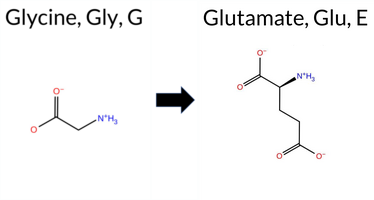 AIThe SynGAP1 missense variant G946E is listed in ClinVar (ID 1299783.0) as benign and is present in gnomAD (6‑33443389‑G‑A). Prediction tools that agree on a benign effect include REVEL, PROVEAN, polyPhen‑2 HumVar, FATHMM, AlphaMissense‑Default, and AlphaMissense‑Optimized, while polyPhen‑2 HumDiv, SIFT, and ESM1b predict a pathogenic outcome. The SGM‑Consensus, which aggregates AlphaMissense‑Default, ESM1b, FATHMM, and PROVEAN, reports a likely benign classification. High‑accuracy assessments show AlphaMissense‑Optimized as benign and the SGM‑Consensus as likely benign; Foldetta results are unavailable. Overall, the majority of evidence points to a benign impact, aligning with the ClinVar designation and showing no contradiction. Disclaimer: This summary was generated using AI and should be interpreted alongside expert review. | Likely Benign | Benign | 3 | 6-33443389-G-A | 13 | 8.05e-6 | -8.793 | Likely Pathogenic | 0.257 | Likely Benign | Likely Benign | 0.341 | Likely Benign | -0.51 | Neutral | 0.818 | Possibly Damaging | 0.355 | Benign | 4.58 | Benign | 0.00 | Affected | 4.32 | 4 | 0 | -2 | -3.1 | 72.06 | |||||||||||||||||||||||||||
| c.3374G>C | G1125A 2D 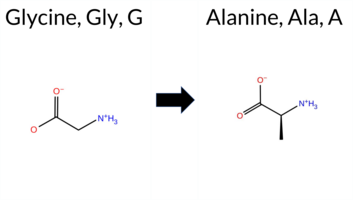 AIThe SynGAP1 missense variant G1125A is listed in ClinVar with an “Uncertain” status and is present in gnomAD (6‑33443926‑G‑C). Prediction tools that agree on a benign effect include REVEL, PROVEAN, SIFT, ESM1b, FATHMM, AlphaMissense‑Default, and AlphaMissense‑Optimized; the SGM‑Consensus (majority vote from AlphaMissense‑Default, ESM1b, FATHMM, and PROVEAN) also reports a likely benign outcome. In contrast, polyPhen‑2 (HumDiv and HumVar) predict a pathogenic effect. High‑accuracy assessments show AlphaMissense‑Optimized as benign, and the SGM‑Consensus (derived from the four high‑accuracy tools) is benign; Foldetta results are unavailable. Overall, the majority of evidence points to a benign impact, and this conclusion does not contradict the ClinVar “Uncertain” classification. Disclaimer: This summary was generated using AI and should be interpreted alongside expert review. | Likely Benign | Uncertain | 1 | 6-33443926-G-C | 1 | 6.68e-7 | -6.569 | Likely Benign | 0.083 | Likely Benign | Likely Benign | 0.232 | Likely Benign | -0.60 | Neutral | 0.999 | Probably Damaging | 0.995 | Probably Damaging | 4.60 | Benign | 0.11 | Tolerated | 3.77 | 5 | 1 | 0 | 2.2 | 14.03 | |||||||||||||||||||||||||||
| c.1153T>C | S385P 2D  3DClick to see structure in 3D Viewer AISynGAP1 variant S385P is listed in ClinVar with an uncertain significance and is present in gnomAD (variant ID 6-33438058‑T‑C). Prediction tools that classify the variant as benign include REVEL, Foldetta, premPS, PROVEAN, ESM1b, FATHMM, AlphaMissense‑Default, and AlphaMissense‑Optimized. Tools that predict pathogenicity are polyPhen‑2 HumDiv, polyPhen‑2 HumVar, and SIFT. Predictions from FoldX and Rosetta are inconclusive. High‑accuracy assessments show AlphaMissense‑Optimized as benign, the SGM Consensus (majority vote of AlphaMissense‑Default, ESM1b, FATHMM, PROVEAN) as likely benign, and Foldetta (combining FoldX‑MD and Rosetta outputs) as benign. Overall, the majority of computational evidence supports a benign effect, which is consistent with the ClinVar uncertain status and does not contradict it. Disclaimer: This summary was generated using AI and should be interpreted alongside expert review. | Likely Benign | C2 | Uncertain | 1 | 6-33438058-T-C | -5.431 | Likely Benign | 0.123 | Likely Benign | Likely Benign | 0.385 | Likely Benign | 0.91 | Ambiguous | 0.6 | -0.90 | Ambiguous | 0.01 | Likely Benign | 0.19 | Likely Benign | -0.26 | Neutral | 0.676 | Possibly Damaging | 0.693 | Possibly Damaging | 4.63 | Benign | 0.04 | Affected | 4.32 | 3 | 1 | -1 | -0.8 | 10.04 | 210.3 | 18.5 | 1.8 | 0.9 | 0.3 | 0.0 | Uncertain | Ser385 is located in the Gly-rich Ω loop (res. Pro364-Pro398) between two anti-parallel β sheet strands (res. Thr359-Pro364, res. Ala399-Ile411). Because the Ω loop is assumed to directly interact with the membrane, it moves arbitrarily throughout the WT solvent simulations. The Ω loop potentially plays a crucial role in the SynGAP-membrane complex association, stability, and dynamics. However, this aspect cannot be fully addressed through solvent simulations alone.Ω loops are known to play major roles in protein functions that require flexibility, and so they are rich in glycine residues, prolines, and, to a lesser extent, small hydrophilic residues to ensure maximum flexibility. Thus, the variant’s Pro385 is potentially tolerated in the Ω loop. However, since the effects on Gly-rich Ω loop dynamics can only be well studied through the SynGAP-membrane complex, no definite conclusions can be drawn. | |||||||||||
| c.1154C>G | S385W 2D 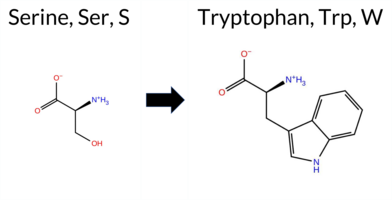 3DClick to see structure in 3D Viewer AIThe SynGAP1 missense variant S385W is listed in ClinVar as Benign (ClinVar ID 218691.0) and is present in gnomAD (ID 6‑33438059‑C‑G). Functional prediction tools that agree on a benign effect include REVEL, premPS, PROVEAN, FATHMM, AlphaMissense‑Optimized, and the SGM Consensus (majority vote from AlphaMissense‑Default, ESM1b, FATHMM, PROVEAN). Tools that predict a pathogenic effect are polyPhen‑2 HumDiv, polyPhen‑2 HumVar, SIFT, and ESM1b. Predictions that are inconclusive or unavailable are FoldX, Rosetta, Foldetta, and AlphaMissense‑Default. High‑accuracy assessments show AlphaMissense‑Optimized as Benign, the SGM Consensus as Benign, and Foldetta as Uncertain. Taken together, the majority of evidence points to a benign impact, which aligns with the ClinVar classification and does not contradict it. Disclaimer: This summary was generated using AI and should be interpreted alongside expert review. | C2 | Benign | 1 | 6-33438059-C-G | -9.353 | Likely Pathogenic | 0.362 | Ambiguous | Likely Benign | 0.373 | Likely Benign | 0.53 | Ambiguous | 0.2 | 0.69 | Ambiguous | 0.61 | Ambiguous | 0.00 | Likely Benign | -0.84 | Neutral | 0.986 | Probably Damaging | 0.968 | Probably Damaging | 4.63 | Benign | 0.00 | Affected | 4.32 | 3 | -2 | -3 | -0.1 | 99.14 | 260.4 | -71.2 | 0.5 | 1.3 | 0.7 | 0.4 | Uncertain | Ser385 is located in the Gly-rich Ω loop (res. Pro364-Pro398) between two anti-parallel β sheet strands (res. Thr359-Pro364, res. Ala399-Ile411). Because the Ω loop is assumed to directly interact with the membrane, it moves arbitrarily throughout the WT solvent simulations. The Ω loop potentially plays a crucial role in the SynGAP-membrane complex association, stability, and dynamics. However, this aspect cannot be fully addressed through solvent simulations alone.Ω loops are known to play major roles in protein functions that require flexibility, and thus hydrophobic residues like tryptophan are rarely tolerated. Although no major negative structural effects are observed in the variant simulations, Trp385 may exert drastic effects on the SynGAP-membrane complex dynamics and stability. However, since the effects on Gly-rich Ω loop dynamics can only be studied through the SynGAP-membrane complex, no definite conclusions can be drawn. | 10.1016/j.ajhg.2020.11.011 | |||||||||||
| c.1154C>T | S385L 2D 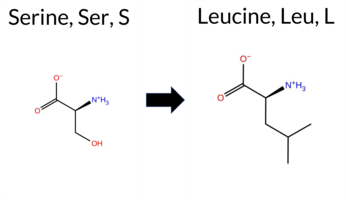 3DClick to see structure in 3D Viewer AIThe SynGAP1 missense variant S385L is listed in ClinVar with an “Uncertain” status and is present in gnomAD (ID 6‑33438059‑C‑T). Prediction tools that agree on a benign effect include REVEL, FoldX, Rosetta, Foldetta, premPS, PROVEAN, ESM1b, FATHMM, AlphaMissense‑Default, and AlphaMissense‑Optimized. Tools that predict a pathogenic effect are polyPhen‑2 HumDiv, polyPhen‑2 HumVar, and SIFT. The SGM‑Consensus (majority vote of AlphaMissense‑Default, ESM1b, FATHMM, PROVEAN) classifies the variant as “Likely Benign.” High‑accuracy assessments further support a benign outcome: AlphaMissense‑Optimized predicts benign; the SGM‑Consensus itself is benign; and Foldetta (combining FoldX‑MD and Rosetta outputs) predicts benign. Overall, the majority of computational evidence indicates the variant is most likely benign, which does not contradict the current ClinVar “Uncertain” classification. Disclaimer: This summary was generated using AI and should be interpreted alongside expert review. | Likely Benign | C2 | Uncertain | 2 | 6-33438059-C-T | 9 | 4.60e-5 | -6.018 | Likely Benign | 0.167 | Likely Benign | Likely Benign | 0.304 | Likely Benign | 0.16 | Likely Benign | 0.1 | 0.08 | Likely Benign | 0.12 | Likely Benign | -0.26 | Likely Benign | -0.68 | Neutral | 0.829 | Possibly Damaging | 0.706 | Possibly Damaging | 4.63 | Benign | 0.01 | Affected | 4.32 | 3 | -3 | -2 | 4.6 | 26.08 | 244.6 | -50.1 | 0.0 | 0.6 | -0.1 | 0.1 | Uncertain | Ser385 is located in the Gly-rich Ω loop (res. Pro364-Pro398) between two anti-parallel β sheet strands (res. Thr359-Pro364, res. Ala399-Ile411). Because the Ω loop is assumed to directly interact with the membrane, it moves arbitrarily throughout the WT solvent simulations. The Ω loop potentially plays a crucial role in the SynGAP-membrane complex association, stability, and dynamics. However, this aspect cannot be fully addressed through solvent simulations alone.Ω loops are known to play major roles in protein functions that require flexibility, and thus hydrophobic residues like leucine are rarely tolerated. Although no negative structural effects are observed in the variant simulations, Leu385 may exert drastic effects on the SynGAP-membrane complex dynamics and stability. However, since the effects on Gly-rich Ω loop dynamics can only be studied through the SynGAP-membrane complex, no definite conclusions can be drawn. | |||||||||
| c.1306G>A | E436K 2D  3DClick to see structure in 3D Viewer AIThe SynGAP1 missense variant E436K is listed in ClinVar with an uncertain significance and is not reported in gnomAD. Prediction tools that agree on a benign effect include only FATHMM, whereas the remaining evaluated algorithms (REVEL, Rosetta, PROVEAN, polyPhen‑2 HumDiv, polyPhen‑2 HumVar, SIFT, ESM1b, AlphaMissense‑Default, AlphaMissense‑Optimized, and the SGM‑Consensus) uniformly predict a pathogenic impact; FoldX, Foldetta, and premPS are inconclusive. High‑accuracy assessments show AlphaMissense‑Optimized as pathogenic, the SGM‑Consensus (majority vote of AlphaMissense‑Default, ESM1b, FATHMM, PROVEAN) as likely pathogenic, and Foldetta as uncertain. Overall, the preponderance of evidence points to a pathogenic effect for E436K, which does not conflict with the ClinVar designation of uncertain significance. Disclaimer: This summary was generated using AI and should be interpreted alongside expert review. | Likely Pathogenic | GAP | Uncertain | 1 | -13.869 | Likely Pathogenic | 0.997 | Likely Pathogenic | Likely Pathogenic | 0.829 | Likely Pathogenic | 0.56 | Ambiguous | 0.1 | 2.86 | Destabilizing | 1.71 | Ambiguous | 0.82 | Ambiguous | -3.77 | Deleterious | 0.994 | Probably Damaging | 0.951 | Probably Damaging | 4.71 | Benign | 0.02 | Affected | 3.37 | 29 | 0 | 1 | -0.4 | -0.94 | 186.8 | 39.8 | 0.0 | 0.0 | -0.2 | 0.0 | X | X | X | Potentially Pathogenic | The carboxylate group of Glu436, located on the α helix (res. Met414-Glu436), forms a salt bridge with the amino group of the Lys444 side chain on an opposing α helix (res. Val441-Ser457). The backbone carbonyl of Glu436 also H-bonds with the Lys444 side chain, which helps keep the ends of the two α helices tightly connected. In contrast, in the variant simulations, the salt bridge formation with Lys444 is not possible. Instead, the repelled Lys436 side chain rotates outward, causing a change in the α helix backbone H-bonding: the amide group of Lys444 H-bonds with the carbonyl of Ala433 instead of the carbonyl of Cys432. | |||||||||
| c.3376G>T | G1126C 2D 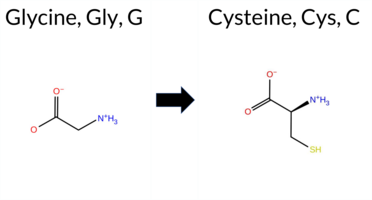 AIThe SynGAP1 missense variant G1126C is listed in ClinVar (ID 469157.0) with an “Uncertain” status and is present in gnomAD (6‑33443928‑G‑T). Prediction tools that agree on a benign effect include REVEL, PROVEAN, polyPhen‑2 (HumDiv and HumVar), FATHMM, AlphaMissense‑Default, AlphaMissense‑Optimized, and the SGM‑Consensus (majority vote). Tools that predict a pathogenic effect are SIFT and ESM1b. High‑accuracy assessments show AlphaMissense‑Optimized as benign and the SGM‑Consensus as likely benign; Foldetta results are unavailable. Overall, the majority of evidence points to a benign impact, and this is consistent with the ClinVar “Uncertain” classification rather than contradicting it. Disclaimer: This summary was generated using AI and should be interpreted alongside expert review. | Likely Benign | Uncertain | 1 | 6-33443928-G-T | 11 | 7.35e-6 | -9.389 | Likely Pathogenic | 0.113 | Likely Benign | Likely Benign | 0.449 | Likely Benign | -1.40 | Neutral | 0.005 | Benign | 0.005 | Benign | 4.74 | Benign | 0.02 | Affected | 3.77 | 5 | -3 | -3 | 2.9 | 46.09 | |||||||||||||||||||||||||||
| c.3377G>T | G1126V 2D 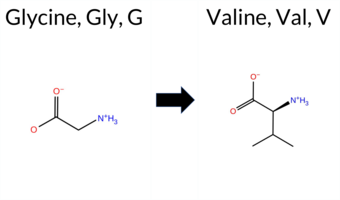 AIThe SynGAP1 missense variant G1126V is listed in ClinVar with an uncertain significance and is present in the gnomAD database. Consensus from multiple in‑silico predictors indicates a benign effect: REVEL, PROVEAN, polyPhen‑2 HumDiv, polyPhen‑2 HumVar, ESM1b, FATHMM, AlphaMissense‑Default, AlphaMissense‑Optimized, and the SGM‑Consensus score all classify the change as benign. Only the SIFT algorithm predicts a pathogenic outcome. High‑accuracy assessments further support a benign interpretation: AlphaMissense‑Optimized reports a benign effect, the SGM‑Consensus (majority vote of AlphaMissense‑Default, ESM1b, FATHMM, and PROVEAN) also indicates likely benign, while Foldetta’s protein‑folding stability analysis is unavailable. Overall, the preponderance of evidence points to a benign variant, which is consistent with the ClinVar uncertain status rather than contradicting it. Disclaimer: This summary was generated using AI and should be interpreted alongside expert review. | Likely Benign | Uncertain | 1 | 6-33443929-G-T | -6.536 | Likely Benign | 0.089 | Likely Benign | Likely Benign | 0.357 | Likely Benign | -1.20 | Neutral | 0.009 | Benign | 0.008 | Benign | 4.76 | Benign | 0.03 | Affected | 3.77 | 5 | -1 | -3 | 4.6 | 42.08 | |||||||||||||||||||||||||||||
| c.3370G>A | G1124R 2D  AISynGAP1 missense variant G1124R is listed in ClinVar with an uncertain significance and is present in gnomAD (ID 6‑33443922‑G‑A). Prediction tools that agree on a benign effect include REVEL, PROVEAN, polyPhen‑2 (HumDiv and HumVar), FATHMM, and AlphaMissense‑Optimized. Tools that predict a pathogenic effect are SIFT and ESM1b, while AlphaMissense‑Default remains uncertain. The SGM Consensus, derived from a majority vote of AlphaMissense‑Default, ESM1b, FATHMM, and PROVEAN, resolves to benign. High‑accuracy methods give AlphaMissense‑Optimized as benign; the SGM Consensus also supports benign. Foldetta, a protein‑folding stability predictor combining FoldX‑MD and Rosetta outputs, has no available result for this variant. Overall, the ensemble of predictions leans toward a benign impact, which does not contradict the ClinVar uncertain status. Disclaimer: This summary was generated using AI and should be interpreted alongside expert review. | Conflicting | 3 | 6-33443922-G-A | 24 | 1.60e-5 | -8.918 | Likely Pathogenic | 0.534 | Ambiguous | Likely Benign | 0.243 | Likely Benign | -0.58 | Neutral | 0.002 | Benign | 0.002 | Benign | 4.81 | Benign | 0.01 | Affected | 3.77 | 5 | -3 | -2 | -4.1 | 99.14 | ||||||||||||||||||||||||||||
| c.3380G>T | G1127V 2D  AIThe SynGAP1 missense variant G1127V is listed in ClinVar with an “Uncertain” status and is present in gnomAD (ID 6‑33443932‑G‑T). All available in silico predictors classify the change as benign: REVEL, PROVEAN, PolyPhen‑2 (HumDiv and HumVar), SIFT, ESM1b, FATHMM, AlphaMissense‑Default, and AlphaMissense‑Optimized. No tool reports a pathogenic prediction. Grouping by agreement, the benign‑predicting tools comprise the entire set, while no pathogenic predictions exist. High‑accuracy assessments reinforce this: AlphaMissense‑Optimized predicts benign, and the SGM Consensus (majority vote of AlphaMissense‑Default, ESM1b, FATHMM, and PROVEAN) indicates “Likely Benign.” Foldetta results are unavailable. Overall, the variant is most likely benign, and this conclusion does not contradict the ClinVar “Uncertain” classification. Disclaimer: This summary was generated using AI and should be interpreted alongside expert review. | Likely Benign | Uncertain | 1 | 6-33443932-G-T | 1 | 6.69e-7 | -6.097 | Likely Benign | 0.094 | Likely Benign | Likely Benign | 0.230 | Likely Benign | -1.01 | Neutral | 0.004 | Benign | 0.005 | Benign | 4.81 | Benign | 0.17 | Tolerated | 4.32 | 4 | -1 | -3 | 4.6 | 42.08 | |||||||||||||||||||||||||||
| c.3377G>A | G1126D 2D  AISynGAP1 missense variant G1126D is listed in ClinVar with an uncertain significance and is not reported in gnomAD. Functional prediction tools show a split opinion: benign predictions come from REVEL, PROVEAN, FATHMM, and AlphaMissense‑Optimized, whereas pathogenic predictions arise from polyPhen‑2 (HumDiv and HumVar), SIFT, and ESM1b. The AlphaMissense‑Default result is uncertain. High‑accuracy assessments further support a benign interpretation: AlphaMissense‑Optimized predicts benign, and the SGM Consensus—derived from a majority vote of AlphaMissense‑Default, ESM1b, FATHMM, and PROVEAN—also yields benign. Foldetta, a protein‑folding stability method that integrates FoldX‑MD and Rosetta outputs, has no available result for this variant. Overall, the preponderance of evidence points to a benign effect, which is consistent with the ClinVar uncertain status rather than contradicting it. Disclaimer: This summary was generated using AI and should be interpreted alongside expert review. | Uncertain | 1 | -8.888 | Likely Pathogenic | 0.432 | Ambiguous | Likely Benign | 0.376 | Likely Benign | -0.65 | Neutral | 0.906 | Possibly Damaging | 0.473 | Possibly Damaging | 4.82 | Benign | 0.02 | Affected | 3.77 | 5 | 1 | -1 | -3.1 | 58.04 | |||||||||||||||||||||||||||||||
| c.3380G>C | G1127A 2D  AIThe SynGAP1 missense variant G1127A is listed in ClinVar (ID 426748.0) with an uncertain significance status and is present in gnomAD (variant ID 6‑33443932‑G‑C). Functional prediction tools uniformly indicate a benign effect: REVEL, PROVEAN, polyPhen‑2 (HumDiv and HumVar), SIFT, ESM1b, FATHMM, AlphaMissense‑Default, and AlphaMissense‑Optimized all score the variant as benign. No tool predicts pathogenicity. The high‑accuracy consensus methods corroborate this: AlphaMissense‑Optimized is benign, and the SGM Consensus (majority vote of AlphaMissense‑Default, ESM1b, FATHMM, and PROVEAN) is “Likely Benign.” Foldetta, a protein‑folding stability predictor combining FoldX‑MD and Rosetta outputs, did not provide a result for this variant, so its status is unavailable. Overall, the evidence strongly supports a benign classification, which does not contradict the ClinVar uncertain status. Disclaimer: This summary was generated using AI and should be interpreted alongside expert review. | Likely Benign | Conflicting | 4 | 6-33443932-G-C | 4 | 2.68e-6 | -5.949 | Likely Benign | 0.080 | Likely Benign | Likely Benign | 0.164 | Likely Benign | -0.43 | Neutral | 0.001 | Benign | 0.002 | Benign | 4.83 | Benign | 1.00 | Tolerated | 4.32 | 4 | 1 | 0 | 2.2 | 14.03 | |||||||||||||||||||||||||||
| c.3379G>A | G1127R 2D  AIThe SynGAP1 missense variant G1127R is listed in ClinVar with an “Uncertain” status and is present in gnomAD (ID 6‑33443931‑G‑A). Prediction tools that agree on a benign effect include REVEL, PROVEAN, polyPhen‑2 (HumDiv and HumVar), SIFT, ESM1b, FATHMM, AlphaMissense‑Optimized, and the SGM‑Consensus (majority vote from AlphaMissense‑Default, ESM1b, FATHMM, PROVEAN). Only AlphaMissense‑Default predicts a pathogenic outcome. High‑accuracy assessments show AlphaMissense‑Optimized as benign and the SGM‑Consensus as likely benign; Foldetta results are unavailable. Overall, the majority of evidence points to a benign impact, and this conclusion does not contradict the ClinVar “Uncertain” classification. Disclaimer: This summary was generated using AI and should be interpreted alongside expert review. | Likely Benign | Uncertain | 1 | 6-33443931-G-A | 2 | 1.34e-6 | -5.949 | Likely Benign | 0.629 | Likely Pathogenic | Likely Benign | 0.341 | Likely Benign | -0.87 | Neutral | 0.001 | Benign | 0.001 | Benign | 4.86 | Benign | 0.12 | Tolerated | 4.32 | 4 | -2 | -3 | -4.1 | 99.14 | |||||||||||||||||||||||||||
| c.3379G>C | G1127R 2D  AIThe SynGAP1 missense variant G1127R is listed in ClinVar (ID 2967461.0) with an “Uncertain” clinical significance and is present in gnomAD (6‑33443931‑G‑C). Functional prediction tools that agree on a benign effect include REVEL, PROVEAN, polyPhen‑2 (HumDiv and HumVar), SIFT, ESM1b, FATHMM, and AlphaMissense‑Optimized. Only AlphaMissense‑Default predicts a pathogenic outcome. The SGM‑Consensus, derived from a majority vote of AlphaMissense‑Default, ESM1b, FATHMM, and PROVEAN, classifies the variant as “Likely Benign.” High‑accuracy assessments further support a benign interpretation: AlphaMissense‑Optimized is benign, and the SGM‑Consensus is likely benign; Foldetta results are not available. Overall, the preponderance of evidence indicates that G1127R is most likely benign, which does not contradict the ClinVar status of uncertainty. Disclaimer: This summary was generated using AI and should be interpreted alongside expert review. | Likely Benign | Conflicting | 2 | 6-33443931-G-C | 16 | 1.07e-5 | -5.949 | Likely Benign | 0.629 | Likely Pathogenic | Likely Benign | 0.341 | Likely Benign | -0.87 | Neutral | 0.001 | Benign | 0.001 | Benign | 4.86 | Benign | 0.12 | Tolerated | 4.32 | 4 | -2 | -3 | -4.1 | 99.14 | |||||||||||||||||||||||||||
| c.3364G>A | G1122S 2D  AIThe SynGAP1 missense variant G1122S is listed in ClinVar as a benign alteration (ClinVar ID 643187.0) and is present in gnomAD (gnomAD ID 6‑33443916‑G‑A). Prediction tools that agree on a benign effect include REVEL, PROVEAN, polyPhen‑2 (HumDiv and HumVar), SIFT, ESM1b, FATHMM, AlphaMissense‑Default, and AlphaMissense‑Optimized. No tool in the dataset predicts a pathogenic outcome. High‑accuracy assessments further support a benign classification: AlphaMissense‑Optimized predicts benign, the SGM Consensus (majority vote from AlphaMissense‑Default, ESM1b, FATHMM, and PROVEAN) indicates likely benign, while Foldetta’s protein‑folding stability result is unavailable. Overall, the variant is most likely benign, and this assessment is consistent with its ClinVar status. Disclaimer: This summary was generated using AI and should be interpreted alongside expert review. | Likely Benign | Benign/Likely benign | 2 | 6-33443916-G-A | 27 | 1.79e-5 | -4.880 | Likely Benign | 0.072 | Likely Benign | Likely Benign | 0.189 | Likely Benign | -0.08 | Neutral | 0.022 | Benign | 0.006 | Benign | 4.89 | Benign | 0.92 | Tolerated | 3.77 | 5 | 1 | 0 | -0.4 | 30.03 | |||||||||||||||||||||||||||
| c.2840G>C | G947A 2D  AIThe SynGAP1 missense variant G947A is listed in ClinVar (ID 1595137.0) as Benign and is present in gnomAD (6‑33443392‑G‑C). Prediction tools that assess sequence conservation and functional impact (REVEL, PROVEAN, polyPhen‑2 HumDiv, polyPhen‑2 HumVar, SIFT, ESM1b, FATHMM) all classify the variant as Benign. The AlphaMissense suite likewise reports Benign for both its Default and Optimized models. The SGM‑Consensus, which aggregates the majority vote from AlphaMissense‑Default, ESM1b, FATHMM, and PROVEAN, also indicates Likely Benign. No tool in the dataset predicts pathogenicity. High‑accuracy structural assessment via AlphaMissense‑Optimized confirms a Benign prediction, while the SGM‑Consensus result is consistent. Foldetta, a protein‑folding stability method combining FoldX‑MD and Rosetta outputs, has no reported result for this variant, so its status is unavailable. Overall, the computational evidence overwhelmingly supports a benign effect, aligning with the ClinVar designation and showing no contradiction. Disclaimer: This summary was generated using AI and should be interpreted alongside expert review. | Likely Benign | Likely Benign | 1 | 6-33443392-G-C | 28 | 1.73e-5 | -6.511 | Likely Benign | 0.080 | Likely Benign | Likely Benign | 0.156 | Likely Benign | -0.41 | Neutral | 0.224 | Benign | 0.131 | Benign | 4.97 | Benign | 0.10 | Tolerated | 4.32 | 4 | 1 | 0 | 2.2 | 14.03 | |||||||||||||||||||||||||||
| c.2835T>A | H945Q 2D  AIThe SynGAP1 missense variant H945Q is listed in ClinVar with an uncertain significance and is present in gnomAD (ID 6‑33443387‑T‑A). Prediction tools that agree on a benign effect include REVEL, PROVEAN, SIFT, ESM1b, FATHMM, AlphaMissense‑Default, and AlphaMissense‑Optimized. Tools that predict a pathogenic effect are polyPhen‑2 HumDiv and polyPhen‑2 HumVar. The high‑accuracy consensus from AlphaMissense‑Optimized is benign, and the SGM consensus—derived from the majority vote of AlphaMissense‑Default, ESM1b, FATHMM, and PROVEAN—is also benign. Foldetta results are not available for this variant. Overall, the majority of computational evidence points to a benign impact, which is consistent with the ClinVar uncertain status rather than contradicting it. Disclaimer: This summary was generated using AI and should be interpreted alongside expert review. | Likely Benign | Conflicting | 2 | 6-33443387-T-A | 3 | 1.86e-6 | -5.248 | Likely Benign | 0.091 | Likely Benign | Likely Benign | 0.343 | Likely Benign | -0.36 | Neutral | 0.995 | Probably Damaging | 0.939 | Probably Damaging | 5.03 | Benign | 0.06 | Tolerated | 4.32 | 4 | 3 | 0 | -0.3 | -9.01 | |||||||||||||||||||||||||||
| c.3354C>A | S1118R 2D  AIThe SynGAP1 missense variant S1118R (ClinVar ID 2656489.0) is listed as ClinVar status Uncertain and is not present in gnomAD. Prediction tools that agree on a benign effect include REVEL, PROVEAN, polyPhen‑2 HumDiv, polyPhen‑2 HumVar, ESM1b, FATHMM, AlphaMissense‑Optimized, and the SGM‑Consensus (majority vote of AlphaMissense‑Default, ESM1b, FATHMM, PROVEAN). Only SIFT predicts a pathogenic effect, while AlphaMissense‑Default remains uncertain. High‑accuracy assessments show AlphaMissense‑Optimized as benign and the SGM‑Consensus as Likely Benign; Foldetta stability analysis is unavailable. Overall, the majority of evidence points to a benign impact, and this is consistent with the ClinVar Uncertain designation rather than contradicting it. Disclaimer: This summary was generated using AI and should be interpreted alongside expert review. | Likely Benign | Uncertain | 1 | -2.670 | Likely Benign | 0.553 | Ambiguous | Likely Benign | 0.166 | Likely Benign | -0.74 | Neutral | 0.034 | Benign | 0.023 | Benign | 5.17 | Benign | 0.05 | Affected | 4.32 | 2 | -1 | 0 | -3.7 | 69.11 | ||||||||||||||||||||||||||||||
| c.3170G>A | S1057N 2D  AIThe SynGAP1 missense variant S1057N is listed in ClinVar with an “Uncertain” status and is not reported in gnomAD. All available in‑silico predictors classify the change as benign: REVEL, PROVEAN, polyPhen‑2 (HumDiv and HumVar), SIFT, ESM1b, FATHMM, AlphaMissense‑Default, and AlphaMissense‑Optimized all return benign scores, and the SGM‑Consensus (majority vote of AlphaMissense‑Default, ESM1b, FATHMM, and PROVEAN) indicates “Likely Benign.” No tool predicts pathogenicity. High‑accuracy assessments confirm this: AlphaMissense‑Optimized is benign, SGM‑Consensus is likely benign, while Foldetta (combining FoldX‑MD and Rosetta outputs) has no available result for this variant. Overall, the computational evidence overwhelmingly supports a benign effect, and this is consistent with the ClinVar “Uncertain” classification rather than contradicting it. Disclaimer: This summary was generated using AI and should be interpreted alongside expert review. | Likely Benign | Uncertain | 1 | -6.386 | Likely Benign | 0.117 | Likely Benign | Likely Benign | 0.218 | Likely Benign | -0.41 | Neutral | 0.451 | Benign | 0.129 | Benign | 5.25 | Benign | 0.28 | Tolerated | 1 | 1 | -2.7 | 27.03 | ||||||||||||||||||||||||||||||||
| c.3410A>C | H1137P 2D  AIThe SynGAP1 missense variant H1137P is listed in ClinVar as a benign alteration (ClinVar ID 3685596.0) and is present in the gnomAD database (gnomAD ID 6‑33444445‑A‑C). Functional prediction tools that agree on a benign effect include REVEL, PROVEAN, ESM1b, FATHMM, AlphaMissense‑Default, AlphaMissense‑Optimized, and the SGM‑Consensus (majority vote from AlphaMissense‑Default, ESM1b, FATHMM, and PROVEAN). In contrast, polyPhen‑2 (HumDiv and HumVar) and SIFT predict a pathogenic impact. High‑accuracy assessments show AlphaMissense‑Optimized as benign and the SGM‑Consensus (derived from the same four high‑accuracy predictors) also indicates benign. No Foldetta (FoldX‑MD/Rosetta stability) result is available for this variant. Overall, the majority of predictions, including the most reliable tools, support a benign classification, which is consistent with the ClinVar status. Disclaimer: This summary was generated using AI and should be interpreted alongside expert review. | Likely Benign | Benign | 1 | 6-33444445-A-C | 12 | 7.44e-6 | -2.098 | Likely Benign | 0.054 | Likely Benign | Likely Benign | 0.419 | Likely Benign | -1.93 | Neutral | 0.925 | Possibly Damaging | 0.703 | Possibly Damaging | 5.29 | Benign | 0.00 | Affected | 4.32 | 4 | -2 | 0 | 1.6 | -40.02 | |||||||||||||||||||||||||||
| c.3567G>C | E1189D 2D  AIThe SynGAP1 missense variant E1189D (gnomAD ID 6-33444602‑G‑C) is listed in ClinVar as Benign (ClinVar ID 833989.0). In silico predictors that agree on a benign effect include REVEL, PROVEAN, SIFT, ESM1b, FATHMM, AlphaMissense‑Optimized, and the SGM‑Consensus score (Likely Benign). Predictors that indicate a pathogenic effect are PolyPhen‑2 HumDiv and PolyPhen‑2 HumVar. The high‑accuracy AlphaMissense‑Optimized tool classifies the variant as benign, and the SGM‑Consensus, derived from a majority vote of AlphaMissense‑Default, ESM1b, FATHMM, and PROVEAN, also favors a benign outcome. No Foldetta stability assessment is available for this residue. Overall, the majority of evidence points to a benign impact, and this conclusion aligns with the ClinVar designation, showing no contradiction. Disclaimer: This summary was generated using AI and should be interpreted alongside expert review. | Likely Benign | Coiled-coil | Likely Benign | 1 | 6-33444602-G-C | 3 | 1.86e-6 | -3.582 | Likely Benign | 0.461 | Ambiguous | Likely Benign | 0.359 | Likely Benign | -1.42 | Neutral | 0.992 | Probably Damaging | 0.989 | Probably Damaging | 5.30 | Benign | 0.25 | Tolerated | 3.82 | 4 | 3 | 2 | 0.0 | -14.03 | ||||||||||||||||||||||||||
| c.1199T>A | V400E 2D 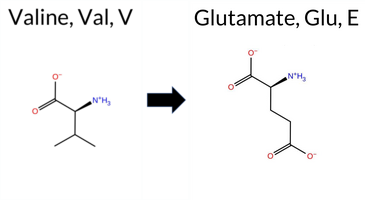 3DClick to see structure in 3D Viewer AIThe SynGAP1 missense variant V400E is listed in ClinVar with an “Uncertain” status and is not reported in gnomAD. Prediction tools that indicate a benign effect are polyPhen‑2 HumVar and FATHMM; all other evaluated algorithms (REVEL, FoldX, Rosetta, Foldetta, premPS, PROVEAN, polyPhen‑2 HumDiv, SIFT, ESM1b, AlphaMissense‑Default, and the SGM‑Consensus) predict a pathogenic impact. High‑accuracy assessments further support a deleterious outcome: AlphaMissense‑Optimized scores the variant as pathogenic, the SGM‑Consensus (majority vote from AlphaMissense‑Default, ESM1b, FATHMM, and PROVEAN) labels it “Likely Pathogenic,” and Foldetta (combining FoldX‑MD and Rosetta outputs) predicts a pathogenic effect. Based on the preponderance of pathogenic predictions, the variant is most likely pathogenic, which does not contradict its current ClinVar “Uncertain” classification. Disclaimer: This summary was generated using AI and should be interpreted alongside expert review. | Likely Pathogenic | C2 | Uncertain | 1 | -13.686 | Likely Pathogenic | 0.998 | Likely Pathogenic | Likely Pathogenic | 0.810 | Likely Pathogenic | 3.70 | Destabilizing | 0.2 | 2.46 | Destabilizing | 3.08 | Destabilizing | 2.29 | Destabilizing | -4.88 | Deleterious | 0.920 | Possibly Damaging | 0.335 | Benign | 5.31 | Benign | 0.00 | Affected | 3.38 | 27 | -2 | -2 | -7.7 | 29.98 | 249.1 | -38.8 | -0.1 | 0.1 | 1.0 | 0.0 | X | X | X | Potentially Pathogenic | The iso-propyl side chain of Val400, located in an anti-parallel β sheet strand (res. Ala399-Ile411), hydrophobically packs against hydrophobic residues within the anti-parallel β sheet of the C2 domain (e.g., Ile268, Ala404, Leu325, Leu402). In the variant simulations, the negatively charged carboxylate group of the Glu400 side chain is not suitable for occupying the hydrophobic niche. Consequently, the side chain escapes the center of the C2 domain and interacts with the backbone amide groups of Leu402 in the same β strand and/or Ile269 and Glu270 in a neighboring β strand (res. Arg259-Arg272). This residue swap disrupts the hydrophobic packing and generally has extensive negative effects on the C2 domain structure. At a minimum, the residue swap could affect the C2 domain stability and membrane association. | |||||||||
| c.3508A>G | S1170G 2D  AIThe SynGAP1 missense variant S1170G is listed in ClinVar with an “Uncertain” status and is not reported in gnomAD. Functional prediction tools that agree on benign impact include REVEL, PROVEAN, polyPhen‑2 (HumDiv and HumVar), SIFT, ESM1b, FATHMM, AlphaMissense‑Default, and AlphaMissense‑Optimized. No tool in the dataset predicts pathogenicity, so the pathogenic group is empty. High‑accuracy assessments further support a benign classification: AlphaMissense‑Optimized predicts benign, the SGM Consensus (majority vote from AlphaMissense‑Default, ESM1b, FATHMM, and PROVEAN) also predicts benign, while Foldetta results are unavailable. Based on the collective predictions, the variant is most likely benign, and this conclusion does not contradict the ClinVar “Uncertain” designation. Disclaimer: This summary was generated using AI and should be interpreted alongside expert review. | Likely Benign | Coiled-coil | Uncertain | 1 | -4.288 | Likely Benign | 0.221 | Likely Benign | Likely Benign | 0.349 | Likely Benign | -0.81 | Neutral | 0.241 | Benign | 0.229 | Benign | 5.31 | Benign | 0.54 | Tolerated | 4.32 | 4 | 1 | 0 | 0.4 | -30.03 | |||||||||||||||||||||||||||||
| c.3511_3512delinsTG | A1171C 2D 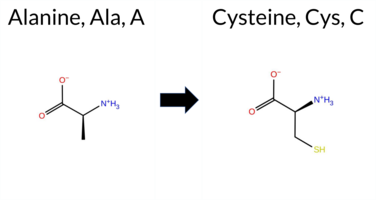 AIThe SynGAP1 missense variant A1171C (ClinVar ID 1723483.0) is listed as “Uncertain” in ClinVar and is not present in gnomAD. Prediction tools that converge on a benign outcome include PROVEAN, ESM1b, FATHMM, and AlphaMissense‑Optimized, all of which report a benign or neutral effect. In contrast, PolyPhen‑2 (HumDiv and HumVar) and SIFT uniformly predict a pathogenic impact. The SGM‑Consensus, derived from a majority vote of AlphaMissense‑Default, ESM1b, FATHMM, and PROVEAN, is “Likely Benign,” reinforcing the benign signal. High‑accuracy assessments show AlphaMissense‑Optimized as benign, the SGM‑Consensus (majority vote) as benign, and Foldetta results are unavailable. Overall, the majority of evidence points to a benign effect, which does not contradict the ClinVar “Uncertain” classification. Disclaimer: This summary was generated using AI and should be interpreted alongside expert review. | Likely Benign | Coiled-coil | Uncertain | 1 | -5.363 | Likely Benign | 0.496 | Ambiguous | Likely Benign | -1.16 | Neutral | 0.978 | Probably Damaging | 0.825 | Possibly Damaging | 5.32 | Benign | 0.02 | Affected | 4.32 | 4 | -2 | 0 | 0.7 | 32.06 | |||||||||||||||||||||||||||||||
| c.1198G>C | V400L 2D 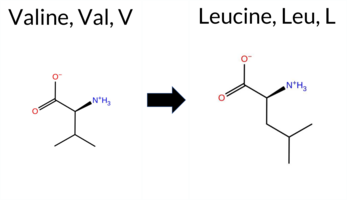 3DClick to see structure in 3D Viewer AIThe SynGAP1 missense variant V400L is listed in ClinVar as Benign (ClinVar ID 1166313.0) and is present in gnomAD (variant ID 6‑33438103‑G‑C). Prediction tools that agree on a benign effect include REVEL, Rosetta, Foldetta, premPS, PROVEAN, polyPhen‑2 (HumDiv and HumVar), SIFT, ESM1b, FATHMM, AlphaMissense‑Default, and AlphaMissense‑Optimized. No tool predicts a pathogenic outcome; the only inconclusive result is from FoldX, which is treated as unavailable. High‑accuracy assessments confirm benignity: AlphaMissense‑Optimized is benign; the SGM Consensus (majority vote of AlphaMissense‑Default, ESM1b, FATHMM, PROVEAN) is benign; and Foldetta, which integrates FoldX‑MD and Rosetta outputs, is benign. Overall, the computational evidence strongly supports a benign classification, consistent with the ClinVar status. Disclaimer: This summary was generated using AI and should be interpreted alongside expert review. | Likely Benign | C2 | Benign | 1 | 6-33438103-G-C | 22 | 1.36e-5 | -1.000 | Likely Benign | 0.137 | Likely Benign | Likely Benign | 0.325 | Likely Benign | -0.71 | Ambiguous | 0.2 | 0.39 | Likely Benign | -0.16 | Likely Benign | -0.29 | Likely Benign | -0.60 | Neutral | 0.001 | Benign | 0.001 | Benign | 5.33 | Benign | 0.64 | Tolerated | 3.38 | 27 | 2 | 1 | -0.4 | 14.03 | 251.0 | -30.1 | 0.0 | 0.0 | 0.7 | 0.1 | X | Potentially Benign | The iso-propyl side chain of Val400, located in an anti-parallel β sheet strand (res. Ala399-Ile411), hydrophobically packs against hydrophobic residues within the anti-parallel β sheet of the C2 domain (e.g., Ile268, Ala404, Leu325, Leu402). Val400 is swapped for another hydrophobic residue, leucine, whose branched hydrocarbon side chain is of a comparable size and thus packs favorably within the C2 domain. In short, the residue swap has no apparent negative effect on the structure based on the variant simulations. | 10.1016/j.ajhg.2020.11.011 | |||||||
| c.3172G>A | G1058S 2D  AIThe SynGAP1 missense variant G1058S is listed in ClinVar with an “Uncertain” status and is present in gnomAD (variant ID 6-33443724-G-A). Prediction tools that agree on a benign effect include REVEL, PROVEAN, polyPhen‑2 HumDiv, polyPhen‑2 HumVar, ESM1b, FATHMM, AlphaMissense‑Default, AlphaMissense‑Optimized, and the SGM‑Consensus (Likely Benign). Only SIFT predicts a pathogenic outcome. High‑accuracy assessments further support a benign classification: AlphaMissense‑Optimized is benign, and the SGM‑Consensus (derived from the majority vote of AlphaMissense‑Default, ESM1b, FATHMM, and PROVEAN) is also benign. Foldetta results are unavailable. Overall, the majority of computational evidence indicates that the variant is most likely benign, and this conclusion does not contradict the ClinVar “Uncertain” designation. Disclaimer: This summary was generated using AI and should be interpreted alongside expert review. | Likely Benign | Conflicting | 3 | 6-33443724-G-A | 114 | 7.08e-5 | -5.178 | Likely Benign | 0.081 | Likely Benign | Likely Benign | 0.108 | Likely Benign | 0.26 | Neutral | 0.001 | Benign | 0.001 | Benign | 5.38 | Benign | 0.04 | Affected | 3.77 | 5 | 1 | 0 | -0.4 | 30.03 | |||||||||||||||||||||||||||
| c.3394T>C | S1132P 2D  AIThe SynGAP1 missense variant S1132P is listed in ClinVar with an uncertain significance (ClinVar ID 1341927.0) and is present in the gnomAD database (gnomAD ID 6‑33443946‑T‑C). All available in‑silico predictors uniformly classify the substitution as benign: REVEL, PROVEAN, polyPhen‑2 (HumDiv and HumVar), SIFT, ESM1b, FATHMM, AlphaMissense‑Default, and AlphaMissense‑Optimized all report benign or likely benign outcomes. No tool in the dataset predicts pathogenicity. High‑accuracy assessments corroborate this: AlphaMissense‑Optimized is benign, and the SGM Consensus (majority vote of AlphaMissense‑Default, ESM1b, FATHMM, and PROVEAN) is “Likely Benign.” Foldetta, a protein‑folding stability method combining FoldX‑MD and Rosetta outputs, did not provide a result for this variant, so its status is unavailable. Overall, the computational evidence strongly supports a benign effect, which is consistent with the ClinVar uncertain classification rather than contradicting it. Disclaimer: This summary was generated using AI and should be interpreted alongside expert review. | Likely Benign | Conflicting | 3 | 6-33443946-T-C | 1 | 6.74e-7 | -1.423 | Likely Benign | 0.144 | Likely Benign | Likely Benign | 0.301 | Likely Benign | 0.38 | Neutral | 0.003 | Benign | 0.006 | Benign | 5.40 | Benign | 0.28 | Tolerated | 4.32 | 4 | 1 | -1 | -0.8 | 10.04 | |||||||||||||||||||||||||||
| c.3395C>A | S1132Y 2D 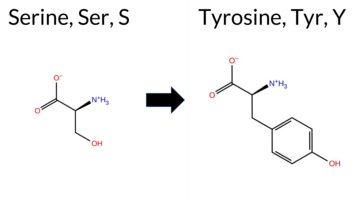 AIThe SynGAP1 missense variant S1132Y is listed in ClinVar as a benign alteration (ClinVar ID 845357.0) and is not reported in gnomAD. Prediction tools that agree on a benign effect include REVEL, PROVEAN, polyPhen‑2 HumVar, SIFT, ESM1b, FATHMM, AlphaMissense‑Optimized, and the SGM‑Consensus (majority vote from AlphaMissense‑Default, ESM1b, FATHMM, PROVEAN). Only polyPhen‑2 HumDiv predicts a pathogenic outcome, while AlphaMissense‑Default remains uncertain. High‑accuracy assessments show AlphaMissense‑Optimized as benign and the SGM‑Consensus as likely benign; Foldetta stability analysis is unavailable. Overall, the majority of evidence supports a benign classification, which aligns with the ClinVar status and does not contradict it. Disclaimer: This summary was generated using AI and should be interpreted alongside expert review. | Likely Benign | Likely Benign | 1 | -5.894 | Likely Benign | 0.392 | Ambiguous | Likely Benign | 0.401 | Likely Benign | -1.76 | Neutral | 0.500 | Possibly Damaging | 0.208 | Benign | 5.40 | Benign | 0.09 | Tolerated | 4.32 | 4 | -3 | -2 | -0.5 | 76.10 | ||||||||||||||||||||||||||||||
| c.3633G>A | M1211I 2D  AIThe SynGAP1 missense variant M1211I is listed in ClinVar with an “Uncertain” status and is present in gnomAD (variant ID 6-33446625-G-A). Prediction tools that agree on a benign effect include REVEL, PROVEAN, SIFT, ESM1b, FATHMM, and AlphaMissense‑Optimized. Tools that predict a pathogenic effect are AlphaMissense‑Default, polyPhen‑2 HumDiv, and polyPhen‑2 HumVar. The SGM‑Consensus, derived from a majority vote of AlphaMissense‑Default, ESM1b, FATHMM, and PROVEAN, reports a “Likely Benign” classification. Foldetta, a protein‑folding stability method combining FoldX‑MD and Rosetta outputs, has no available result for this variant. High‑accuracy predictions therefore point to a benign outcome: AlphaMissense‑Optimized is benign, and the SGM‑Consensus also indicates benign. Based on the aggregate predictions, the variant is most likely benign, which does not contradict the ClinVar “Uncertain” status. Disclaimer: This summary was generated using AI and should be interpreted alongside expert review. | Likely Benign | Coiled-coil | Uncertain | 1 | 6-33446625-G-A | 3 | 1.86e-6 | -1.537 | Likely Benign | 0.764 | Likely Pathogenic | Likely Benign | 0.298 | Likely Benign | -0.42 | Neutral | 0.969 | Probably Damaging | 0.968 | Probably Damaging | 5.40 | Benign | 1.00 | Tolerated | 3.77 | 5 | 1 | 2 | 2.6 | -18.03 | ||||||||||||||||||||||||||
| c.1121C>A | S374Y 2D  3DClick to see structure in 3D Viewer AISynGAP1 missense variant S374Y is listed in ClinVar with an uncertain significance and is not reported in gnomAD. Functional prediction tools that agree on a benign effect include REVEL, premPS, PROVEAN, FATHMM, AlphaMissense‑Optimized, and polyPhen‑2 HumVar, whereas polyPhen‑2 HumDiv and SIFT predict a pathogenic impact. Uncertain calls come from FoldX, Rosetta, Foldetta, ESM1b, and AlphaMissense‑Default. High‑accuracy assessments show AlphaMissense‑Optimized predicts a benign outcome; the SGM Consensus (derived from AlphaMissense‑Default, ESM1b, FATHMM, and PROVEAN) is inconclusive, and Foldetta likewise yields an uncertain stability change. Overall, the majority of available predictions favor a benign effect, and this does not contradict the ClinVar uncertain status. Disclaimer: This summary was generated using AI and should be interpreted alongside expert review. | C2 | Uncertain | 1 | -7.774 | In-Between | 0.344 | Ambiguous | Likely Benign | 0.310 | Likely Benign | 0.71 | Ambiguous | 1.2 | 0.66 | Ambiguous | 0.69 | Ambiguous | -0.02 | Likely Benign | -1.18 | Neutral | 0.875 | Possibly Damaging | 0.271 | Benign | 5.41 | Benign | 0.01 | Affected | 4.32 | 13 | -3 | -2 | -0.5 | 76.10 | 237.3 | -76.9 | 0.5 | 0.4 | 0.5 | 0.3 | Uncertain | Ser374 is located in the Gly-rich Ω loop (res. Pro364-Pro398) between two anti-parallel β sheet strands (res. Thr359-Pro364, res. Ala399-Ile411). Because the Ω loop is assumed to directly interact with the membrane, it moves arbitrarily throughout the WT solvent simulations. The Ω loop potentially plays a crucial role in the SynGAP-membrane complex association, stability, and dynamics. However, this aspect cannot be fully addressed through solvent simulations alone.Ω loops are known to play major roles in protein functions that require flexibility, and thus, large and relatively hydrophobic residues like tyrosine are rarely tolerated. Additionally, the hydroxyl group of Tyr374 frequently forms various hydrogen bonds with other loop residues in the variant simulations. Although no negative structural effects are observed in the variant simulations, Tyr374 may exert drastic effects on the SynGAP-membrane complex dynamics and stability. However, since the effect on Gly-rich Ω loop dynamics can only be studied through the SynGAP-membrane complex, no definite conclusions can be drawn. | |||||||||||||
| c.1195G>A | A399T 2D  3DClick to see structure in 3D Viewer AIThe SynGAP1 missense variant A399T is listed in ClinVar (ID 1990638.0) as Benign and is not reported in gnomAD. Prediction tools that agree on a benign effect include REVEL, premPS, PROVEAN, polyPhen‑2 (HumDiv and HumVar), SIFT, ESM1b, FATHMM, AlphaMissense‑Default, and AlphaMissense‑Optimized. No tool predicts a pathogenic outcome; the only inconclusive results come from FoldX, Rosetta, and Foldetta, which are treated as unavailable evidence. High‑accuracy assessments show AlphaMissense‑Optimized as Benign, the SGM Consensus (majority vote of AlphaMissense‑Default, ESM1b, FATHMM, PROVEAN) as Likely Benign, and Foldetta as Uncertain. Overall, the variant is most likely benign, and this conclusion aligns with its ClinVar benign classification. Disclaimer: This summary was generated using AI and should be interpreted alongside expert review. | Likely Benign | C2 | Benign | 1 | -5.236 | Likely Benign | 0.114 | Likely Benign | Likely Benign | 0.272 | Likely Benign | 1.24 | Ambiguous | 0.1 | 0.91 | Ambiguous | 1.08 | Ambiguous | 0.49 | Likely Benign | -0.40 | Neutral | 0.131 | Benign | 0.039 | Benign | 5.41 | Benign | 0.69 | Tolerated | 3.38 | 26 | 1 | 0 | -2.5 | 30.03 | 211.4 | -41.4 | 0.0 | 0.0 | 0.6 | 0.4 | X | Potentially Pathogenic | The methyl group of Ala399, located in an anti-parallel β sheet strand (res. Ala399-Ile411), is swapped for a hydroxyl-containing threonine. In the variant simulations, the hydroxyl group of Thr399 can form H-bonds with the backbone atoms of the residues in the membrane-facing loops (e.g., Gly382) in the C2 domain. Consequently, the ability of the Thr399 side chain to form H-bonds with the membrane-facing loops could adversely affect the dynamics and stability of the SynGAP-membrane association. However, since the effects on the dynamics of the membrane-facing loops can only be studied through the SynGAP-membrane complex, no definite conclusions can be drawn. | |||||||||||
| c.3413C>A | S1138Y 2D  AIThe SynGAP1 missense variant S1138Y is listed in ClinVar with an “Uncertain” significance and is present in gnomAD (ID 6‑33444448‑C‑A). Prediction tools that agree on a benign effect include REVEL, ESM1b, FATHMM, AlphaMissense‑Optimized, and the SGM Consensus (majority vote from AlphaMissense‑Default, ESM1b, FATHMM, and PROVEAN). Tools that predict a pathogenic effect are PROVEAN, polyPhen‑2 HumDiv, polyPhen‑2 HumVar, and SIFT. AlphaMissense‑Default is uncertain, and Foldetta (a protein‑folding stability method combining FoldX‑MD and Rosetta outputs) has no available result for this variant. High‑accuracy predictions from AlphaMissense‑Optimized and the SGM Consensus both indicate a benign outcome, while Foldetta data are missing. Overall, the balance of evidence—especially from the high‑accuracy tools—suggests that the variant is most likely benign. This benign prediction does not contradict the ClinVar status, which remains uncertain. Disclaimer: This summary was generated using AI and should be interpreted alongside expert review. | Uncertain | 1 | 6-33444448-C-A | 3 | 1.86e-6 | -6.610 | Likely Benign | 0.449 | Ambiguous | Likely Benign | 0.391 | Likely Benign | -2.51 | Deleterious | 0.997 | Probably Damaging | 0.996 | Probably Damaging | 5.41 | Benign | 0.05 | Affected | 4.32 | 4 | -2 | -3 | -0.5 | 76.10 | ||||||||||||||||||||||||||||
| c.3405G>C | K1135N 2D 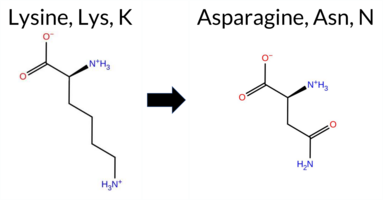 AIThe SynGAP1 missense variant K1135N is listed in ClinVar (ID 633521.0) with an “Uncertain” status and is not reported in gnomAD. Prediction tools that agree on a benign effect include SGM‑Consensus (Likely Benign), REVEL, PROVEAN, polyPhen‑2 (HumDiv and HumVar), SIFT, ESM1b, and FATHMM. In contrast, AlphaMissense‑Default and AlphaMissense‑Optimized both predict a pathogenic outcome. High‑accuracy assessments further show AlphaMissense‑Optimized as pathogenic, while the SGM‑Consensus (derived from a majority vote of AlphaMissense‑Default, ESM1b, FATHMM, and PROVEAN) remains Likely Benign. No Foldetta (FoldX‑MD/Rosetta stability) result is available for this variant. Overall, the majority of predictions support a benign classification, which does not contradict the current ClinVar “Uncertain” designation. Disclaimer: This summary was generated using AI and should be interpreted alongside expert review. | Likely Benign | Uncertain | 1 | -5.715 | Likely Benign | 0.960 | Likely Pathogenic | Likely Pathogenic | 0.166 | Likely Benign | -0.97 | Neutral | 0.411 | Benign | 0.321 | Benign | 5.43 | Benign | 0.07 | Tolerated | 4.32 | 2 | 1 | 0 | 0.4 | -14.07 | ||||||||||||||||||||||||||||||
| c.3631A>G | M1211V 2D  AIThe SynGAP1 missense variant M1211V is listed in ClinVar as Benign (ClinVar ID 3674914.0) and is present in gnomAD (ID 6‑33446623‑A‑G). Prediction tools that agree on a benign effect include REVEL, PROVEAN, SIFT, ESM1b, FATHMM, AlphaMissense‑Default, AlphaMissense‑Optimized, and the SGM‑Consensus (Likely Benign). Tools that predict a pathogenic effect are polyPhen‑2 HumDiv and polyPhen‑2 HumVar. High‑accuracy assessments show AlphaMissense‑Optimized as benign, the SGM‑Consensus as Likely Benign, and Foldetta results are unavailable. Overall, the majority of evidence points to a benign impact, aligning with the ClinVar classification and not contradicting it. Disclaimer: This summary was generated using AI and should be interpreted alongside expert review. | Likely Benign | Coiled-coil | Benign | 1 | 6-33446623-A-G | 3 | 1.86e-6 | -2.101 | Likely Benign | 0.258 | Likely Benign | Likely Benign | 0.412 | Likely Benign | -0.29 | Neutral | 0.932 | Possibly Damaging | 0.949 | Probably Damaging | 5.43 | Benign | 0.72 | Tolerated | 3.77 | 5 | 1 | 2 | 2.3 | -32.06 | ||||||||||||||||||||||||||
| c.3386T>C | L1129P 2D 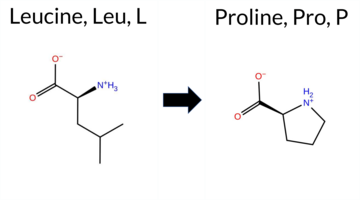 AIThe SynGAP1 missense variant L1129P is listed in ClinVar with an “Uncertain” status and is not reported in gnomAD. Functional prediction tools that agree on a benign effect include REVEL, PROVEAN, ESM1b, FATHMM, AlphaMissense‑Default, and AlphaMissense‑Optimized. In contrast, polyPhen‑2 (HumDiv and HumVar) and SIFT all predict a pathogenic impact. The SGM‑Consensus, which aggregates the majority vote from AlphaMissense‑Default, ESM1b, FATHMM, and PROVEAN, reports the variant as “Likely Benign.” High‑accuracy assessments further support a benign classification: AlphaMissense‑Optimized predicts benign, and the SGM‑Consensus (majority vote) also indicates benign. The Foldetta protein‑folding stability analysis is unavailable for this variant. Overall, the majority of evidence—including high‑accuracy tools—points to a benign effect, and this conclusion does not contradict the current ClinVar “Uncertain” status. Disclaimer: This summary was generated using AI and should be interpreted alongside expert review. | Likely Benign | Uncertain | 2 | -2.991 | Likely Benign | 0.154 | Likely Benign | Likely Benign | 0.432 | Likely Benign | 0.27 | Neutral | 0.971 | Probably Damaging | 0.773 | Possibly Damaging | 5.44 | Benign | 0.00 | Affected | 4.32 | 4 | -3 | -3 | -5.4 | -16.04 | ||||||||||||||||||||||||||||||
| c.3487C>G | H1163D 2D 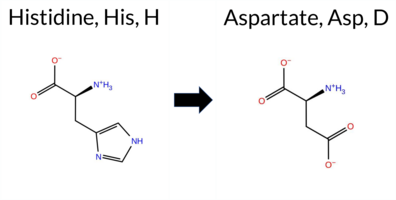 AISynGAP1 missense variant H1163D is listed in ClinVar with an uncertain significance and is not reported in gnomAD. Functional prediction tools show a split: benign calls come from REVEL, SIFT, ESM1b, and FATHMM, while pathogenic calls come from PROVEAN, polyPhen‑2 HumDiv, polyPhen‑2 HumVar, and AlphaMissense‑Default. High‑accuracy assessments are inconclusive: AlphaMissense‑Optimized rates the variant as uncertain, the SGM Consensus (majority vote of AlphaMissense‑Default, ESM1b, FATHMM, PROVEAN) yields a tie and is therefore unavailable, and Foldetta folding‑stability analysis is not provided. With an equal number of benign and pathogenic predictions and no decisive high‑accuracy evidence, the variant remains ambiguous. Thus, it is most likely neither clearly benign nor pathogenic, and this uncertainty aligns with its ClinVar status of uncertain significance. Disclaimer: This summary was generated using AI and should be interpreted alongside expert review. | Uncertain | 1 | -2.107 | Likely Benign | 0.949 | Likely Pathogenic | Ambiguous | 0.476 | Likely Benign | -2.60 | Deleterious | 0.991 | Probably Damaging | 0.991 | Probably Damaging | 5.44 | Benign | 0.31 | Tolerated | 3.88 | 3 | 1 | -1 | -0.3 | -22.05 | |||||||||||||||||||||||||||||||
| c.3529G>A | E1177K 2D  AISynGAP1 missense variant E1177K is listed in ClinVar with an Uncertain significance status and is not reported in gnomAD. Functional prediction tools show a split: benign calls come from PROVEAN, SIFT, ESM1b, and FATHMM, while pathogenic calls come from REVEL, polyPhen‑2 HumDiv, polyPhen‑2 HumVar, and AlphaMissense‑Default. High‑accuracy assessments give AlphaMissense‑Optimized as Uncertain, SGM‑Consensus (majority vote of AlphaMissense‑Default, ESM1b, FATHMM, PROVEAN) as Likely Benign, and Foldetta stability analysis is unavailable. Overall, the balance of evidence leans toward a benign effect, which does not contradict the ClinVar designation of Uncertain. Disclaimer: This summary was generated using AI and should be interpreted alongside expert review. | Likely Benign | Coiled-coil | Uncertain | 1 | -3.413 | Likely Benign | 0.944 | Likely Pathogenic | Ambiguous | 0.560 | Likely Pathogenic | -1.75 | Neutral | 0.905 | Possibly Damaging | 0.637 | Possibly Damaging | 5.44 | Benign | 0.11 | Tolerated | 4.32 | 2 | 0 | 1 | -0.4 | -0.94 | |||||||||||||||||||||||||||||
| c.3511G>A | A1171T 2D  AIThe SynGAP1 missense variant A1171T is listed in ClinVar with an “Uncertain” status and is not reported in gnomAD. All available in‑silico predictors classify the change as benign: REVEL, PROVEAN, PolyPhen‑2 (HumDiv and HumVar), SIFT, ESM1b, FATHMM, AlphaMissense‑Default, and AlphaMissense‑Optimized. The SGM‑Consensus, which aggregates AlphaMissense‑Default, ESM1b, FATHMM, and PROVEAN, also reports a “Likely Benign” outcome. No tool predicts pathogenicity. High‑accuracy assessments confirm the benign prediction: AlphaMissense‑Optimized is benign, and the SGM‑Consensus is likely benign; Foldetta results are unavailable. Based on the collective predictions, the variant is most likely benign, and this assessment does not contradict the ClinVar “Uncertain” classification. Disclaimer: This summary was generated using AI and should be interpreted alongside expert review. | Likely Benign | Coiled-coil | Uncertain | 1 | -3.658 | Likely Benign | 0.149 | Likely Benign | Likely Benign | 0.201 | Likely Benign | -0.48 | Neutral | 0.245 | Benign | 0.138 | Benign | 5.45 | Benign | 0.07 | Tolerated | 4.32 | 4 | 1 | 0 | -2.5 | 30.03 | |||||||||||||||||||||||||||||
| c.1131G>A | M377I 2D  3DClick to see structure in 3D Viewer AIThe SynGAP1 missense variant M377I (ClinVar ID 3803473.0, status = Uncertain) is present in gnomAD (ID = 6‑33438036‑G‑A). Functional prediction tools that agree on a benign effect include REVEL, premPS, PROVEAN, polyPhen‑2 (HumDiv and HumVar), SIFT, ESM1b, FATHMM, AlphaMissense‑Default, and AlphaMissense‑Optimized. No tool in the dataset predicts a pathogenic outcome. High‑accuracy assessments further support a benign interpretation: AlphaMissense‑Optimized is benign, the SGM Consensus (majority vote of AlphaMissense‑Default, ESM1b, FATHMM, PROVEAN) is “Likely Benign,” while Foldetta (combining FoldX‑MD and Rosetta outputs) is inconclusive. Overall, the computational evidence strongly favors a benign classification, which does not contradict the ClinVar status of Uncertain. Disclaimer: This summary was generated using AI and should be interpreted alongside expert review. | Likely Benign | C2 | Uncertain | 1 | 6-33438036-G-A | 1 | 6.23e-7 | -2.895 | Likely Benign | 0.212 | Likely Benign | Likely Benign | 0.227 | Likely Benign | 0.76 | Ambiguous | 0.3 | 0.54 | Ambiguous | 0.65 | Ambiguous | 0.24 | Likely Benign | -0.41 | Neutral | 0.000 | Benign | 0.001 | Benign | 5.46 | Benign | 0.26 | Tolerated | 4.32 | 12 | 1 | 2 | 2.6 | -18.03 | |||||||||||||||||
| c.2852A>G | H951R 2D  AIThe SynGAP1 missense variant H951R is listed in ClinVar as Pathogenic (ClinVar ID 1003739.0) and is not reported in gnomAD. Functional prediction tools uniformly classify the variant as benign: REVEL, PROVEAN, polyPhen‑2 (HumDiv and HumVar), SIFT, ESM1b, FATHMM, AlphaMissense‑Default, and AlphaMissense‑Optimized all return benign scores. The SGM‑Consensus, derived from a majority vote of AlphaMissense‑Default, ESM1b, FATHMM, and PROVEAN, also indicates a likely benign effect. No tool predicts pathogenicity. High‑accuracy assessments corroborate this: AlphaMissense‑Optimized is benign, and the SGM‑Consensus is likely benign. The Foldetta protein‑folding stability analysis is unavailable for this variant. Based on the collective predictions, the variant is most likely benign, which contradicts its ClinVar pathogenic classification. Disclaimer: This summary was generated using AI and should be interpreted alongside expert review. | Likely Benign | Likely Pathogenic | 1 | -4.964 | Likely Benign | 0.125 | Likely Benign | Likely Benign | 0.185 | Likely Benign | -1.08 | Neutral | 0.048 | Benign | 0.029 | Benign | 5.46 | Benign | 0.24 | Tolerated | 3.77 | 5 | 2 | 0 | -1.3 | 19.05 | ||||||||||||||||||||||||||||||
| c.3404A>C | K1135T 2D 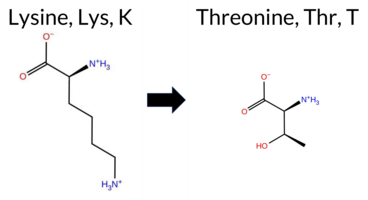 AIThe SynGAP1 missense variant K1135T is listed in ClinVar (ID 1166087.0) with an “Uncertain” status and is present in gnomAD (variant ID 6‑33443956‑A‑C). Prediction tools that agree on a benign effect include REVEL, PROVEAN, polyPhen‑2 (HumDiv and HumVar), SIFT, ESM1b, FATHMM, AlphaMissense‑Optimized, and the SGM‑Consensus (majority vote from AlphaMissense‑Default, ESM1b, FATHMM, PROVEAN). Only AlphaMissense‑Default predicts a pathogenic outcome. High‑accuracy assessments show AlphaMissense‑Optimized as benign and the SGM‑Consensus as likely benign; Foldetta results are unavailable. Overall, the majority of evidence points to a benign impact, and this conclusion does not contradict the ClinVar “Uncertain” classification. Disclaimer: This summary was generated using AI and should be interpreted alongside expert review. | Likely Benign | Conflicting | 2 | 6-33443956-A-C | 1 | 6.75e-7 | -4.778 | Likely Benign | 0.779 | Likely Pathogenic | Likely Benign | 0.210 | Likely Benign | -0.90 | Neutral | 0.411 | Benign | 0.321 | Benign | 5.46 | Benign | 0.10 | Tolerated | 4.32 | 2 | 0 | -1 | 3.2 | -27.07 | |||||||||||||||||||||||||||
| c.1202G>A | R401Q 2D  3DClick to see structure in 3D Viewer AIThe SynGAP1 missense variant R401Q is listed in ClinVar with an “Uncertain” status and is present in gnomAD (ID 6‑33438107‑G‑A). Prediction tools that agree on a benign effect are limited to FATHMM, whereas the majority of algorithms (REVEL, premPS, PROVEAN, polyPhen‑2 HumDiv, polyPhen‑2 HumVar, SIFT, ESM1b, AlphaMissense‑Default, AlphaMissense‑Optimized, and the SGM‑Consensus) predict a pathogenic impact. Uncertain results are reported by FoldX, Rosetta, and Foldetta. High‑accuracy methods reinforce the pathogenic prediction: AlphaMissense‑Optimized scores the variant as pathogenic, the SGM‑Consensus (majority vote of AlphaMissense‑Default, ESM1b, FATHMM, and PROVEAN) indicates “Likely Pathogenic,” and Foldetta’s stability assessment is inconclusive. Overall, the preponderance of evidence points to a pathogenic effect, which does not contradict the current ClinVar “Uncertain” classification. Disclaimer: This summary was generated using AI and should be interpreted alongside expert review. | Likely Pathogenic | C2 | Uncertain | 1 | 6-33438107-G-A | -11.213 | Likely Pathogenic | 0.969 | Likely Pathogenic | Likely Pathogenic | 0.780 | Likely Pathogenic | 0.96 | Ambiguous | 0.1 | 1.50 | Ambiguous | 1.23 | Ambiguous | 1.20 | Destabilizing | -3.69 | Deleterious | 0.999 | Probably Damaging | 0.978 | Probably Damaging | 5.47 | Benign | 0.04 | Affected | 3.38 | 27 | 1 | 1 | 1.0 | -28.06 | |||||||||||||||||||
| c.3397A>G | I1133V 2D  AIThe SynGAP1 missense variant I1133V is listed in ClinVar as Benign (ClinVar ID 999690.0) and is present in the gnomAD database (gnomAD ID 6‑33443949‑A‑G). All evaluated in‑silico predictors classify the change as benign: REVEL, PROVEAN, polyPhen‑2 (HumDiv and HumVar), SIFT, ESM1b, FATHMM, AlphaMissense‑Default, and AlphaMissense‑Optimized. No tool predicts pathogenicity. High‑accuracy assessments reinforce this view: AlphaMissense‑Optimized is benign, and the SGM Consensus (majority vote of AlphaMissense‑Default, ESM1b, FATHMM, and PROVEAN) is Likely Benign. Foldetta results are unavailable. Consequently, the variant is most likely benign, and this prediction aligns with its ClinVar status. Disclaimer: This summary was generated using AI and should be interpreted alongside expert review. | Likely Benign | Benign | 1 | 6-33443949-A-G | 22 | 1.48e-5 | -3.362 | Likely Benign | 0.067 | Likely Benign | Likely Benign | 0.180 | Likely Benign | 0.06 | Neutral | 0.007 | Benign | 0.007 | Benign | 5.47 | Benign | 0.58 | Tolerated | 4.32 | 3 | 4 | 3 | -0.3 | -14.03 | 10.1016/j.ajhg.2020.11.011 | ||||||||||||||||||||||||||
| c.3502A>G | I1168V 2D  AIThe SynGAP1 missense variant I1168V is listed in ClinVar (ID 936001.0) with an “Uncertain” status and is not reported in gnomAD. Functional prediction tools that agree on a benign effect include REVEL, PROVEAN, SIFT, ESM1b, FATHMM, and AlphaMissense‑Optimized. Tools that predict a pathogenic effect are PolyPhen‑2 HumDiv and PolyPhen‑2 HumVar. AlphaMissense‑Default is uncertain, while the SGM‑Consensus (majority vote from AlphaMissense‑Default, ESM1b, FATHMM, PROVEAN) reports a “Likely Benign” outcome. High‑accuracy assessments show AlphaMissense‑Optimized as benign and the SGM‑Consensus as likely benign; Foldetta results are unavailable. Overall, the majority of evidence points to a benign impact, and this consensus does not contradict the ClinVar “Uncertain” classification. Disclaimer: This summary was generated using AI and should be interpreted alongside expert review. | Likely Benign | Uncertain | 1 | -3.263 | Likely Benign | 0.524 | Ambiguous | Likely Benign | 0.363 | Likely Benign | -0.14 | Neutral | 0.876 | Possibly Damaging | 0.643 | Possibly Damaging | 5.47 | Benign | 0.84 | Tolerated | 3.88 | 3 | 4 | 3 | -0.3 | -14.03 | ||||||||||||||||||||||||||||||
| c.703T>C | S235P 2D  3DClick to see structure in 3D Viewer AIThe SynGAP1 missense variant S235P is listed in ClinVar as Pathogenic (ClinVar ID 1067856.0) and is not reported in gnomAD. Prediction tools that agree on a benign effect are polyPhen‑2 HumVar and FATHMM; all other evaluated algorithms—including REVEL, FoldX, Rosetta, Foldetta, premPS, PROVEAN, polyPhen‑2 HumDiv, SIFT, ESM1b, AlphaMissense‑Default, and AlphaMissense‑Optimized—classify the variant as pathogenic. High‑accuracy assessments further support a deleterious impact: AlphaMissense‑Optimized predicts pathogenic; the SGM Consensus (majority vote of AlphaMissense‑Default, ESM1b, FATHMM, PROVEAN) yields a pathogenic verdict; and Foldetta, which integrates FoldX‑MD and Rosetta stability calculations, also reports pathogenic. No predictions or stability results are missing or inconclusive. **Based on the collective predictions, the variant is most likely pathogenic, and this conclusion aligns with its ClinVar status.** Disclaimer: This summary was generated using AI and should be interpreted alongside expert review. | Likely Pathogenic | PH | Likely Pathogenic | 1 | -14.857 | Likely Pathogenic | 0.998 | Likely Pathogenic | Likely Pathogenic | 0.870 | Likely Pathogenic | 4.02 | Destabilizing | 0.1 | 6.91 | Destabilizing | 5.47 | Destabilizing | 1.23 | Destabilizing | -4.24 | Deleterious | 0.917 | Possibly Damaging | 0.446 | Benign | 5.47 | Benign | 0.01 | Affected | 3.40 | 14 | 1 | -1 | -0.8 | 10.04 | 201.5 | 17.0 | 0.1 | 0.0 | -0.6 | 0.0 | X | Potentially Pathogenic | In the WT, the hydroxyl group of Ser235, located in a β-α loop between an anti-parallel β sheet strand (res. Gly227-Phe231) and an α helix (residues Ala236-Val250), forms hydrogen bonds with the GAP domain loop residue Glu680 and with the backbone amide groups of Ala237 and Glu238 from the α helix. In the variant simulations, the pyrrolidine ring of Pro235 cannot stabilize the α helix end or maintain tertiary bonding interactions between the PH and GAP domains via hydrogen bonding as effectively as serine. | |||||||||||
| c.3121C>T | P1041S 2D  AIThe SynGAP1 missense variant P1041S is listed in ClinVar with an “Uncertain” status and is present in gnomAD (ID 6‑33443673‑C‑T). Prediction tools that agree on a benign effect include REVEL, polyPhen‑2 HumVar, SIFT, ESM1b, FATHMM, AlphaMissense‑Default, and AlphaMissense‑Optimized. Tools that predict a pathogenic effect are PROVEAN and polyPhen‑2 HumDiv. The SGM‑Consensus, which aggregates AlphaMissense‑Default, ESM1b, FATHMM, and PROVEAN, reports a “Likely Benign” outcome. High‑accuracy assessments show AlphaMissense‑Optimized as benign and the SGM‑Consensus (majority vote) also as benign; Foldetta results are unavailable. Overall, the majority of evidence points to a benign impact, and this does not contradict the ClinVar “Uncertain” classification. Disclaimer: This summary was generated using AI and should be interpreted alongside expert review. | Likely Benign | Conflicting | 2 | 6-33443673-C-T | 1 | 6.20e-7 | -4.246 | Likely Benign | 0.121 | Likely Benign | Likely Benign | 0.344 | Likely Benign | -2.72 | Deleterious | 0.664 | Possibly Damaging | 0.283 | Benign | 5.48 | Benign | 0.11 | Tolerated | 3.77 | 5 | 1 | -1 | 0.8 | -10.04 | |||||||||||||||||||||||||||
| c.3125A>G | Q1042R 2D 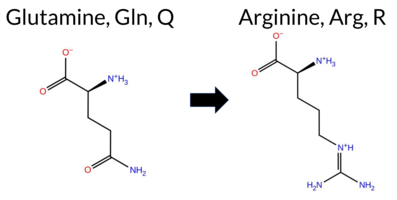 AIThe SynGAP1 missense variant Q1042R is listed in ClinVar (ID 2662705.0) with an “Uncertain” clinical significance and is present in gnomAD (variant ID 6‑33443677‑A‑G). Functional prediction tools largely agree on a benign effect: REVEL, PROVEAN, polyPhen‑2 HumVar, SIFT, ESM1b, FATHMM, and AlphaMissense‑Optimized all classify the change as benign. Only polyPhen‑2 HumDiv predicts a pathogenic outcome, while AlphaMissense‑Default remains uncertain. High‑accuracy assessments reinforce the benign consensus: AlphaMissense‑Optimized reports benign, and the SGM Consensus (majority vote of AlphaMissense‑Default, ESM1b, FATHMM, and PROVEAN) indicates “Likely Benign.” Foldetta results are unavailable. Overall, the majority of evidence supports a benign impact for Q1042R, and this conclusion does not contradict the ClinVar status, which remains uncertain. Disclaimer: This summary was generated using AI and should be interpreted alongside expert review. | Likely Benign | Uncertain | 2 | 6-33443677-A-G | 2 | 1.24e-6 | -2.928 | Likely Benign | 0.413 | Ambiguous | Likely Benign | 0.300 | Likely Benign | -1.39 | Neutral | 0.586 | Possibly Damaging | 0.120 | Benign | 5.48 | Benign | 0.12 | Tolerated | 3.77 | 5 | 1 | 1 | -1.0 | 28.06 | |||||||||||||||||||||||||||
| c.3607C>G | H1203D 2D  AIThe SynGAP1 missense variant H1203D is listed in ClinVar with an “Uncertain” status and is not reported in gnomAD. Functional prediction tools that agree on a benign effect include REVEL, PROVEAN, polyPhen‑2 HumVar, SIFT, ESM1b, FATHMM, AlphaMissense‑Optimized, and the SGM‑Consensus (majority vote from AlphaMissense‑Default, ESM1b, FATHMM, PROVEAN). Only polyPhen‑2 HumDiv predicts a pathogenic outcome, while AlphaMissense‑Default remains uncertain. High‑accuracy assessments show AlphaMissense‑Optimized as benign and the SGM‑Consensus as “Likely Benign”; a Foldetta stability analysis is unavailable. Overall, the majority of evidence points to a benign impact. This conclusion does not contradict the ClinVar designation, which remains uncertain. Disclaimer: This summary was generated using AI and should be interpreted alongside expert review. | Likely Benign | Coiled-coil | Uncertain | 1 | -6.729 | Likely Benign | 0.525 | Ambiguous | Likely Benign | 0.403 | Likely Benign | -1.89 | Neutral | 0.473 | Possibly Damaging | 0.265 | Benign | 5.51 | Benign | 0.24 | Tolerated | 3.77 | 5 | 1 | -1 | -0.3 | -22.05 | |||||||||||||||||||||||||||||
| c.3520G>A | E1174K 2D  AIThe SynGAP1 missense variant E1174K is listed in ClinVar with an uncertain significance (ClinVar ID 1905754.0) and is present in gnomAD (variant ID 6‑33444555‑G‑A). Functional prediction tools that agree on a benign effect include REVEL, PROVEAN, polyPhen‑2 HumVar, ESM1b, and FATHMM, while those that predict a pathogenic outcome are polyPhen‑2 HumDiv, SIFT, and AlphaMissense‑Default. The high‑accuracy consensus from SGM (majority vote of AlphaMissense‑Default, ESM1b, FATHMM, and PROVEAN) yields a “Likely Benign” classification, matching the reported SGM‑Consensus result. AlphaMissense‑Optimized is uncertain, and no Foldetta stability assessment is available. Taken together, the majority of evidence points to a benign effect, and this conclusion does not contradict the ClinVar uncertain status. Disclaimer: This summary was generated using AI and should be interpreted alongside expert review. | Likely Benign | Coiled-coil | Uncertain | 1 | 6-33444555-G-A | 2 | 1.24e-6 | -4.345 | Likely Benign | 0.898 | Likely Pathogenic | Ambiguous | 0.442 | Likely Benign | -1.59 | Neutral | 0.962 | Probably Damaging | 0.367 | Benign | 5.52 | Benign | 0.03 | Affected | 4.32 | 2 | 0 | 1 | -0.4 | -0.94 | ||||||||||||||||||||||||||
| c.3434A>G | N1145S 2D  AIThe SynGAP1 missense variant N1145S is listed in ClinVar with an “Uncertain” status and is present in gnomAD (ID 6‑33444469‑A‑G). Prediction tools that agree on a benign effect include REVEL, PROVEAN, SIFT, ESM1b, FATHMM, AlphaMissense‑Default, AlphaMissense‑Optimized, and the SGM‑Consensus (majority vote from AlphaMissense‑Default, ESM1b, FATHMM, and PROVEAN). In contrast, PolyPhen‑2 (both HumDiv and HumVar models) predict a pathogenic outcome. High‑accuracy assessments show AlphaMissense‑Optimized as benign and the SGM‑Consensus as likely benign; the Foldetta stability analysis is unavailable. Overall, the majority of evidence points to a benign effect, and this conclusion does not contradict the ClinVar “Uncertain” classification. Disclaimer: This summary was generated using AI and should be interpreted alongside expert review. | Likely Benign | Uncertain | 1 | 6-33444469-A-G | 2 | 1.24e-6 | -0.989 | Likely Benign | 0.126 | Likely Benign | Likely Benign | 0.308 | Likely Benign | -1.15 | Neutral | 0.997 | Probably Damaging | 0.989 | Probably Damaging | 5.55 | Benign | 0.89 | Tolerated | 4.32 | 4 | 1 | 1 | 2.7 | -27.03 | |||||||||||||||||||||||||||
| c.3607C>T | H1203Y 2D  AIThe SynGAP1 missense variant H1203Y is listed in ClinVar with an “Uncertain” status and is present in the gnomAD database (ID 6‑33446599‑C‑T). Functional prediction tools uniformly indicate a benign effect: REVEL, PROVEAN, polyPhen‑2 (HumDiv and HumVar), SIFT, ESM1b, FATHMM, AlphaMissense‑Default, and AlphaMissense‑Optimized all score the variant as benign. No tool predicts pathogenicity. High‑accuracy assessments corroborate this: AlphaMissense‑Optimized is benign; the SGM Consensus (majority vote from AlphaMissense‑Default, ESM1b, FATHMM, and PROVEAN) also yields a benign prediction. Foldetta results are unavailable. Overall, the evidence strongly supports a benign impact for H1203Y, and this conclusion does not contradict the ClinVar “Uncertain” classification. Disclaimer: This summary was generated using AI and should be interpreted alongside expert review. | Likely Benign | Coiled-coil | Uncertain | 1 | 6-33446599-C-T | 2 | 1.24e-6 | -6.834 | Likely Benign | 0.149 | Likely Benign | Likely Benign | 0.233 | Likely Benign | -1.52 | Neutral | 0.006 | Benign | 0.011 | Benign | 5.55 | Benign | 0.10 | Tolerated | 3.77 | 5 | 2 | 0 | 1.9 | 26.03 | ||||||||||||||||||||||||||
| c.670A>G | T224A 2D  3DClick to see structure in 3D Viewer AIThe SynGAP1 missense variant T224A is listed in ClinVar with an “Uncertain” status and is present in gnomAD (ID 6‑33435521‑A‑G). Prediction tools that agree on a benign effect include REVEL, FoldX, polyPhen‑2 (HumDiv and HumVar), SIFT, FATHMM, and AlphaMissense‑Optimized. Those that predict a pathogenic effect are PROVEAN and AlphaMissense‑Default. The remaining tools (Rosetta, Foldetta, premPS, ESM1b) return uncertain or inconclusive results. High‑accuracy assessments show AlphaMissense‑Optimized as benign, the SGM Consensus (majority vote from AlphaMissense‑Default, ESM1b, FATHMM, PROVEAN) as pathogenic, and Foldetta as uncertain. Overall, the majority of evidence points to a benign impact, and this conclusion does not contradict the ClinVar “Uncertain” classification. Disclaimer: This summary was generated using AI and should be interpreted alongside expert review. | PH | Uncertain | 3 | 6-33435521-A-G | 2 | 1.24e-6 | -7.379 | In-Between | 0.651 | Likely Pathogenic | Likely Benign | 0.464 | Likely Benign | 0.33 | Likely Benign | 0.1 | 1.05 | Ambiguous | 0.69 | Ambiguous | 0.91 | Ambiguous | -2.96 | Deleterious | 0.243 | Benign | 0.079 | Benign | 5.57 | Benign | 0.57 | Tolerated | 3.41 | 13 | 1 | 0 | 2.5 | -30.03 | 169.0 | 41.4 | -0.5 | 1.1 | -0.4 | 0.0 | X | X | Uncertain | The introduced residue Ala224 is located on the outer surface of an anti-parallel β sheet strand (res. Cys219-Thr224). Unlike the hydroxyl group of the Thr224 side chain in the WT model, the methyl side chain of Ala224 cannot form hydrogen bonds with nearby residues Ser204, Ser226, and Gly227. Without these hydrogen-bonding interactions at the β sheet surface, the secondary structure element becomes unstable and unfolds during the variant simulations. However, since the model ends abruptly at the N-terminus, no definite conclusions can be drawn from the simulations. | ||||||||
| c.3632T>A | M1211K 2D 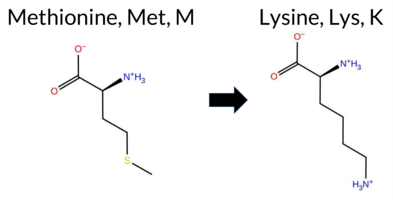 AIThe SynGAP1 missense variant M1211K is listed in ClinVar (ID 834052.0) as benign and is not reported in gnomAD. Functional prediction tools cluster into two groups: benign predictions come from FATHMM and AlphaMissense‑Optimized, while the remaining seven tools—REVEL, PROVEAN, polyPhen‑2 (HumDiv and HumVar), SIFT, ESM1b, and AlphaMissense‑Default—classify the change as pathogenic. High‑accuracy assessments further clarify the picture: AlphaMissense‑Optimized predicts a benign effect, whereas the SGM Consensus (a majority vote of AlphaMissense‑Default, ESM1b, FATHMM, and PROVEAN) indicates a likely pathogenic outcome; Foldetta data are unavailable. Overall, the preponderance of evidence from standard predictors and the SGM Consensus supports a pathogenic interpretation, which contradicts the benign classification reported in ClinVar. Disclaimer: This summary was generated using AI and should be interpreted alongside expert review. | Likely Pathogenic | Coiled-coil | Likely Benign | 1 | -9.013 | Likely Pathogenic | 0.662 | Likely Pathogenic | Likely Benign | 0.595 | Likely Pathogenic | -2.95 | Deleterious | 0.987 | Probably Damaging | 0.979 | Probably Damaging | 5.59 | Benign | 0.01 | Affected | 3.77 | 5 | 0 | -1 | -5.8 | -3.02 | |||||||||||||||||||||||||||||
| c.742C>T | R248W 2D 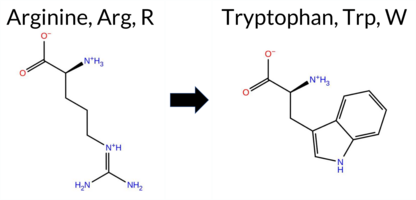 3DClick to see structure in 3D Viewer AISynGAP1 missense variant R248W is listed in ClinVar with an uncertain significance and is not reported in gnomAD. Functional prediction tools cluster into two groups: benign predictions come from Rosetta, Foldetta, and FATHMM, while pathogenic predictions are made by REVEL, PROVEAN, polyPhen‑2 (HumDiv and HumVar), SIFT, ESM1b, AlphaMissense‑Default, AlphaMissense‑Optimized, and the SGM‑Consensus score (Likely Pathogenic). Uncertain results from FoldX and premPS are treated as unavailable. High‑accuracy assessments show AlphaMissense‑Optimized as pathogenic, the SGM‑Consensus (majority vote of AlphaMissense‑Default, ESM1b, FATHMM, PROVEAN) as Likely Pathogenic, and Foldetta (combining FoldX‑MD and Rosetta) as benign. Overall, the majority of evidence points to a pathogenic effect, which does not contradict the ClinVar uncertain status. Disclaimer: This summary was generated using AI and should be interpreted alongside expert review. | Likely Pathogenic | PH | Uncertain | 1 | -11.647 | Likely Pathogenic | 0.991 | Likely Pathogenic | Likely Pathogenic | 0.699 | Likely Pathogenic | 1.17 | Ambiguous | 0.3 | -0.20 | Likely Benign | 0.49 | Likely Benign | 0.89 | Ambiguous | -6.98 | Deleterious | 1.000 | Probably Damaging | 0.948 | Probably Damaging | 5.62 | Benign | 0.00 | Affected | 3.41 | 14 | 2 | -3 | 3.6 | 30.03 | 266.4 | 42.3 | 0.0 | 0.0 | 0.3 | 0.1 | X | Potentially Pathogenic | The guanidinium group of Arg248, located on an α helix (res. Ala236-Val250), forms two very stable salt bridges with Asp255 (from a short α helical section, res. Lys254-Asn256) and Glu244 (from a nearby loop) in the WT simulations. In the variant simulations, the indole group of Trp248 cannot form any salt bridges, which could negatively affect the tertiary structure assembly of the PH domain. Instead, in the variant simulations, the indole ring of Trp248 stacks against Pro252, which makes a turn after the α helix. | |||||||||||
| c.743G>C | R248P 2D  3DClick to see structure in 3D Viewer AIThe SynGAP1 missense variant R248P is listed in ClinVar as Pathogenic (ClinVar ID 1065478.0) and is not reported in gnomAD. Prediction tools that agree on a benign effect include only FATHMM, whereas all other evaluated algorithms (REVEL, FoldX, Rosetta, Foldetta, premPS, PROVEAN, polyPhen‑2 HumDiv, polyPhen‑2 HumVar, SIFT, ESM1b, AlphaMissense‑Default) predict a pathogenic impact. High‑accuracy assessments further support pathogenicity: AlphaMissense‑Optimized returns a pathogenic score, the SGM Consensus (majority vote from AlphaMissense‑Default, ESM1b, FATHMM, PROVEAN) indicates Likely Pathogenic, and Foldetta (combining FoldX‑MD and Rosetta outputs) predicts a destabilizing, pathogenic effect. Based on the overwhelming consensus of pathogenic predictions and the high‑accuracy tool results, the variant is most likely pathogenic, which aligns with its ClinVar status. Disclaimer: This summary was generated using AI and should be interpreted alongside expert review. | Likely Pathogenic | PH | Likely Pathogenic | 1 | -10.751 | Likely Pathogenic | 1.000 | Likely Pathogenic | Likely Pathogenic | 0.848 | Likely Pathogenic | 3.09 | Destabilizing | 0.6 | 8.87 | Destabilizing | 5.98 | Destabilizing | 1.21 | Destabilizing | -5.97 | Deleterious | 0.998 | Probably Damaging | 0.878 | Possibly Damaging | 5.64 | Benign | 0.00 | Affected | 3.41 | 14 | 0 | -2 | 2.9 | -59.07 | 223.8 | 126.6 | 0.0 | 0.0 | -0.2 | 0.1 | X | X | Potentially Pathogenic | The guanidinium group of Arg248, located on an α helix (residues Ala236-Val250), forms two very stable salt bridges with Asp255 (from a short α helical section, res. Lys254-Asn256) and Glu244 (from a nearby loop) in the WT simulations. In the variant simulations, the pyrrolidine side chain of Pro248 cannot form any salt bridges, which could negatively affect the tertiary structure assembly of the PH domain. Additionally, Pro248 lacks a free amide group needed for hydrogen bonding with the backbone carbonyl group of Asn245, disrupting the continuity of the α helix. | ||||||||||
| c.745G>A | A249T 2D  3DClick to see structure in 3D Viewer AISynGAP1 missense variant A249T is listed in ClinVar (ID 1031675.0) with an uncertain significance annotation and is not reported in gnomAD. Functional prediction tools that agree on a benign effect include REVEL, premPS, PROVEAN, SIFT, ESM1b, and FATHMM, whereas polyPhen‑2 HumDiv, polyPhen‑2 HumVar, and AlphaMissense‑Default predict a pathogenic outcome. Predictions that are inconclusive are FoldX, Rosetta, Foldetta, and AlphaMissense‑Optimized. High‑accuracy assessments show AlphaMissense‑Optimized as uncertain, the SGM Consensus (majority vote of AlphaMissense‑Default, ESM1b, FATHMM, PROVEAN) as likely benign, and Foldetta (combining FoldX‑MD and Rosetta) as uncertain. Overall, the balance of evidence favors a benign interpretation, which does not contradict the ClinVar uncertain status. Disclaimer: This summary was generated using AI and should be interpreted alongside expert review. | Likely Benign | PH | Uncertain | 1 | -3.564 | Likely Benign | 0.805 | Likely Pathogenic | Ambiguous | 0.487 | Likely Benign | 1.50 | Ambiguous | 0.6 | 1.39 | Ambiguous | 1.45 | Ambiguous | 0.30 | Likely Benign | -0.96 | Neutral | 0.990 | Probably Damaging | 0.815 | Possibly Damaging | 5.65 | Benign | 0.40 | Tolerated | 3.39 | 15 | 1 | 0 | -2.5 | 30.03 | 214.5 | -43.3 | 0.0 | 0.0 | 0.5 | 0.2 | X | Potentially Benign | The methyl group of Ala249, located on the surface of an α helix (res. Ala236-Val250) facing an anti-parallel β sheet strand (res. Ile205-Val209), packs against nearby hydrophobic residues such as Leu200, Leu246, and Val250. In the variant simulations, the hydroxyl group of Thr249, which is not suitable for hydrophobic packing, forms a stable hydrogen bond with the backbone carbonyl of Asn245 in the same helix. Although this interaction could theoretically weaken the structural integrity of the α helix, this destabilizing effect is not observed in the variant simulations. | |||||||||||
| c.1193C>T | P398L 2D  3DClick to see structure in 3D Viewer AISynGAP1 missense variant P398L (ClinVar ID 2415189.0) is listed as Uncertain in ClinVar and is present in gnomAD (ID 6‑33438098‑C‑T). Functional prediction tools that agree on a benign effect include Foldetta, polyPhen‑2 HumVar, FATHMM, and AlphaMissense‑Optimized. Tools that predict a pathogenic effect are REVEL, PROVEAN, polyPhen‑2 HumDiv, and SIFT. Predictions that are uncertain or inconclusive are FoldX, Rosetta, premPS, ESM1b, and AlphaMissense‑Default. High‑accuracy assessments show AlphaMissense‑Optimized as benign, Foldetta as benign, and the SGM Consensus (majority vote from AlphaMissense‑Default, ESM1b, FATHMM, PROVEAN) is inconclusive. Based on the available predictions, the variant is most likely benign, and this assessment does not contradict the ClinVar status of Uncertain. Disclaimer: This summary was generated using AI and should be interpreted alongside expert review. | C2 | Uncertain | 1 | 6-33438098-C-T | 8 | 4.96e-6 | -7.518 | In-Between | 0.547 | Ambiguous | Likely Benign | 0.599 | Likely Pathogenic | 1.48 | Ambiguous | 0.2 | -0.54 | Ambiguous | 0.47 | Likely Benign | 0.62 | Ambiguous | -7.10 | Deleterious | 0.961 | Probably Damaging | 0.256 | Benign | 5.72 | Benign | 0.01 | Affected | 3.40 | 16 | -3 | -3 | 5.4 | 16.04 | 245.8 | -68.6 | -0.1 | 0.0 | -0.3 | 0.2 | X | Potentially Pathogenic | Pro398 is located in the Gly-rich Ω loop (res. Pro364-Pro398) between two anti-parallel β sheet strands (res. Thr359-Pro364 and res. Ala399-Ile411). The Ω loop is assumed to directly interact with the membrane, and it is observed to move arbitrarily throughout the WT solvent simulations. Although the residue swap does not influence the nearby secondary structure elements, proline is often found at the ends of β sheets due to its disfavored status during folding.Additionally, the Ω loop potentially plays a crucial role in the SynGAP-membrane complex association, stability, and dynamics. However, this aspect cannot be fully addressed through solvent simulations alone. Ω loops are known to play significant roles in protein functions that require flexibility, and thus hydrophobic residues like leucine are rarely tolerated. Although no negative structural effects are visualized in the variant’s simulations, Leu398 may exert drastic effects on the SynGAP-membrane complex dynamics and stability. Since the effects on the Gly-rich Ω loop dynamics can only be well studied through the SynGAP-membrane complex, no definite conclusions can be drawn. | |||||||||
| c.680G>A | G227E 2D  3DClick to see structure in 3D Viewer AIThe SynGAP1 missense variant G227E is listed in ClinVar with an “Uncertain” status and is present in gnomAD (variant ID 6-33435531-G-A). Functional prediction tools largely agree on a deleterious effect: REVEL, FoldX, Rosetta, Foldetta, PROVEAN, polyPhen‑2 (HumDiv), SIFT, ESM1b, AlphaMissense‑Default, and AlphaMissense‑Optimized all report pathogenicity, while only polyPhen‑2 (HumVar) and FATHMM predict a benign outcome; premPS remains inconclusive. High‑accuracy assessments reinforce this trend: AlphaMissense‑Optimized is pathogenic; the SGM Consensus (majority vote of AlphaMissense‑Default, ESM1b, FATHMM, PROVEAN) is “Likely Pathogenic”; and Foldetta, which integrates FoldX‑MD and Rosetta stability calculations, also predicts pathogenicity. Taken together, the overwhelming majority of evidence points to a pathogenic effect. This conclusion is consistent with the ClinVar “Uncertain” classification, which does not contradict the predictive data. Disclaimer: This summary was generated using AI and should be interpreted alongside expert review. | Likely Pathogenic | PH | Conflicting | 2 | 6-33435531-G-A | 3 | 1.86e-6 | -9.186 | Likely Pathogenic | 0.996 | Likely Pathogenic | Likely Pathogenic | 0.792 | Likely Pathogenic | 2.56 | Destabilizing | 0.4 | 5.36 | Destabilizing | 3.96 | Destabilizing | 0.94 | Ambiguous | -6.49 | Deleterious | 0.906 | Possibly Damaging | 0.360 | Benign | 5.72 | Benign | 0.01 | Affected | 3.43 | 12 | 0 | -2 | -3.1 | 72.06 | 237.7 | -112.1 | 0.1 | 0.3 | 0.0 | 0.3 | X | X | Uncertain | The introduced residue Glu227 is located in a β hairpin loop connecting two anti-parallel β sheet strands (res. Cys219-Thr224 and Thr228-Ala232). In the variant simulations, the carboxylate group of Glu227 frequently forms a salt bridge with the amino group of the neighboring residue Lys229. Despite this interaction, the integrity of the secondary structure element is not compromised. However, the β hairpins are potential nucleation sites during the initial stages of protein folding. Additionally, since the model ends abruptly at the N-terminus, no definite conclusions can be drawn from the simulations. | |||||||
| c.667A>G | T223A 2D  3DClick to see structure in 3D Viewer AIThe SynGAP1 missense variant T223A is listed in ClinVar with an “Uncertain” status and is present in the gnomAD database (ID 6‑33435518‑A‑G). Functional prediction tools that agree on a benign effect include FoldX, polyPhen‑2 (HumDiv and HumVar), SIFT, FATHMM, AlphaMissense‑Default, and AlphaMissense‑Optimized. Tools that predict a pathogenic effect are REVEL and PROVEAN. Predictions that are inconclusive are Rosetta, Foldetta, premPS, and ESM1b. High‑accuracy assessments show AlphaMissense‑Optimized as benign; the SGM Consensus (majority vote from AlphaMissense‑Default, ESM1b, FATHMM, and PROVEAN) also resolves to benign; and Foldetta, which integrates FoldX‑MD and Rosetta outputs, remains uncertain. Overall, the majority of evidence points to a benign impact, which does not contradict the ClinVar “Uncertain” classification. Disclaimer: This summary was generated using AI and should be interpreted alongside expert review. | PH | Uncertain | 1 | 6-33435518-A-G | 3 | 1.86e-6 | -7.076 | In-Between | 0.316 | Likely Benign | Likely Benign | 0.574 | Likely Pathogenic | 0.30 | Likely Benign | 0.1 | 0.77 | Ambiguous | 0.54 | Ambiguous | 0.74 | Ambiguous | -3.36 | Deleterious | 0.231 | Benign | 0.058 | Benign | 5.74 | Benign | 0.09 | Tolerated | 3.41 | 13 | 1 | 0 | 2.5 | -30.03 | 186.4 | 44.0 | 0.0 | 0.0 | 0.0 | 0.0 | X | X | Uncertain | The introduced residue Ala223 is located on the outer surface of an anti-parallel β sheet strand (res. Cys219-Thr224). Unlike the hydroxyl group of the Thr223 side chain in the WT protein, the methyl side chain of Ala223 cannot form hydrogen bonds with nearby residues Thr228 and Lys207. Without these hydrogen-bonding interactions at the β sheet surface, the secondary structure element becomes unstable and partially unfolds in the variant simulations. However, since the model ends abruptly at the N-terminus, no definite conclusions can be drawn from the simulations. | ||||||||
| c.700C>T | R234W 2D  3DClick to see structure in 3D Viewer AIThe SynGAP1 R234W missense variant is listed in ClinVar (ID 856396.0) with an “Uncertain” clinical significance and is present in gnomAD (variant ID 6‑33435551‑C‑T). Prediction tools that agree on a benign effect include premPS and FATHMM, whereas the majority of other in‑silico predictors (REVEL, PROVEAN, polyPhen‑2 HumDiv, polyPhen‑2 HumVar, SIFT, ESM1b, AlphaMissense‑Default, and the SGM‑Consensus) indicate a pathogenic impact. High‑accuracy assessments show AlphaMissense‑Optimized as “Uncertain”; the SGM‑Consensus, derived from a majority vote of AlphaMissense‑Default, ESM1b, FATHMM, and PROVEAN, is “Pathogenic”; and Foldetta, which integrates FoldX‑MD and Rosetta outputs, is “Uncertain.” Overall, the preponderance of evidence points to a pathogenic effect, which is consistent with the ClinVar designation of uncertainty rather than a benign classification. Disclaimer: This summary was generated using AI and should be interpreted alongside expert review. | Likely Pathogenic | PH | Uncertain | 1 | 6-33435551-C-T | 3 | 1.86e-6 | -12.625 | Likely Pathogenic | 0.947 | Likely Pathogenic | Ambiguous | 0.805 | Likely Pathogenic | 0.96 | Ambiguous | 0.3 | 0.69 | Ambiguous | 0.83 | Ambiguous | 0.13 | Likely Benign | -5.52 | Deleterious | 0.997 | Probably Damaging | 0.803 | Possibly Damaging | 5.76 | Benign | 0.01 | Affected | 3.40 | 14 | 2 | -3 | 3.6 | 30.03 | 262.8 | 39.6 | -0.1 | 0.0 | -0.2 | 0.2 | X | Potentially Pathogenic | The guanidinium group of Arg234, located in a β-α loop between an anti-parallel β sheet strand (residues Gly227-Phe231) and an α helix (res. Ala236-Val250), forms a salt bridge with the carboxylate group of Glu238 in the α helix. Occasionally, it also bonds with the GAP domain residues Ser678 and Glu680. Thus, the positively charged Arg234 could contribute to the tertiary structure assembly between the PH and GAP domains. In contrast, the indole side chain of Trp234 in the variant is located on the protein surface in the variant simulations and is unable to form any interactions. | ||||||||
| c.775C>T | R259W 2D  3DClick to see structure in 3D Viewer AISynGAP1 missense variant R259W is listed in ClinVar with an uncertain significance (ClinVar ID 2014570.0) and is not reported in gnomAD. Functional prediction tools that agree on a benign effect are limited to FATHMM, whereas the remaining evaluated algorithms—REVEL, PROVEAN, polyPhen‑2 (HumDiv and HumVar), SIFT, ESM1b, AlphaMissense‑Default, AlphaMissense‑Optimized, and the SGM‑Consensus—consistently predict a pathogenic impact. Uncertain results are reported by FoldX, Rosetta, Foldetta, and premPS. High‑accuracy assessments further support pathogenicity: AlphaMissense‑Optimized is pathogenic; the SGM‑Consensus, derived from a majority vote of AlphaMissense‑Default, ESM1b, FATHMM, and PROVEAN, is pathogenic; and Foldetta, which integrates FoldX‑MD and Rosetta stability calculations, remains inconclusive. Overall, the preponderance of evidence indicates that R259W is most likely pathogenic, a conclusion that does not contradict the current ClinVar status of uncertain significance. Disclaimer: This summary was generated using AI and should be interpreted alongside expert review. | Likely Pathogenic | C2 | Uncertain | 1 | -12.186 | Likely Pathogenic | 0.985 | Likely Pathogenic | Likely Pathogenic | 0.691 | Likely Pathogenic | 1.95 | Ambiguous | 0.8 | 0.51 | Ambiguous | 1.23 | Ambiguous | 0.51 | Ambiguous | -7.35 | Deleterious | 1.000 | Probably Damaging | 0.993 | Probably Damaging | 5.76 | Benign | 0.00 | Affected | 3.39 | 15 | 2 | -3 | 3.6 | 30.03 | 254.0 | 40.0 | 0.2 | 0.2 | 0.2 | 0.4 | X | X | X | Potentially Pathogenic | The guanidinium group of Arg259, located at the beginning of an anti-parallel β sheet strand (res. Arg259-Arg272), forms salt bridges with the carboxylate groups of Asp684 at the end of an α helix (res. Ile683-Gln702, GAP domain) and Asp261 on the same β strand. The Arg259 side chain also frequently forms hydrogen bonds with the backbone carbonyl groups of Ser257, Asn256, and Asp255. In the variant simulations, the indole ring of the Trp259 side chain cannot form salt bridges or maintain hydrogen bonding with the carboxylate group of Asp684 or other nearby residues. Notably, the amino group of the Lys254 side chain maintains a salt bridge with Asp684 and Glu244 throughout the variant simulations, while it forms a cation-π bond with the indole ring of Trp259 in the variant. This salt bridge is not maintained in the WT simulations. Additionally, the partially or loosely α helical conformation of a lysine-containing loop (res. Lys251-Ser257), which extends to a nearby α helix (res. Met414-Asn426), could be stabilized due to the residue swap. Moreover, the bulky size of the Trp259 side chain requires nearby residues to adjust their positioning to accommodate the introduced residue, weakening the tertiary structure assembly between the C2, PH, and GAP domains. The residue swap potentially causes more severe effects during protein folding or for the SynGAP-membrane interaction than the solvent-only simulations imply. | |||||||||
| c.772C>T | R258C 2D  3DClick to see structure in 3D Viewer AIThe SynGAP1 R258C missense variant is listed in ClinVar with an “Uncertain” status and is present in gnomAD (variant ID 6‑33437677‑C‑T). Prediction tools that agree on a benign effect include only FATHMM. All other evaluated predictors—REVEL, PROVEAN, polyPhen‑2 (HumDiv and HumVar), SIFT, ESM1b, AlphaMissense‑Default, and the SGM‑Consensus (majority vote of AlphaMissense‑Default, ESM1b, FATHMM, PROVEAN)—indicate a pathogenic or likely pathogenic impact. High‑accuracy assessments show AlphaMissense‑Optimized as uncertain, the SGM‑Consensus as likely pathogenic, and Foldetta (combining FoldX‑MD and Rosetta outputs) as uncertain. Based on the preponderance of pathogenic predictions, the variant is most likely pathogenic, which does not contradict its current ClinVar “Uncertain” classification. Disclaimer: This summary was generated using AI and should be interpreted alongside expert review. | Likely Pathogenic | C2 | Uncertain | 1 | 6-33437677-C-T | 1 | 6.20e-7 | -10.285 | Likely Pathogenic | 0.790 | Likely Pathogenic | Ambiguous | 0.771 | Likely Pathogenic | 1.17 | Ambiguous | 0.4 | 1.76 | Ambiguous | 1.47 | Ambiguous | 0.87 | Ambiguous | -6.79 | Deleterious | 1.000 | Probably Damaging | 0.993 | Probably Damaging | 5.77 | Benign | 0.00 | Affected | 3.39 | 15 | -3 | -4 | 7.0 | -53.05 | |||||||||||||||||
| c.773G>A | R258H 2D 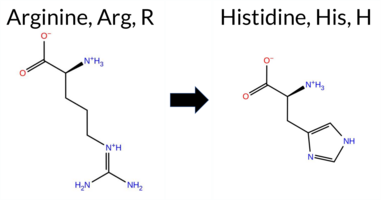 3DClick to see structure in 3D Viewer AISynGAP1 missense variant R258H is listed as Benign in ClinVar (ID 949697.0) and is present in gnomAD (6‑33437678‑G‑A). Prediction tools that agree on a benign effect include FATHMM and AlphaMissense‑Optimized. Those that predict a pathogenic effect are REVEL, premPS, PROVEAN, polyPhen‑2 (HumDiv and HumVar), SIFT, and ESM1b. Uncertain calls come from FoldX, Rosetta, Foldetta, and AlphaMissense‑Default. The high‑accuracy consensus (SGM) derived from AlphaMissense‑Default, ESM1b, FATHMM, and PROVEAN yields a pathogenic verdict. AlphaMissense‑Optimized remains benign, while Foldetta is inconclusive. Overall, the majority of evidence points to a pathogenic impact, which contradicts the ClinVar benign classification. Disclaimer: This summary was generated using AI and should be interpreted alongside expert review. | C2 | Benign/Likely benign | 3 | 6-33437678-G-A | 10 | 6.20e-6 | -10.533 | Likely Pathogenic | 0.525 | Ambiguous | Likely Benign | 0.830 | Likely Pathogenic | 1.60 | Ambiguous | 0.6 | 1.00 | Ambiguous | 1.30 | Ambiguous | 1.47 | Destabilizing | -4.06 | Deleterious | 1.000 | Probably Damaging | 0.991 | Probably Damaging | 5.77 | Benign | 0.01 | Affected | 3.39 | 15 | 2 | 0 | 1.3 | -19.05 | 212.5 | 81.8 | 0.1 | 0.0 | -0.5 | 0.2 | X | Potentially Pathogenic | The guanidinium group of Arg258, located at the end of an α-β loop connecting the PH domain to the C2 domain (res. Lys251-Arg258), forms hydrogen bonds with the carboxamide groups of Asn727 and Asn729 side chains, as well as with the backbone carbonyl groups of Ala724, Leu725, and Asn727 in the WT simulations. Although the imidazole group of His258 can act as a hydrogen bond donor/acceptor, the swapped residue is unable to maintain an equally well-coordinated hydrogen bond network for linking the C2 and GAP domains in the variant simulations. | |||||||||
| c.662A>G | E221G 2D 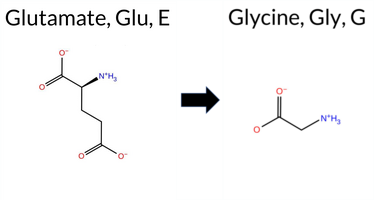 3DClick to see structure in 3D Viewer AIThe SynGAP1 E221G missense variant is listed in ClinVar with an “Uncertain” status and is not reported in gnomAD. Prediction tools that agree on a benign effect include polyPhen‑2 HumVar and FATHMM, while the majority of other in silico predictors (REVEL, PROVEAN, polyPhen‑2 HumDiv, SIFT, ESM1b, AlphaMissense‑Default, AlphaMissense‑Optimized, and the SGM‑Consensus) indicate a pathogenic impact; FoldX, Rosetta, Foldetta, and premPS are inconclusive. High‑accuracy assessments show AlphaMissense‑Optimized as pathogenic, the SGM‑Consensus (majority vote of AlphaMissense‑Default, ESM1b, FATHMM, PROVEAN) as pathogenic, and Foldetta as uncertain. Based on the collective evidence, the variant is most likely pathogenic, which does not contradict the ClinVar “Uncertain” classification. Disclaimer: This summary was generated using AI and should be interpreted alongside expert review. | Likely Pathogenic | PH | Uncertain | 1 | -12.221 | Likely Pathogenic | 0.992 | Likely Pathogenic | Likely Pathogenic | 0.863 | Likely Pathogenic | 1.40 | Ambiguous | 0.1 | 1.74 | Ambiguous | 1.57 | Ambiguous | 0.71 | Ambiguous | -5.56 | Deleterious | 0.596 | Possibly Damaging | 0.201 | Benign | 5.79 | Benign | 0.00 | Affected | 0 | -2 | 3.1 | -72.06 | ||||||||||||||||||||||
| c.707C>T | A236V 2D  3DClick to see structure in 3D Viewer AISynGAP1 missense variant A236V is listed in ClinVar as Benign (ID 469162.0) and is present in gnomAD (6‑33435558‑C‑T). Prediction tools that report benign include polyPhen‑2 HumVar, FATHMM, AlphaMissense‑Default, and AlphaMissense‑Optimized. Tools that predict pathogenicity are REVEL, PROVEAN, polyPhen‑2 HumDiv, SIFT, and ESM1b. Four tools give uncertain or inconclusive results: FoldX, Rosetta, Foldetta, and premPS. The SGM Consensus, derived from a majority vote of AlphaMissense‑Default, ESM1b, FATHMM, and PROVEAN, is inconclusive because the votes are evenly split. High‑accuracy assessments show AlphaMissense‑Optimized as benign, Foldetta as uncertain, and the SGM Consensus as unavailable. Consequently, the overall prediction profile is mixed, but the most reliable high‑accuracy evidence points toward a benign effect. Therefore, the variant is most likely benign, which aligns with its ClinVar classification and does not contradict the reported status. Disclaimer: This summary was generated using AI and should be interpreted alongside expert review. | PH | Benign/Likely benign | 2 | 6-33435558-C-T | 6 | 3.72e-6 | -8.752 | Likely Pathogenic | 0.267 | Likely Benign | Likely Benign | 0.777 | Likely Pathogenic | 0.61 | Ambiguous | 0.2 | 1.08 | Ambiguous | 0.85 | Ambiguous | 0.64 | Ambiguous | -3.55 | Deleterious | 0.981 | Probably Damaging | 0.446 | Benign | 5.79 | Benign | 0.03 | Affected | 3.40 | 14 | 0 | 0 | 2.4 | 28.05 | 213.8 | -44.7 | 0.0 | 0.0 | -0.2 | 0.2 | X | Potentially Benign | The methyl side chain of Ala236, located on an α helix (residues Ala236-Val250) facing an anti-parallel β sheet strand (residues Ile205-Val209), interacts hydrophobically with nearby residues such as Arg239 and Phe218. In the variant simulations, the isopropyl branched hydrocarbon side chain of Val236 maintains similar hydrophobic interactions as alanine in the WT, with an overall arrangement remarkably similar to Ala236. The residue swap does not affect the protein structure based on the simulations. | |||||||||
| c.719A>G | D240G 2D 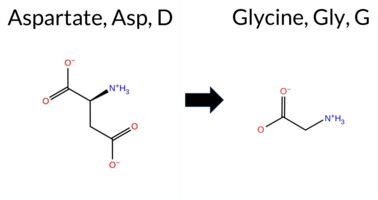 AIThe SynGAP1 missense variant D240G is listed in ClinVar with an uncertain significance and is not reported in gnomAD. Benign predictions are provided by premPS and FATHMM, whereas pathogenic predictions are made by REVEL, Rosetta, PROVEAN, polyPhen‑2 HumDiv, polyPhen‑2 HumVar, SIFT, ESM1b, AlphaMissense‑Default, the SGM Consensus (majority vote of AlphaMissense‑Default, ESM1b, FATHMM, PROVEAN), and Foldetta. FoldX‑MD is inconclusive, and AlphaMissense‑Optimized is uncertain. High‑accuracy methods show that AlphaMissense‑Optimized is inconclusive, SGM Consensus predicts pathogenic, and Foldetta predicts pathogenic. Overall, the majority of evidence points to a pathogenic effect, which is consistent with the ClinVar uncertain status and does not contradict it. Disclaimer: This summary was generated using AI and should be interpreted alongside expert review. | Likely Pathogenic | PH | Uncertain | 1 | -12.825 | Likely Pathogenic | 0.951 | Likely Pathogenic | Ambiguous | 0.912 | Likely Pathogenic | 1.85 | Ambiguous | 0.1 | 2.72 | Destabilizing | 2.29 | Destabilizing | 0.24 | Likely Benign | -6.19 | Deleterious | 0.993 | Probably Damaging | 0.984 | Probably Damaging | 5.79 | Benign | 0.01 | Affected | 1 | -1 | 3.1 | -58.04 | ||||||||||||||||||||||
| c.667A>T | T223S 2D  3DClick to see structure in 3D Viewer AISynGAP1 T223S is listed in ClinVar as a variant of uncertain significance and is present in the gnomAD database (ID 6‑33435518‑A‑T). Functional prediction tools that reach consensus classify the variant as benign: FoldX, Foldetta, polyPhen‑2 HumDiv, polyPhen‑2 HumVar, FATHMM, and AlphaMissense‑Optimized. Tools that predict pathogenicity include REVEL, PROVEAN, and SIFT. Predictions that are inconclusive or uncertain are Rosetta, premPS, AlphaMissense‑Default, and ESM1b. High‑accuracy assessments further support a benign outcome: AlphaMissense‑Optimized is benign, Foldetta is benign, while the SGM Consensus (derived from AlphaMissense‑Default, ESM1b, FATHMM, and PROVEAN) is inconclusive due to a 1‑to‑1 split between benign and pathogenic calls. Overall, the majority of evidence points to a benign effect, which does not contradict the ClinVar designation of uncertain significance. Disclaimer: This summary was generated using AI and should be interpreted alongside expert review. | PH | Conflicting | 2 | 6-33435518-A-T | 3 | 1.86e-6 | -7.714 | In-Between | 0.410 | Ambiguous | Likely Benign | 0.535 | Likely Pathogenic | 0.26 | Likely Benign | 0.1 | 0.50 | Ambiguous | 0.38 | Likely Benign | 0.62 | Ambiguous | -2.86 | Deleterious | 0.421 | Benign | 0.058 | Benign | 5.80 | Benign | 0.02 | Affected | 3.41 | 13 | 1 | 1 | -0.1 | -14.03 | 200.7 | 17.3 | -0.2 | 0.2 | 0.0 | 0.0 | X | Uncertain | The introduced residue Ser223 is located on the outer surface of an anti-parallel β sheet strand (res. Cys219-Thr224). Its hydroxyl group forms hydrogen bonds with nearby residues Thr228 and Lys207 in the variant simulations, similar to the hydroxyl group of Thr223 in the WT simulations. These hydrogen-bonding interactions at the β sheet surface contribute to the stability of the secondary structure element and may prevent it from unfolding. However, since the model ends abruptly at the N-terminus, no definite conclusions can be drawn from the simulations. | |||||||||
| c.694G>A | A232T 2D  3DClick to see structure in 3D Viewer AIThe SynGAP1 missense variant A232T is listed in ClinVar as Benign (ClinVar ID 1165963.0) and is present in gnomAD (ID 6‑33435545‑G‑A). Prediction tools that agree on a benign effect include REVEL, FoldX, Rosetta, Foldetta, PROVEAN, polyPhen‑2 HumVar, SIFT, and FATHMM. Those that predict a pathogenic effect are polyPhen‑2 HumDiv and AlphaMissense‑Default. Predictions that are inconclusive are premPS, ESM1b, and AlphaMissense‑Optimized. High‑accuracy assessments show AlphaMissense‑Optimized as Uncertain; the SGM Consensus (majority vote from AlphaMissense‑Default, ESM1b, FATHMM, PROVEAN) resolves to Benign, and Foldetta (combining FoldX‑MD and Rosetta outputs) also reports Benign. Overall, the majority of evidence supports a benign impact, which is consistent with the ClinVar classification and does not contradict it. Disclaimer: This summary was generated using AI and should be interpreted alongside expert review. | PH | Benign | 1 | 6-33435545-G-A | 1 | 6.20e-7 | -7.655 | In-Between | 0.874 | Likely Pathogenic | Ambiguous | 0.469 | Likely Benign | 0.47 | Likely Benign | 0.1 | -0.04 | Likely Benign | 0.22 | Likely Benign | 0.61 | Ambiguous | -1.42 | Neutral | 0.608 | Possibly Damaging | 0.240 | Benign | 5.80 | Benign | 0.09 | Tolerated | 3.40 | 14 | 1 | 0 | -2.5 | 30.03 | 210.8 | -42.0 | 0.5 | 0.1 | 0.4 | 0.5 | X | Uncertain | The hydroxyl group of Thr232, located at the end of an anti-parallel β sheet strand (res. Thr228-Ala232), forms hydrogen bonds with nearby residues Glu217, Cys233, and Cys219 in the variant simulations. These hydrogen-bonding interactions at the β sheet surface contribute to the stability of the secondary structure element and prevent it from unfolding. The new hydrogen bond interactions may be more favorable for structural stability than the steric interactions of the methyl side chain of Ala with the side chains of Gln216 and Cys219 in the WT. However, since the model ends abruptly at the N-terminus, no definite conclusions can be drawn from the simulations. | |||||||||
| c.662A>T | E221V 2D 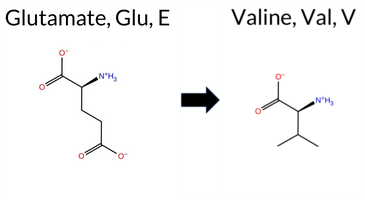 3DClick to see structure in 3D Viewer AIThe SynGAP1 E221V missense variant is reported in ClinVar as Pathogenic (ClinVar ID 2413181.0) and is not found in gnomAD. Functional prediction tools largely agree on a deleterious effect: pathogenic calls come from REVEL, PROVEAN, polyPhen‑2 HumDiv, SIFT, ESM1b, AlphaMissense‑Default, AlphaMissense‑Optimized, and the SGM‑Consensus (majority vote). Benign predictions are limited to premPS, polyPhen‑2 HumVar, and FATHMM. Uncertain results are reported by FoldX, Rosetta, and Foldetta. High‑accuracy assessments reinforce the pathogenic interpretation: AlphaMissense‑Optimized predicts Pathogenic, the SGM‑Consensus also indicates Likely Pathogenic, while Foldetta remains Uncertain. Taken together, the preponderance of evidence supports a pathogenic effect for E221V, and this conclusion aligns with the ClinVar classification, showing no contradiction. Disclaimer: This summary was generated using AI and should be interpreted alongside expert review. | Likely Pathogenic | PH | Likely Pathogenic | 1 | -14.954 | Likely Pathogenic | 0.987 | Likely Pathogenic | Likely Pathogenic | 0.875 | Likely Pathogenic | -0.66 | Ambiguous | 0.2 | -0.89 | Ambiguous | -0.78 | Ambiguous | 0.49 | Likely Benign | -5.54 | Deleterious | 0.596 | Possibly Damaging | 0.203 | Benign | 5.86 | Benign | 0.00 | Affected | 3.41 | 13 | -2 | -2 | 7.7 | -29.98 | 234.5 | 50.6 | 0.0 | 0.0 | -0.4 | 0.2 | X | Uncertain | The introduced residue Val221 is located on the outer surface of an anti-parallel β sheet strand (res. Cys219-Thr224). Unlike the carboxylate group of Glu221, Val221 cannot form hydrogen bonds with Thr223 or a salt bridge with the amino group of the Lys207 side chain. Despite this, the WT simulations containing Glu221 do not show significant differences compared to the variant simulations. However, since the model ends abruptly at the N-terminus, no definite conclusions can be drawn from the simulations. | |||||||||||
| c.767A>G | N256S 2D  3DClick to see structure in 3D Viewer AISynGAP1 missense variant N256S is listed in ClinVar as Pathogenic (ClinVar ID 2584352.0) and is not reported in gnomAD. Functional prediction tools show a split: benign calls come from FoldX, Rosetta, Foldetta, premPS, and FATHMM, while pathogenic calls come from SGM‑Consensus, REVEL, PROVEAN, polyPhen‑2 (HumDiv and HumVar), SIFT, ESM1b, and AlphaMissense‑Default. The high‑accuracy subset gives AlphaMissense‑Optimized as Uncertain, SGM‑Consensus (majority vote of AlphaMissense‑Default, ESM1b, FATHMM, PROVEAN) as Pathogenic, and Foldetta (combining FoldX‑MD and Rosetta outputs) as Benign. Overall, the majority of predictions support a pathogenic effect, aligning with the ClinVar classification. Therefore, the variant is most likely pathogenic, and this assessment does not contradict the ClinVar status. Disclaimer: This summary was generated using AI and should be interpreted alongside expert review. | Likely Pathogenic | C2 | Likely Pathogenic | 1 | -10.640 | Likely Pathogenic | 0.950 | Likely Pathogenic | Ambiguous | 0.707 | Likely Pathogenic | 0.31 | Likely Benign | 0.2 | 0.36 | Likely Benign | 0.34 | Likely Benign | 0.48 | Likely Benign | -4.33 | Deleterious | 0.997 | Probably Damaging | 0.970 | Probably Damaging | 5.87 | Benign | 0.02 | Affected | 3.39 | 15 | 1 | 1 | 2.7 | -27.03 | ||||||||||||||||||||
| c.718G>A | D240N 2D 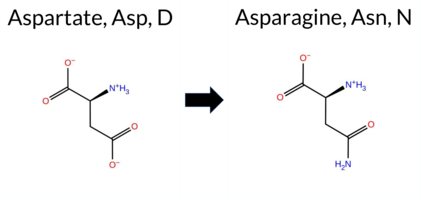 AIThe SynGAP1 missense variant D240N is listed in ClinVar with an uncertain significance and is not reported in gnomAD. Benign predictions are provided by FoldX, Rosetta, Foldetta, premPS, FATHMM, and AlphaMissense‑Optimized, whereas pathogenic predictions come from REVEL, PROVEAN, polyPhen‑2 (HumDiv and HumVar), SIFT, ESM1b, AlphaMissense‑Default, and the SGM‑Consensus. High‑accuracy methods give a split: AlphaMissense‑Optimized predicts benign, SGM‑Consensus predicts pathogenic, and Foldetta predicts benign. Overall, the majority of tools favor a benign effect, and this consensus does not contradict the ClinVar uncertain status. Thus, the variant is most likely benign based on current computational predictions. Disclaimer: This summary was generated using AI and should be interpreted alongside expert review. | Likely Pathogenic | PH | Uncertain | 1 | -12.942 | Likely Pathogenic | 0.755 | Likely Pathogenic | Likely Benign | 0.701 | Likely Pathogenic | 0.22 | Likely Benign | 0.9 | 0.47 | Likely Benign | 0.35 | Likely Benign | 0.37 | Likely Benign | -4.37 | Deleterious | 0.993 | Probably Damaging | 0.984 | Probably Damaging | 5.88 | Benign | 0.01 | Affected | 2 | 1 | 0.0 | -0.98 | ||||||||||||||||||||||
| c.762G>C | K254N 2D  3DClick to see structure in 3D Viewer AISynGAP1 missense variant K254N is listed in ClinVar with an uncertain significance and is not reported in gnomAD. Functional prediction tools that classify the variant as benign include polyPhen‑2 HumDiv, polyPhen‑2 HumVar, and FATHMM. The majority of other in silico predictors—REVEL, premPS, PROVEAN, SIFT, ESM1b, AlphaMissense‑Default, AlphaMissense‑Optimized, and the SGM‑Consensus (majority vote of AlphaMissense‑Default, ESM1b, FATHMM, PROVEAN)—indicate a pathogenic effect. Stability‑based methods FoldX, Rosetta, and Foldetta returned uncertain results and are therefore not considered evidence for or against pathogenicity. High‑accuracy assessments show AlphaMissense‑Optimized as pathogenic, the SGM‑Consensus as likely pathogenic, and Foldetta as unavailable. Overall, the preponderance of evidence supports a pathogenic classification, which contradicts the current ClinVar uncertain status. Disclaimer: This summary was generated using AI and should be interpreted alongside expert review. | Likely Pathogenic | PH | Uncertain | 1 | -13.306 | Likely Pathogenic | 0.999 | Likely Pathogenic | Likely Pathogenic | 0.757 | Likely Pathogenic | 0.73 | Ambiguous | 0.2 | 1.87 | Ambiguous | 1.30 | Ambiguous | 1.19 | Destabilizing | -4.23 | Deleterious | 0.384 | Benign | 0.070 | Benign | 5.93 | Benign | 0.01 | Affected | 3.39 | 15 | 1 | 0 | 0.4 | -14.07 | 215.3 | -21.0 | -1.0 | 1.7 | 0.2 | 0.3 | X | Potentially Pathogenic | The amino group of Lys254, located in an α-β loop connecting the PH and C2 domains (res. Lys251-Arg258), forms salt bridges with the carboxylate groups of Glu244 and Asp684. Since the neutral carboxamide group of the Asn254 side chain cannot form salt bridges with acidic residues, the residue swap potentially weakens the tertiary structure assembly and/or influences the loop positioning. Regardless, in both the variant and WT simulations, all hydrogen bonds formed by the residue’s side chain were broken, and the residue rotated outwards. The partially α helical conformation of the loop, which extends to a nearby α helix (res. Met414-Asn426), is dynamic, making it unclear if the mutation affects it. | |||||||||||
| c.3361A>G | S1121G 2D  AIThe SynGAP1 missense variant S1121G is listed in ClinVar with an “Uncertain” status and is present in gnomAD (ID 6‑33443913‑A‑G). Prediction tools that agree on a benign effect include REVEL, PROVEAN, polyPhen‑2 (HumDiv and HumVar), ESM1b, FATHMM, AlphaMissense‑Default, AlphaMissense‑Optimized, and the SGM‑Consensus score (Likely Benign). Only SIFT predicts a pathogenic outcome. High‑accuracy assessments further support a benign classification: AlphaMissense‑Optimized is benign, and the SGM‑Consensus (derived from the majority vote of AlphaMissense‑Default, ESM1b, FATHMM, and PROVEAN) is also benign. Foldetta results are not available. Overall, the preponderance of evidence indicates that the variant is most likely benign, which does not contradict the current ClinVar “Uncertain” designation. Disclaimer: This summary was generated using AI and should be interpreted alongside expert review. | Likely Benign | Uncertain | 1 | 6-33443913-A-G | 1 | 7.00e-7 | -1.220 | Likely Benign | 0.054 | Likely Benign | Likely Benign | 0.067 | Likely Benign | -0.53 | Neutral | 0.003 | Benign | 0.004 | Benign | 6.63 | Benign | 0.00 | Affected | 3.77 | 5 | 0 | 1 | 0.4 | -30.03 | |||||||||||||||||||||||||||
Found 757 rows. Show 200 rows per page. Page 4/4 « Previous |